CH7_Story
CH7 Story
My theology
One of the epiphanies I had a few years back was to realize that God needs nothing from us. He doesn't need us to do something to expiate our sins, he doesn't need our love, our loyalty, our doing good deeds or anything. He is complete within Himself. God is love and he created us and the universe as an act of love and the commandments are for our good. The crucifixion was for us to grasp his unconditional love. Doing good deeds is for us. It was a new way of thinking for me to realize that all things were and are done for us out of God's love, including the passion and crucifixion and the resurrection of the Christ. Consequently, my theology is Christology.
My challenge is not one of believing in God, Saint Thomas Aquinas gives a logic and reasoning path that is quite enough for me; as discussed in Chapter 1. My challenge also is not one of believing that the Bible story of events are true; with the emphasis on stories. The stories in the Bible are not history, they are stories intended to teach. The challenge that God has in communicating His principles to us is immense; I talked about the analogy of us trying to communicate the principles of geometry to an earthworm in Chapter 3. Therein lies the rub. We cannot grasp God's ways; we must have faith.
One challenge is original sin. The bible story is that Adam ate the forbidden fruit and that original sin got all mankind thrown out of the Garden of Eden and doomed to work for their sustenance all of their life (which was shortened from eternal to mortal). I view original sin as just that we are naturally wired (perhaps part of our survival instinct in our DNA) for pride. Envy and Lust and likely all seven deadly sins, including that most pervasive and destructive of all, scapegoating, all come from pride. It is also worth noting that pride and envy can be the forces that drive us and thus drive progress. So why not wire us differently. Well, that would negate free will and that leads to the second challenge. I discussed in Chapter 5 the question of why do the evil things occur in the world to people who do not deserve them? Is it that we only see a few pixels in an infinite pixel universe? Is it that our time frame is infinitesimal amidst an infinite time span? Or is it that these things are needed to provide an opportunity for us to respond with love? Or all three. But the vast majority of evil that occurs in the world we bring upon ourselves. When we turn away from God, he does not punish us. He allows us to forsake the principles that come from loving one another that allowed us to progress and prosper. When greed, envy and lust take over we lose healthy competition and we regress and have hard times. This cycle has been repeated over and over throughout history. If God punishes us, it is by giving us free will!
_I stated that my theology was Christology. What does that mean? Christology is the belief that Jesus came as the perfect example. Everything we do should be weighed against what Jesus would do. We can learn what he would do by studying the scriptures and learning Jesus' way of thinking, His way of responding to people, His willingness to have a relationship with each one of us. Jesus took this to the level of even giving His life to show us God's unconditional love for us and the reality of the promise of eternal life. We need Him to be the center of our life. Amen
As we settled into Albany, this was the time when our children were growing into adults. Mark had just graduated from high school in Colorado and we would go to a graduation every year for the next three years. So, this chapter will have a lot of events in our children's lives. Also In 1981 I purchased a Nikon FE 35mm camera and so we began to take fewer home movies and more photographs.
The house on Meadow Wood had been empty for over a year and our furniture and stuff was waiting in storage; so, the move in went fairly quickly. The owner had hauled off the outdoor gas barbecue so he had to bring it back; he just dumped it in the garage. He also left his riding lawn mower that was part of the deal. Birdie bought drapes and curtains and we settled in for a stay that would be much longer than either of us could have imagined. The neighborhood looked a bit different back then.
“CH7_V26_neighborhood.mp4” could not be found.
Even though we had gotten a good deal on the house price, we had still extended ourselves so much that Birdie needed to go to work. Plus, David always had fantasies of being a latch key kid! Any way Birdie applied at HP and got a job in calculator assembly. She had several experiences, some of which I did not help. For one thing, her supervisor was determined to show Birdie that I had no influence as far as she was concerned. Secondly, I knew how HP was supposed to operate and I made suggestions that turned out to only antagonize the supervisor and the next level (or two) of management that was weak and incompetent and dared not cross the supervisor. They gave Birdie the meanest of jobs (making battery packs or packaging) and when she excelled in these, they would not recognize it and gave her poor performance reviews. She lasted two years. She continued to supplement by providing day care for little tykes. No one was ever better at loving and taking care of little children.
The main advantage and significant motivation for us to come back to Oregon was family. Our parents were getting old. The family get togethers at Lepperts were memorable and in 1977 we had the 60th birthday of Grandpa Leppert.
“CH7_V2.mp4” could not be found.
At a later time, Grandpa's 70th, Birdie and I made him a carrot cake (Grandpa loved carrots).
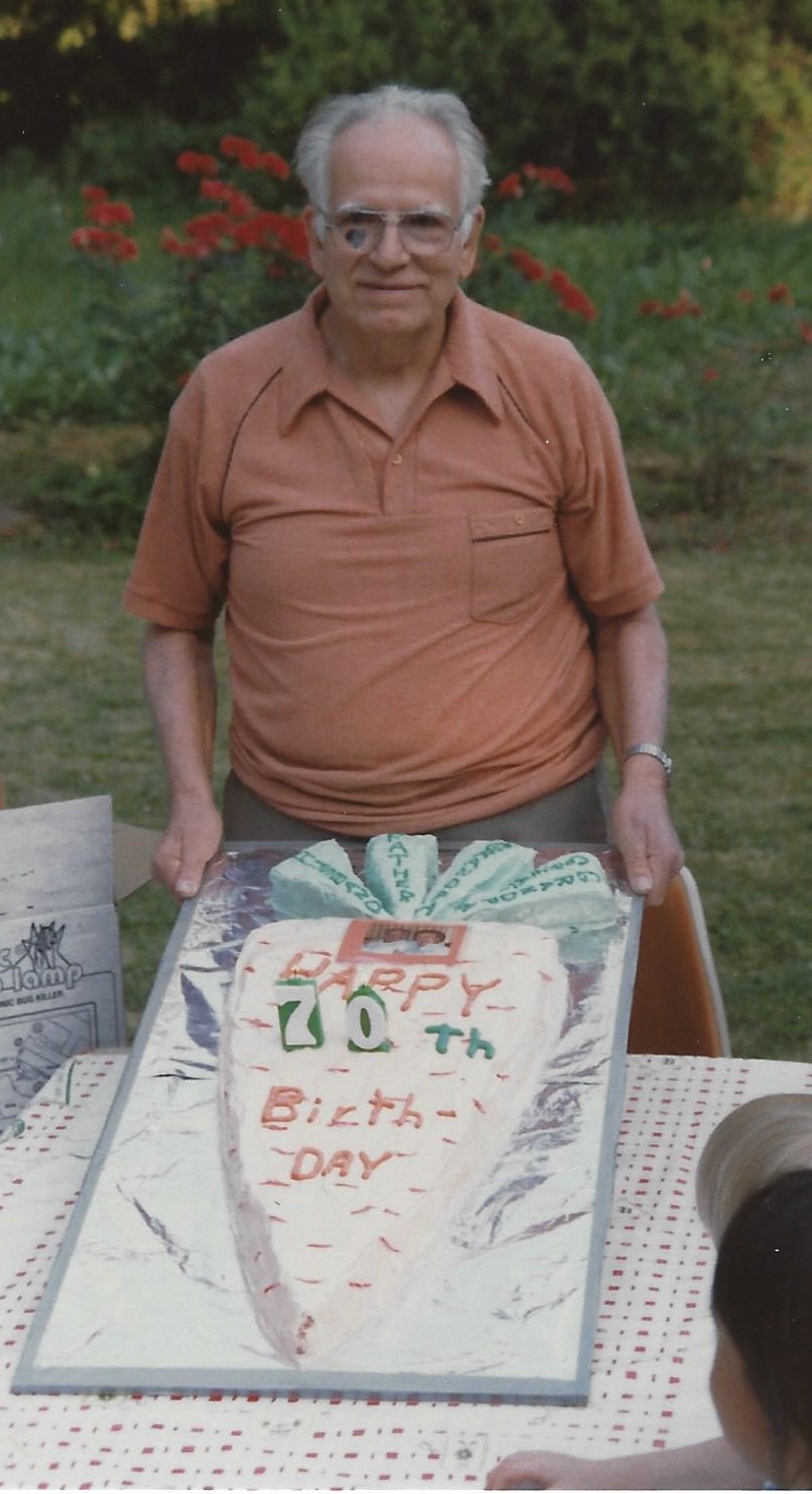
The cake looked like a carrot!
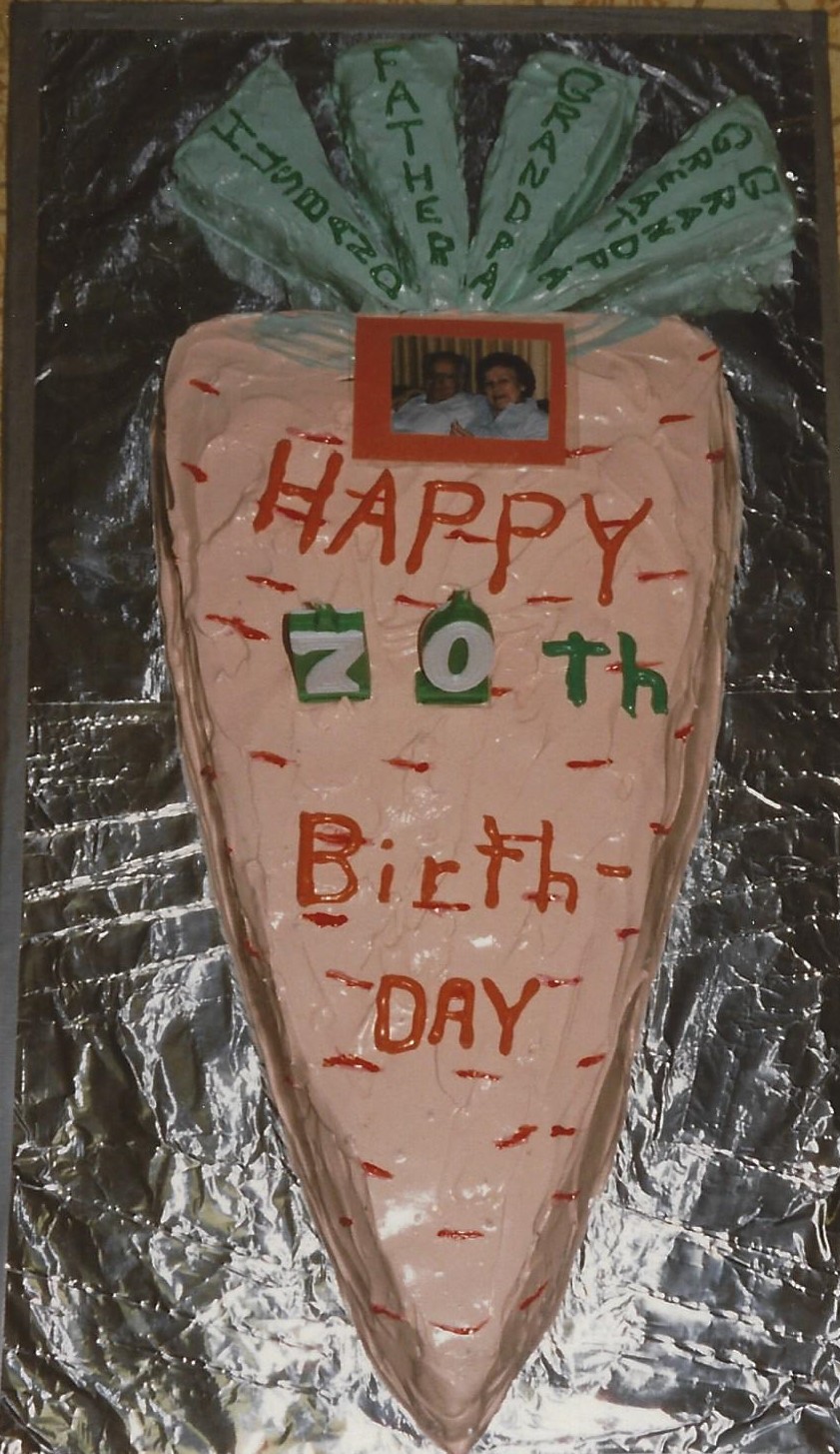
The next year we made a cake decorated as a family tree with the names of all his children and grandchildren on the cake.
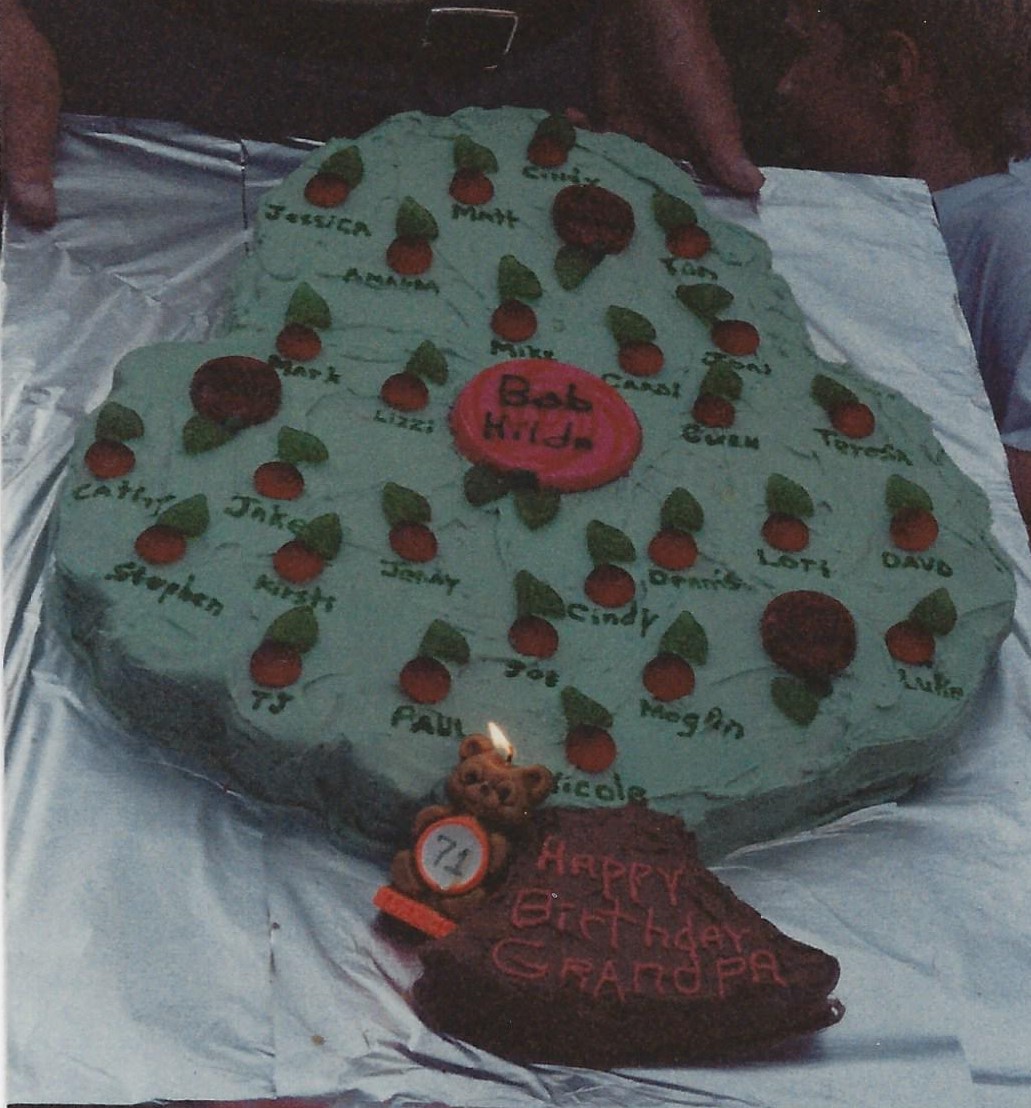
Grandpa looked great for 71.
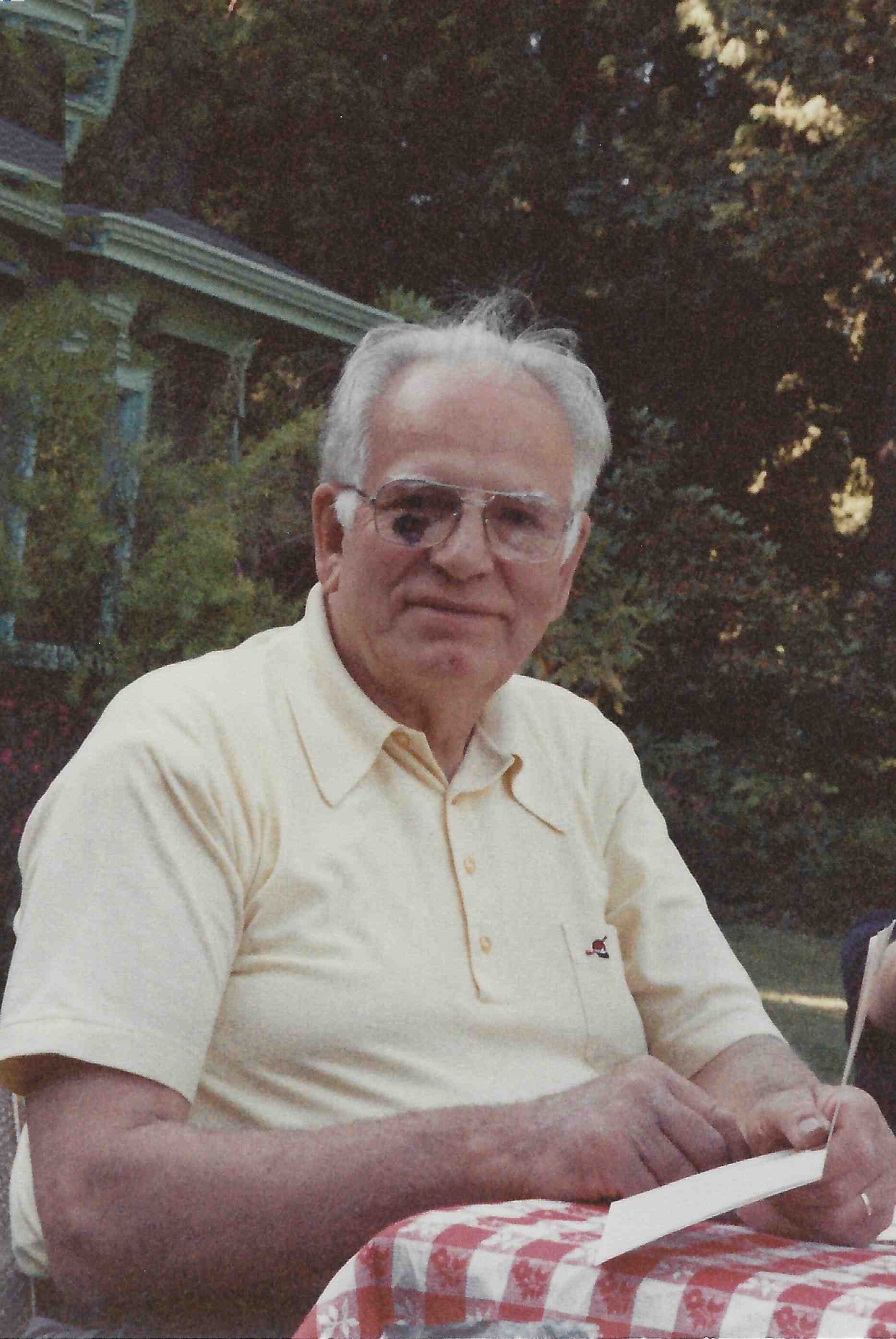
Soon after we came back, Grandpa and Hilda starting spending some of the holidays at our house. The 1978 Easter with Birdie's Grandma Mary Giles and Howard were some of the last times Birdie was with her grandma.
“CH7_V11_Easter78GilesLep.mp4” could not be found.
In her last years, Grandma Mary took on visiting the Veterans hospital. This was in spite of her health problems that included diabetes and an ulcer on her leg and difficulty getting around. It was amazing that she didn't drive but she could make the journey to the hospital and play games with the patients and make it back home. She was remarkable.
We also had Lucky and Rose and their family come and stay a few days for Easter in 1979.
“CH7_V10_EasterLuckyLep.mp4” could not be found.
Lucky was always the prankster and induced Kirstin to crack a boiled, decorated egg on her head; only thing is Lucky had left out the boiling step. I had left home when Lucky was only seven so I hadn't gotten to know him and it was in family get togethers that I finally got to know him a little before his accident. The Lucky family in 1981.
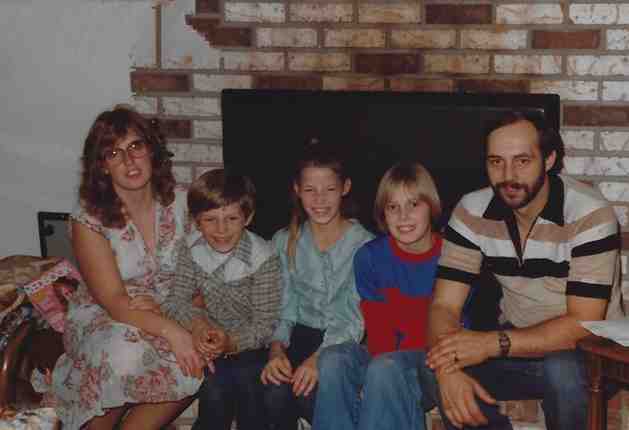
Another of the advantages of getting back to Oregon was our beloved beach.
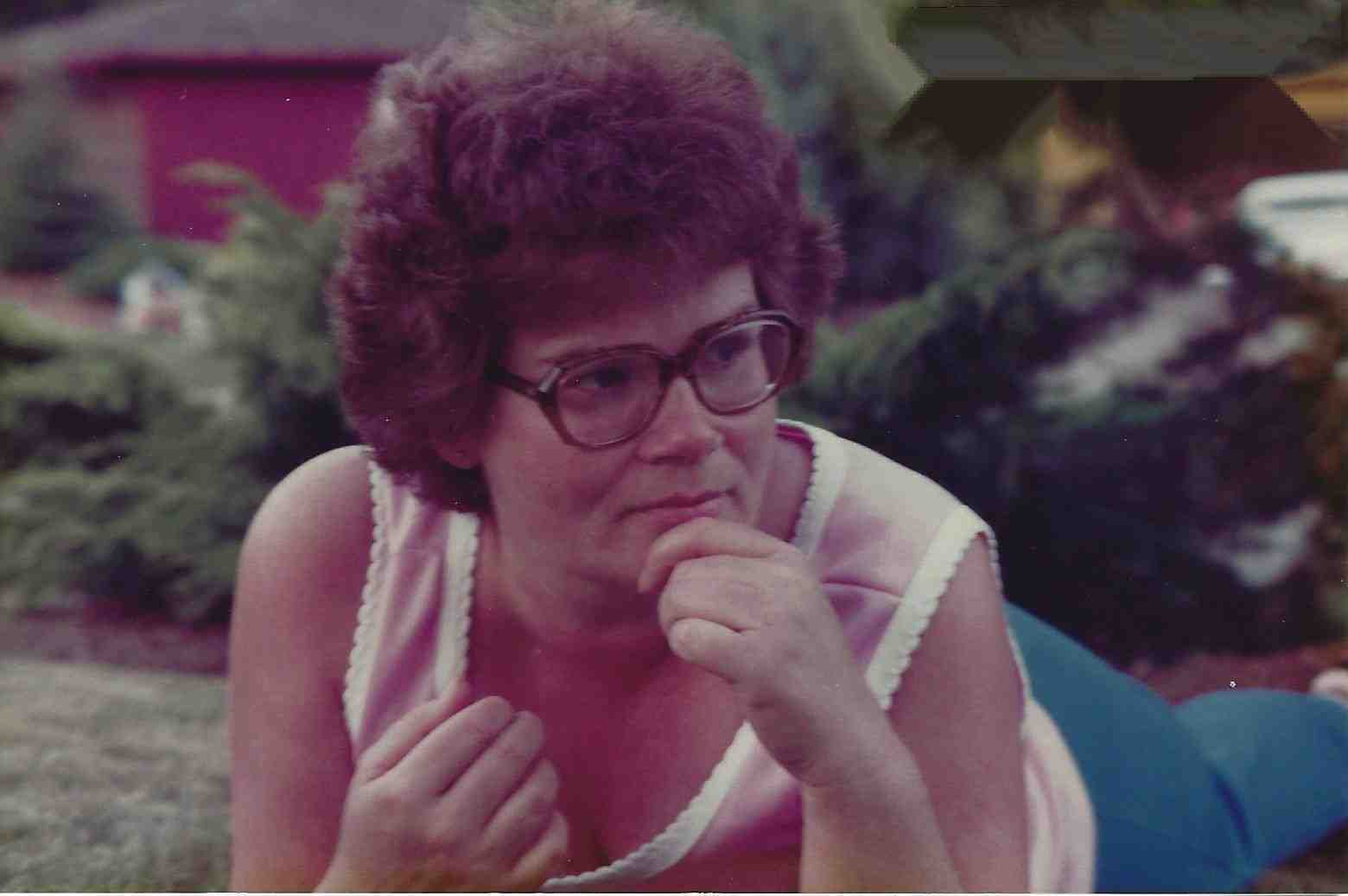
Birdie and I got away for a weekend on the beach occasionally. One of the memorable ones occurred in 1980 or 1981. We were staying in the Windjammer motel in Newport and a good old coastal storm blew up. And it really blew! Birdie woke me up worrying about the kids and the car and the motel. I told her we had played football in Bandon in worse weather than this and went back to sleep. The next morning the power was out in Newport and phone lines were down. The motel sign had been blown over and just missed our car. Several roofs had blown off in Newport including the roof of the ford dealership and the roof of a nearby motel. We had a problem in that we were low on gas and the gas stations couldn't pump without power. We also couldn't make contact with home to see how all were faring so we decided to drive until we found power. We drove to Philomath, got gas, called home and found everyone was okay and drove back and enjoyed the rest of our stay.
Teresa was going into her senior year when we moved. It turned out that it was more difficult than we had expected on the kids to move and make new friends but it was by far the hardest on the oldest. For example, Paul and Dave both have friends from school that became lifelong close friends; whereas I don't think Teresa or Matt do. But they all graduated, became successful and responsible adults and that is how we measure success. Teresa was the first West Albany graduate in 1978.
“CH7_V35_Tgraduation.mp4” could not be found.
An important part of teaching culture to our children was to expose them to Waylon Jenning's music. We did from a very early age. Some of my children have told me (with well disguised pride I might add) that they were the only ones among their friends who knew the lyrics to most of the Waylon songs. I tried to dress the part, including the beard of course!
“CH7_V13_Waylonshirt.mp4” could not be found.
We went out to visit Nadine and Kent not too long after we moved back to Oregon. Aunt Nadine loved to fish and took us all fishing. Fishing was not a family strength and the main one who took an interest was David. Aunt Nadine taught him some fishing and some were caught but I don't know who caught which. I know I could look down into the water and see the damn things swimming right below me but would they bite on my line, NO! Possibly why it was not a family strength.
“CH7_V8_DaveNadinefishing.mp4” could not be found.
After the visit, Aunt Nadine and Uncle Kent asked if Mike and Paul could stay with Jon a week or so and then come home on the bus. We were not enthused but we acquiesced and left them. It was a bad mistake. Apparently, Kent and Nadine had some hidden feelings that came out in how they treated Mike and Paul. They worked them hard while Jon was not required to do anything. They also apparently thought Paul was overweight and it was their duty to correct it during this visit. So, when they passed out things like pop, they would not give Paul any. Mike shared his with Paul. Finally, the boys came home on the bus and we had learned our lesson, no more of that.
It was also about this time that I needed a power saw and I bought one from Kent. It was a used Homelite that had been used in Rogge's business and I have no idea how old it was at the time or how much it had been used. We used it some and Paul used it to cut wood to sell and finally I either gave it or sold it to Paul and he has managed to use it and keep it going to this very day. It has to be at least 46 years (2015) old by my estimate so that is quite an achievement.
Don't assume this section is in chronological order! One of the criteria Birdie and I had in our house hunting was to have some yard to play in. We rejected houses on HP Hill (Vineyard Mountain) because the yards were on a hillside and not suitable for doing anything, besides who wants to live in a neighborhood full of your work people. So, an early project was to construct a basketball court. Per my usual MO I planned a functional but not necessarily great design. The land was sloping about two feet from North to South across slightly over forty feet of width. We dug it out by hand (we again being primarily the boys with some help from me) and used the dirt dug out on the north end to fill in the south end. The asphalt was not so successful. When I talked to the contractor who was going to do it, I told him my concern was the filled portion would sink under the roller weight but he assured me they could use a hand compactor and it would be no problem. However, I wasn't at home when they started doing the work and the contractor wasn't on site either. The workers brought in a huge roller and when I got them stopped, they had already created waves. We lived with it! I had a welder construct the pipe and basket support and that turned out pretty good. He thought it was unnecessary but I insisted he add a gusset. We concreted it in with the intent of having the basket at the correct height and I think we ended up within a half inch. The overall plan was to have half-court to start with and someday expand it to be tennis court size. The expansion has not yet occurred. The basketball court was used a lot and there were a lot of good games played on that court.
“CH7_V1.mp4” could not be found.
My work in printheads was going great. John and I got the processes going and the yields were soon higher than anything they had achieved in Cupertino. We continued to make yield improvements (the best they had achieved in Cupertino for cumulative yield start to finish was about 40% and we achieved 80% after about six months). Since the production plan had assumed the low yields, we were soon in an excess inventory position and severely reducing production starts. John and I were bored. We went to lunch together most days and ordered a pitcher of beer and talked about the fact that either one of us could handle all of printhead engineering. (He also regaled me with stories of his time at Fairchild Semiconductor working with some of the pioneers in integrated circuits. John's job at Fairchild had included cleaning the gold sputter machine and he had collected and saved, at home, all of the stuff he cleaned off which had a significant amount of gold.). The problem we had was that we thought the management in NMOS (the first integrated circuit (IC) line to start up in component manufacturing) was not one we wanted to work for. Eventually John caved and took a job in NMOS. I didn't see much of John after that until years later when he joined IJBU (Inkjet Business Unit).
The manager of printheads, Max Schuler, who had initially hired me had opted not to move to Corvallis and the printhead supervisor was promoted to manager. I reported to him and managed the engineering and he continued to supervise the production. He also supervised IC assembly (attaching the IC to a pre-made package and wire bonding from the IC conductors to the package leads) and as NMOS began ramping up this became a major focus for him. He asked me to manage both the printhead production as well as engineering. He didn't show it on the org chart and this proved to be a problem for me later. The main thing I did in managing production was to select an operator to train as supervisor. She became an excellent supervisor and moved into management later. Our training included firing one operator who could never be depended upon to show up on Monday morning. She typically called from the coast to say she wouldn't be in. It was difficult to fire someone in HP, as it should be, but not impossible and I led my trainee through all the steps necessary (verbal warnings, written warnings, probation etc.).
When we moved in, there was a small (7 or 8 ft) pine tree in the back yard about where the septic tanks sat. One year these small black birds build a nest in it and had little ones. About that time, it started a good old Oregon rain that poured and lasted for hours. The nest came loose and fell with the little ones in it. So, to the rescue. I took an old Easter basket and put the nest in it and attached it back up into the tree. The parents accepted the fix and kept feeding the youngsters until they were old enough the fly the coop.
“CH7_V3_birdnest.mp4” could not be found.
It was only later that I learned they were called starlings and were one of the most hated birds in America. I guess they were not natives but one of the many curses given to us by our English ancestors.
We consider Crater Lake one of the most beautiful spots in Oregon and soon after we came back from Colorado we visited. It is obvious from the video how enthused all the children were. It is hard to see but they were just begging us to tell them about the history and geology of the area. But we kept it to ourselves and just enjoyed the view.
“CH7_V5_crterlakek.mp4” could not be found.
Maxine and Gene had moved from Utah and were living in Washington at this time. Kirstin and Mike were asked to be Godparents for Curtis baptism, so we went. They were living in a rural area South of Seattle and the church was a small church up in the hills. Where Maxine lived was a nice area with lots of trees. The church was in a beautiful setting. The baptism went off without a hitch.
“CH7_V6_Curtis.mp4” could not be found.
As I mentioned earlier, when we moved to Albany Mark had just graduated, Teresa had finished her junior year, and Matt had finished his sophomore year. So, in 1979 Matt graduated from high school. Grandpa Leppert and Hilda and Aunt Helen all came. From the moment we moved to Beaverton, they were far and away the best relatives at attending events of our children.
Matt looked his best and his mother was still wearing her California sun glasses like a movie star.
“CH7_V22_MattGrad.mp4” could not be found.
I mentioned that the basketball court was used a lot and several of the boys became excellent shooters. Mike was one of them. He played outstanding in his Freshman year at West and scored well as attested in the video.
“CH7_V23_Mikebaskball.mp4” could not be found.
Mike prided himself on being a great passer which sometimes conflicted with his coaches who wanted him to shoot more. However, hot dogs were rightfully looked down upon by our family.
In engineering I was focused on failure analysis, particularly failures from the field. Some forward-thinking individual in the original development team in Cupertino had set up a program to have printheads that failed in the field returned to Printhead Engineering. That was now me. I studied hundreds of failures under the microscope. The failures were predominately two types: the printer circuit had malfunctioned and turned the resistors on but not off and fried the printhead; or one or more resistors had a crack through the Aluminum oxide wear layer along one side of the resistor. I did an in-depth study of what we termed "leading edge cracks" and found first they were always on the negative potential side (which was the leading edge with regard to movement across the paper in the early printers which only printed in one direction). I also found that leading edge crack failures had historically been a major problem for products at Fort Collins and San Diego that had printers using tantalum aluminum resistors. Second, while studying firing the resistors under a microscope I found I could make them fail in this manner by slightly overpowering the resistor; either increasing the pulse width or the pulse amplitude. Under the microscope I could see the resistors were being heated to a dull red glow (~600 deg C) in normal operation, and brighter red when overpowered slightly. In conjunction with the scientists at HP labs and from the literature on Ta: Al, the mechanism was hypothesized to be positive hydrogen ions migrating to and collecting at the negative terminal and creating pressure that caused the aluminum oxide (Al2O3) dielectric wearlayer to crack. The literature suggested this might happen if the ratio of Ta:Al was not just right. From my observation of how the Ta:Al sputter target eroded; I formulated a hypothesis that the Ta:Al ratio was changing over the life of the sputter target with the aluminum ratio going lower. The sputter target was constructed by machining slots in a piece of aluminum and placing Tantalum rectangular bars in the slots. The bombarded strips of aluminum eroded faster than the tantalum strips and the tantalum created a wall next to the aluminum. Since in sputtering the emission from any point follows a cosine distribution, the tantalum walls on both sides shielded the adjacent aluminum and the amount of aluminum deposited was reduced. Since aluminum is much cheaper than tantalum, the fix was to periodically pull the target, take out the tantalum rods, re-machine the aluminum and put the tantalum back in. This pretty much eliminated leading edge crack failures.
When we moved to Albany, Star Wars was the rage especially among the young kids. When Dave started at Oak Grove school most of the kids had seen the movie but Dave hadn't so, he faked it so he wouldn't be ostracized. We finally went. Dave was enthralled.
“CH7_V9_Davestarwars.mp4” could not be found.
It turned out that another little project we had become interested in came together and made for a memorable event. We (meaning I don't remember who started this but I was involved) had bought some small model rockets and fired them off with some success. They were basically a cardboard tube with fins and a place to insert a rocket engine. They also had a parachute in the nose that fired out after the rocket engine was spent and the rocket floated back down leisurely without striking any of us on the head. Having almost mastered the simple rocket, we got Dave a Star Wars X-wing rocket with a large rocket engine. If, when a rocket fires, there is no way of correcting position quickly and effectively, and the thrust is not exactly balanced, the rocket will start leaning and then the rocket engine will accelerate it in that direction and send it into a tumble or into the ground or both. Not a good thing. It was one of the major tasks in the first Russian and American space shots to get the rocket to stay aligned in the direction it was intended to go. They used gyros and developed techniques of modulating the thrust to maintain alignment. For Dave's rocket we depended on the rocket engine being uniform enough in thrust to not get it misaligned too much before the engine was used up. Dave was undeterred by these minor problems and he meticulously detailed the X-Wing with precise painting and with every sticker emblem such that even Yoda would be proud. The launching was put off for some time to fully digest this marvelous model. Finally, the big day came. All of the family that was available made the trip to the launch pad in North Albany Park. Dave was proud and excited and all grins. The rocket engine was ignited and the X-Wing roared off toward the wild blue. About 10 feet up it started to tilt and quickly went into a roll that was not so slow and by about twenty feet it had turned completely around and with full thrust plowed back toward the earth. The explosion may not have been that loud but it was definitely devastating. Dave the Rocketeer quickly went from anticipation to crushing sadness. Thankfully, home movies were taken and captured that sad look for posterity
“CH7_V33_rocket_combo.mp4” could not be found.
The line between programmable calculators and computers had become blurry, consequently a section manager in calculator R&D was starting a program to extend calculators into a desktop computer, the HP 85. His name was Ernst Erni. He was planning on having a small built-in CRT and a built-in thermal printer along with a keyboard. I went to talk to him about the thermal printhead he wanted for his product and posited the need for some life testing in an environment simulating the product. He went into a tirade about how the original Cupertino printhead development team had gone way overboard on testing and he wasn't going to do that and, in fact, Clement Lo, his design engineer for the printhead circuitry, had assured him that the failure mode for his circuit was 'no power' rather than 'excess power'. When the product was near introduction date, the quality department did a series of life tests of the final product and the printheads had an unacceptable failure rate. Ernst complained to the head of our department, Ed Shideler, and since my supervisor was out of town, Ed asked me to meet with him and Ernst. After Ernst had made his case that the printheads were failing and that we should solve the problem. I related my earlier conversation with Ernst when he had refused to pay for any printhead engineering support or testing and I suggested the results were what we might expect. Ernst called me a liar and denied the entire conversation. What Shideler believed I will never know; he did support my request for another engineer and I hired Ken Trueba from the Vancouver division. Ken worked on the printhead for the HP85 printer for Ernst and I worked on the printhead for Special K, the printer for the HP41C. Unfortunately, I had not seen the end of Ernst Erni.
Note to reader: The attached Inkjet addendum goes into the development of Inkjet in detail. In this story I will cover highpoints I think might be of interest to everyone but for those interested in the development of inkjet, and who read the addendum, these next 3 paragraphs might be redundant.
Inkjet Addendum
CONTINUING
I previously mentioned my working with Bob Waites in Cupertino while I was learning the printhead technology. After the move of printheads to Corvallis, Bob took a position at HP labs in Palo Alto and he and I talked occasionally on the phone during the print head start up in Corvallis. In late 19798 or early 1979 he called me and told me about a new printing technology that Jon Vought in HP labs was working on, which he called inkjet, and suggested that I take a look at it as a possible replacement for thermal printheads in calculators. Thermal printheads had some serious shortcomings: One was they were inherently very slow in printing speed. A second was the inherent low resolution. The third was they required special, expensive paper. So, a better technology was definitely of interest to me.
Ken Trueba was going to Palo Alto so I asked him to stop by and see what Jon was working on. He came back very enthused. Jon was planning an 'I to L' checkpoint meeting and invited me to attend. (In HP lingo, the I to L checkpoint is when a new idea has shown, through experimentation, that it warrants more extensive investment and signifies the idea going from the Investigative phase to a Lab prototype phase.) I attended and was also enthused. I wrote up a summary of the project and the advantages over thermal printheads and scheduled a meeting with the Corvallis Division R&D manager, Fred Hansen. Fred listened to my pitch, took the copy of my proposal and I never heard from him again.
Some monts later, Ed Shideler, in a move to make himself a division manager rather than just Corvallis Components Operations Manager, created an R&D department and hired Ernst Erni as R&D manager. (again, in Hp lingo the difference between an operations manager and a division manager is that the division manager has R&D and Marketing departments and is a profit center whereas the operations manager does not and is not). Ernst put out a request for project proposals for his new department. I dusted off my old inkjet proposal. Frank Cloutier, who had worked on the LCD fiasco, submitted a proposal for an LCD with active devices on board. This concept now is common in large screen LCD displays but at that time was not within the capability of HP. So, Ernst had a dilemma, he liked my proposal but not me. He liked Frank but not his proposal. He solved it simply by giving Frank the inkjet project. It actually was a good decision since the project would require a lot of 'promoting' and promoting was Frank's strong suit and not mine. However, there is zero chance Ernst made the decision for the right reasons. I was so convinced of the potential of the inkjet technology and I wanted to be part of it so I offered to work for Frank. At this time, Greg Merten had just become the printhead manufacturing manager. He asked me to delay transferring to inkjet for a year and help him learn the printhead technology. I agreed.
Paul Van Loan was an engineer from the LCD team working for me He was from Canada and had a PHD from a school in Montreal. Two stories about Paul: First, we had several trees in our yard that looked like coast redwood but lost their leaves in winter. We had been told they were Dawn redwood but Paul loved them and called them Meta Sequoia. We (meaning the boys) helped him dig up and transplant several of ours to his house in Corvallis. Second, Paul was somewhat proud of being a wine connoisseur and he later invited Birdie and I to a wine tasting party at his house. One of the games was to taste an unknown wine and guess what kind it was. Birdie and I prided ourselves on being bumpkins and neither of us had a clue. We thought we were doing good to delineate whether the sample was red or white. Paul wasn't impressed. Then for the climax he had a bottle of 1949 cabernet that he had spent an inordinate amount of time building up as the greatest surprise. Then with a flourish he opened it and we all tasted. I suggested it tasted musty! He still wasn't impressed. I guess I should have said 'red and musty'! It was musty!
Mark had learned to drive with the Volkswagen bug and we had given it to him for graduation. He traded it for a sporty red Mitsubishi. We decided to purchase a pick up for the needs we had plus a work car for me. We went to Beaverton Toyota and bought a new (our first new vehicle purchase) 1978 long bed pick up with a 5-speed manual transmission. I had potential drivers like Teresa and Matt backing up to get their license. To Matt's disadvantage we had declared that we would only teach one driver at a time. This turned out to be an unexpected long delay for Matt. One of my poignant memories of Teresa's learning to drive was when the pickup was only a few days old and I took her for a drive. We were still on Meadow Wood and she asked me about some symbols on the speed-o-meter and I started looking in the manual to find out what they were. Teresa was ready to shift to the next higher gear and was looking at the diagram on the gearshift knob to see where the next gear was. I was surprised to hear the sound of wheels on gravel. I looked up and no one was watching the road and we were quickly leaving it! I turned the wheel to get us back into the road and never again took my eyes off the road while Teresa was driving.
The amazing Toyota pickup was used to train six drivers and had over 200 thousand miles when David finally traded it away. It was not the end of the pickup, however. Paul had put special wheels on it and Dave had replaced the engine. Sometime after it was traded, Paul saw it in Forks where he was living. It was a special truck! Thanks to it all of my children can drive a manual transmission.
It bears repeating that never during our marriage did Birdie and I have enough money for our family to enjoy some of the more expensive activities like skiing and boating but we tried to do lots of other things that took less money. Basketball and football, of course, and others. I have told how we had done hiking and archery and walking on stilts and a day of track using old mattresses in Colorado. In Oregon we tried rafting. I bought a couple of medium sized Sevylor rafts and read a couple of books, one of which described a rafting trip on the South Santiam river from just below Foster Dam to Waterloo Park just above Lebanon. For some reason, which I have forgotten, perhaps a date, Teresa needed to be back at a certain time. Math being my specialty and based on the estimates from the book, we had plenty of time. So, we dropped one car off at the end point and took everyone up to the starting point and set off. It was kind of fun, for an hour or two! It would be an understatement to say the South Santiam River is pretty slow. We didn't make anything close to the time I had calculated from the book. Pretty soon some were disgruntled; even complaining. Needless to say, we were several hours late and Teresa did not make it even close to on time. Some were turned against rafting forever. However, I was not deterred! It was simple, find a faster river! The North Santiam was just such a river. Our next venture was down the North Santiam from Pack Saddle Park to Fisherman's bend Park. And we planned on and did port the Mill City falls. However, the excitement occurred much before we got to Mill City falls. Again, we had studied the book. The most energetic rapid was a spot just past the little village of Gates called 'Spencer's Hole' where the river was forced between two large rocks into a pretty narrow rapid. So, we were floating down smoothly just a hundred yards or so upstream from Spencer's hole. Dave and Birdie were waiting for us at the Fisherman's Bend. I don't remember who exactly was in each of the two rafts, but Teresa and I were in one raft. Teresa was back in the steering position and the raft was crossways to the river but just gently floating and seemed okay. However, there was a large hidden rock with a flat ledge just below the water's surface that extended several feet across the river. Our raft floated up against that rock ledge and the leading side stuck against the rock ledge and the trailing edge was pulled under until the raft flipped upside down and flew over the rock. All of us were dumped into the river and since we were wearing life vests most of us bobbed up right away. Teresa, however, had fallen just past the rock and the water flowing over the rock ledge created a strong undertow, which pulled Teresa down next to the rock and pinned her there. This was probably the scariest episode of my life and was much worse for her. Those in the other raft had gone ashore quickly and were trying to find a way to get out to her but that was pretty tenuous. Those of us in the river couldn't move upstream. Teresa was down there what seemed like a long time to us and must have seemed like forever to her. She said she finally quit trying to get free and just relaxed and then the current kicked her out. A great sigh of thankfulness to the One who controls these events. My movie camera was at the bottom of the river with all of the movies I had taken of the trip. The water was too deep to easily retrieve it and I did not feel like pushing it. Maybe it is still there. We ported Spencer's hole and made it comparably uneventful the rest of the way. For some this was a final raft trip; but not everyone gave up on the rafting. Some of the boys and I took the rafts back until we mastered both Spencer's hole and the Mill City falls. Soon the only thing that gave us a thrill was going over the falls.
“CH7_V32_raftingmillcityfalls.mp4” could not be found.
Dave was now old enough and he learned rafting in the more daring times. Since all the boys left home the rafts have sat and rotted in my garage.
Our family room was perfect for a pool table; so, we made the plunge. We purchased a Brunswick Century table that was great quality. Pool was something everyone could do, some better than others. Dave was ten and ten became the minimum age for playing. Dave had a special short cue stick. Paul used his wood shop skill and built, in class, a light to hang over the table. None of us knew how to play and, in fact, we had to have manuals to learn the rules. The boys picked it up quickly and Mark and Mike became quite good. The rest of us were journeymen. It provided hours of fun. Grandma Hilda loved the game and played every time she came; probably even influenced how often they came.
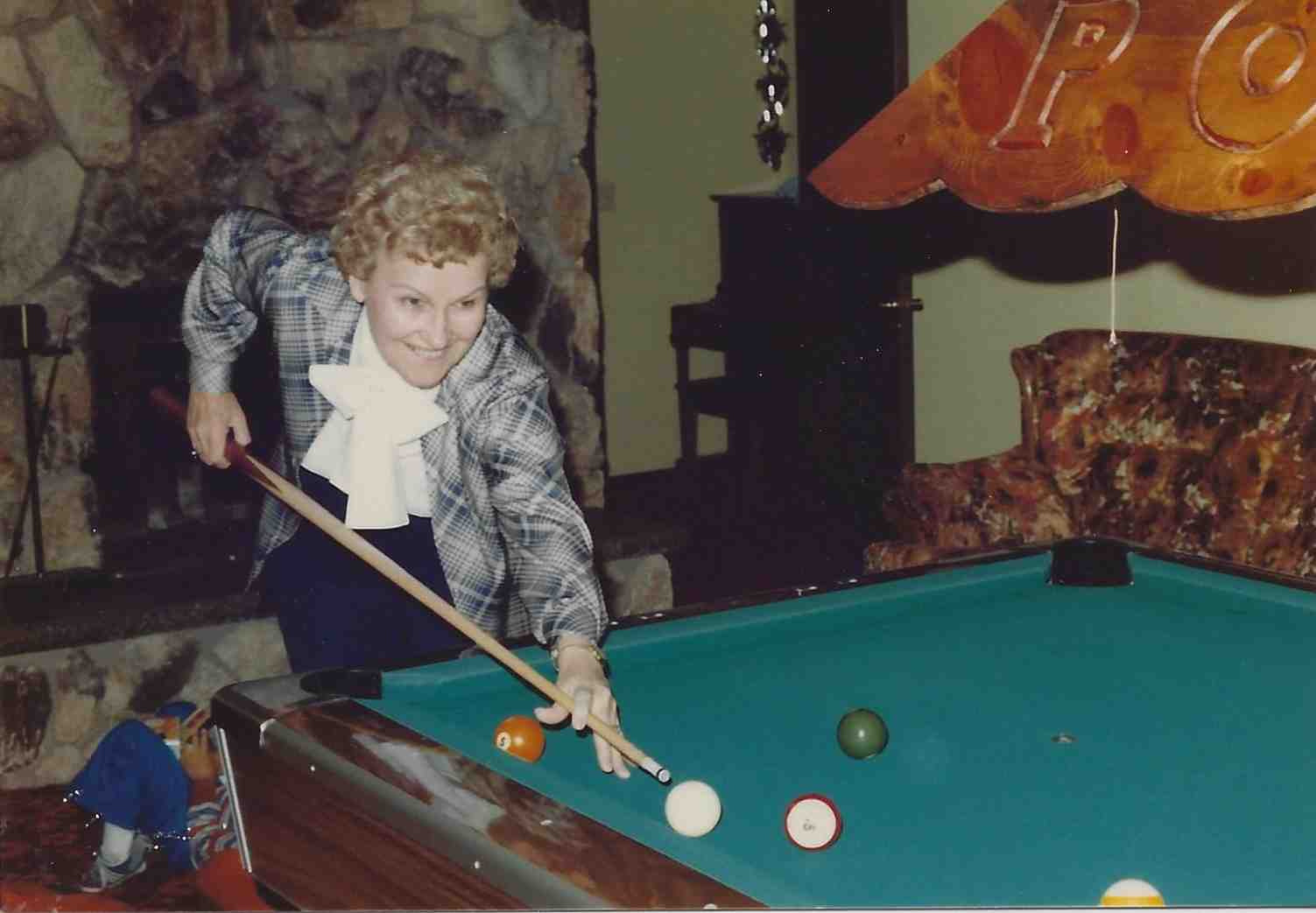
Grandpa Leppert also played.
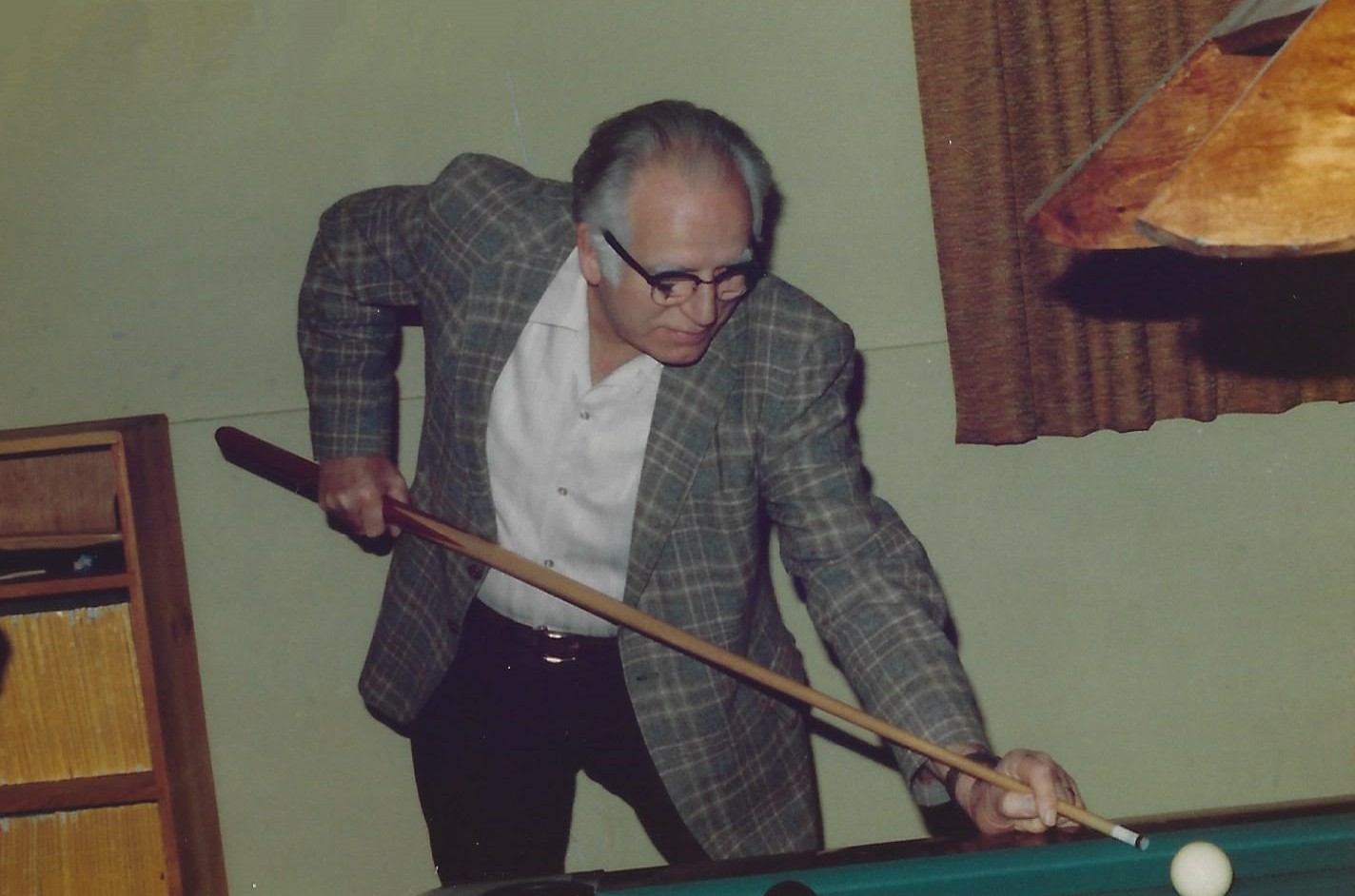
Even my Mom and Dad gave it a go!
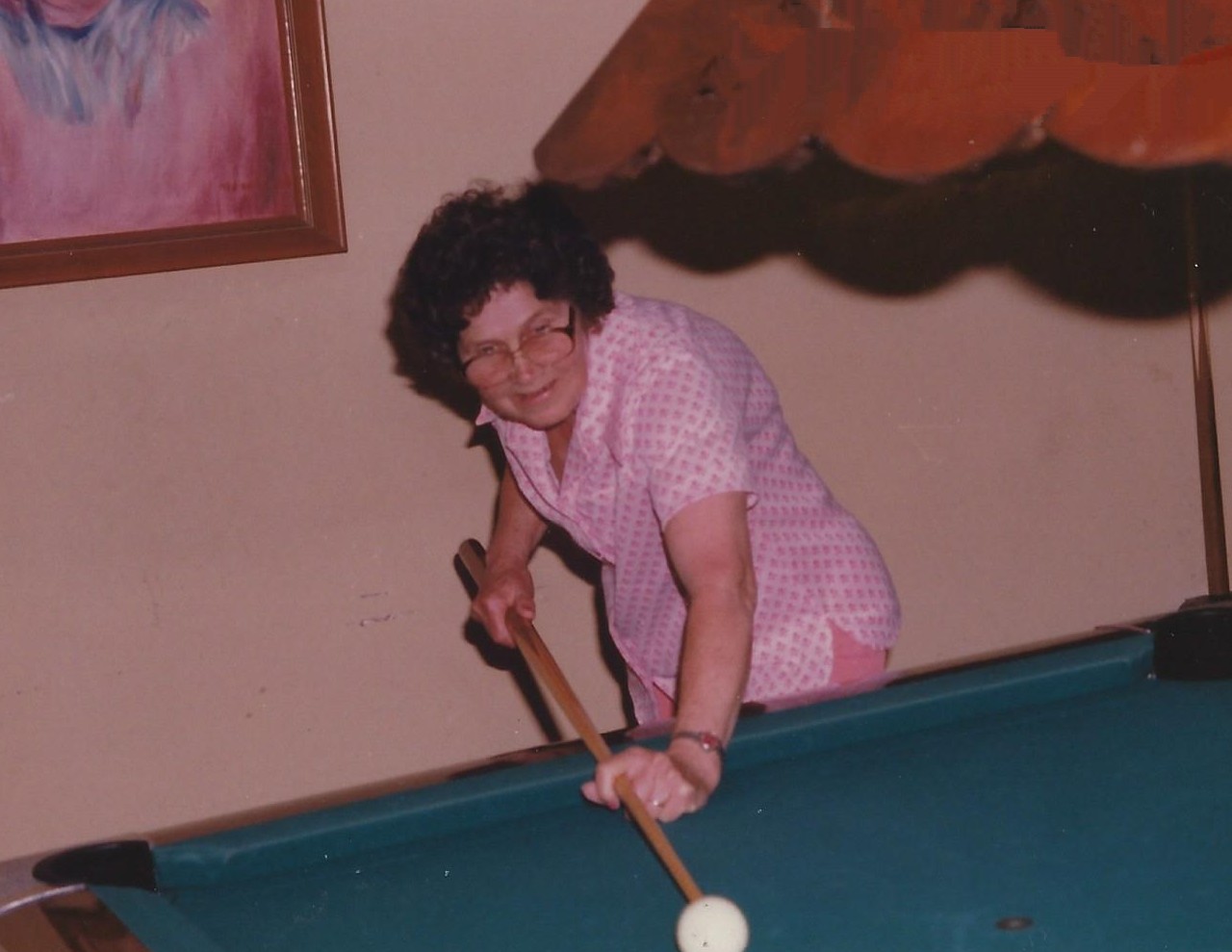
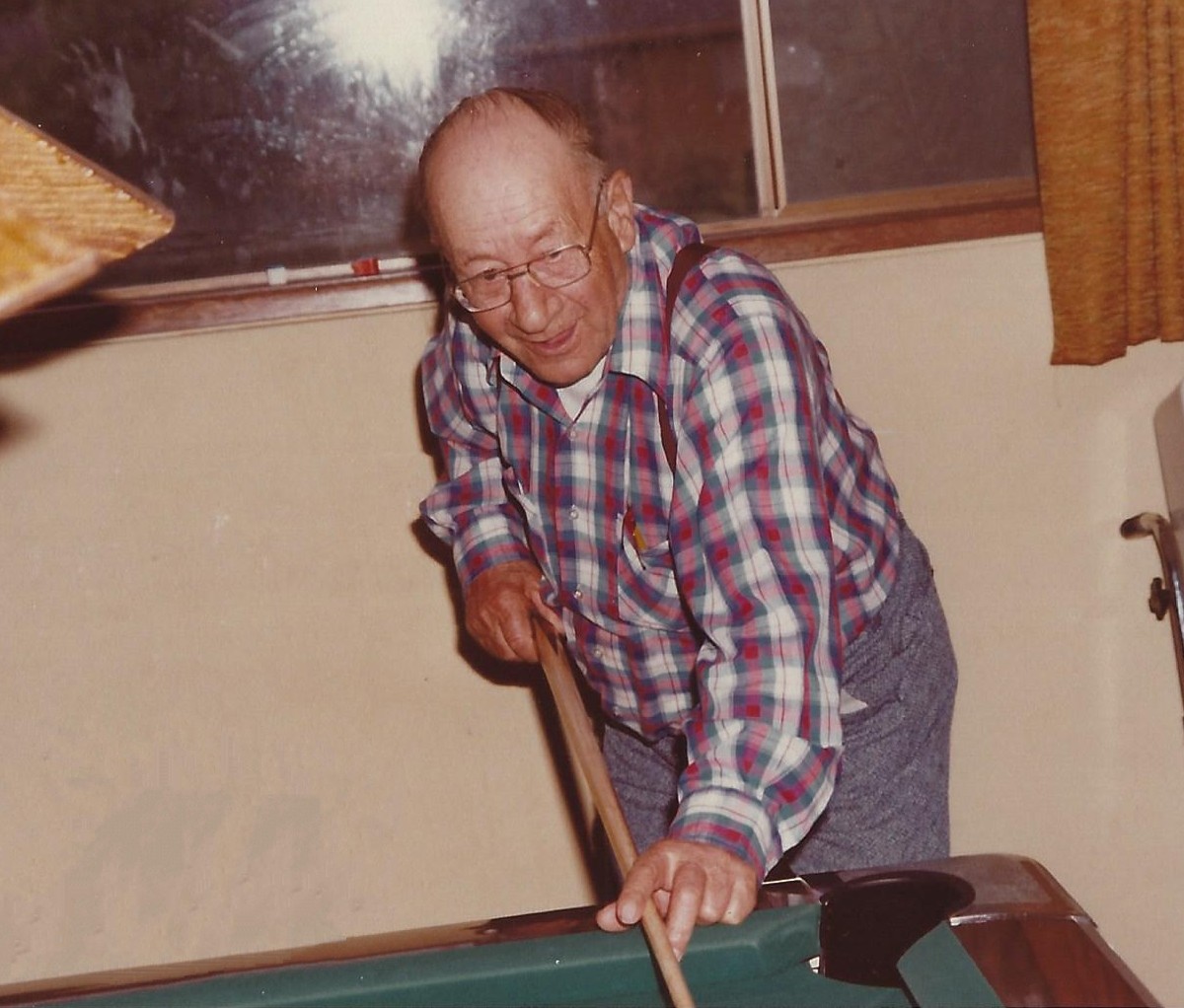
Pranks have never been unknown in the family. On Dave's 10th birthday he couldn't even blow out the candles.
“CH7_V7_Dave10.mp4” could not be found.
Starting about then we also used to make Dave follow a scavenger type hunt to get to one of his Christmas gifts each year. I guess the young and innocent are the easiest to fool.
Birdie and I struggled with the approach of our children going to college. Part of the dilemma was our situation and part was our experience. The situation was we had too many, too close to just give them all a college education. Our experience was that we had achieved my college education under extremely difficult struggles with no help from family or government. We didn't want our children to struggle as much as we had but we thought some struggle was good. I still do not know exactly what the best stance is; there are many who waste their college opportunity because of what I perceive as not having enough of themselves invested. But there are many who are fully supported and thrive. I do not believe college is for everyone and I believe some struggle is necessary to weed out those who aren't fully committed and don't belong in college. I also believe when the child must work and invest their own time and money in their education, they not only perform better but they also take more pride in the accomplishment. From my experience, I believe anyone in our country who really wants to go to college and has the ability can find a way. Where we ended up was a bit of a compromise. We had a Linn-Benton Community College in Albany, OSU within 12 miles and Western Oregon U within 20 miles so they could live at home free and commute. Them earning the remaining expenses would not be prohibitive if they applied themselves and worked hard.
Also, during this time Birdie and I went to listen to an expert in child psychology and he talked about children in the home after they had completed high school. He said they should not be left to just sponge. They should be given options: go to college; get a job and move out or pay room and board; or join the military. This pretty much solidified our position. We offered free room and board if they got a job and made a real effort to earn the tuition and go to school. We were prepared to act as a safety net but needed to see desire put into action. If they couldn't get a job, the option was the military. Even though I did not like the military life, I did and do believe it is a great way for children who don't know what they want to do, to mature and develop goals. Mark and Teresa made some weak efforts at college and joined the military;
Matt went into the Navy CB's and learned a trade.
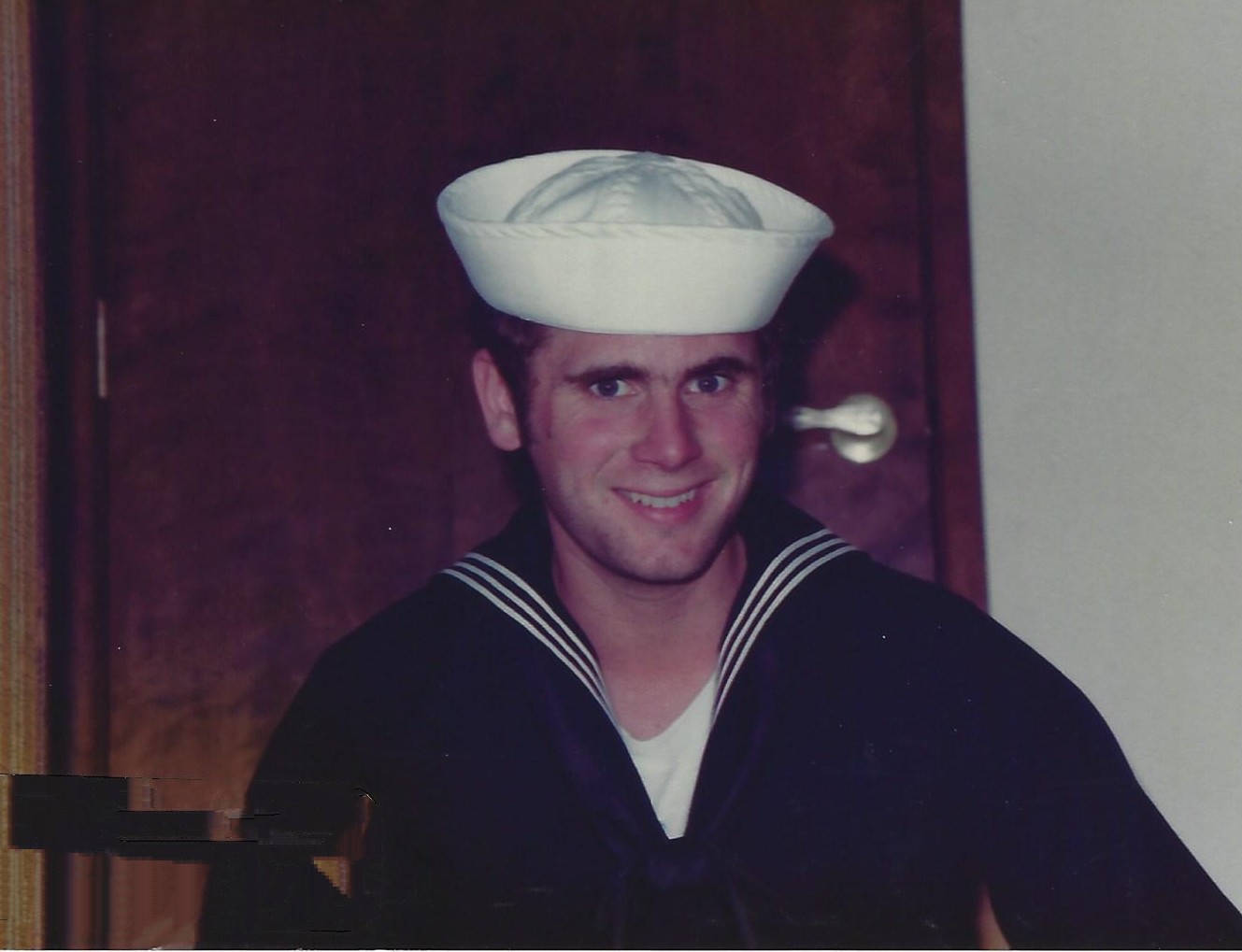
Mike went into the Air Force with a plan to follow that up with college and he followed his plan to completion at OSU. Teresa went back to OSU after the military and excelled, in spite of having to work to support her and Luke, and got her degree with honors. Mark and Matt chose careers that didn't require college and did very well. Kirstin got married and completed her degree at OSU; stretching it out along with raising a family. Paul worked and stayed at home and completed his degree at Western. Dave made a rather weak effort at Western and then got a job at HP and worked there a number of years becoming a process technician. He then quit and went back to Western and completed his history degree with honors and a master's in education. How do you measure success of your parental decisions? I am always result oriented and we are very proud of our children's results. You be the judge.
The Venetian Theater in Albany was still operating like theaters of the past and played a role in several of our children's growing up. Kirstin, Teresa, Mike and Lori all worked there. They were all good workers and the supervisor sort of took them under his wing.
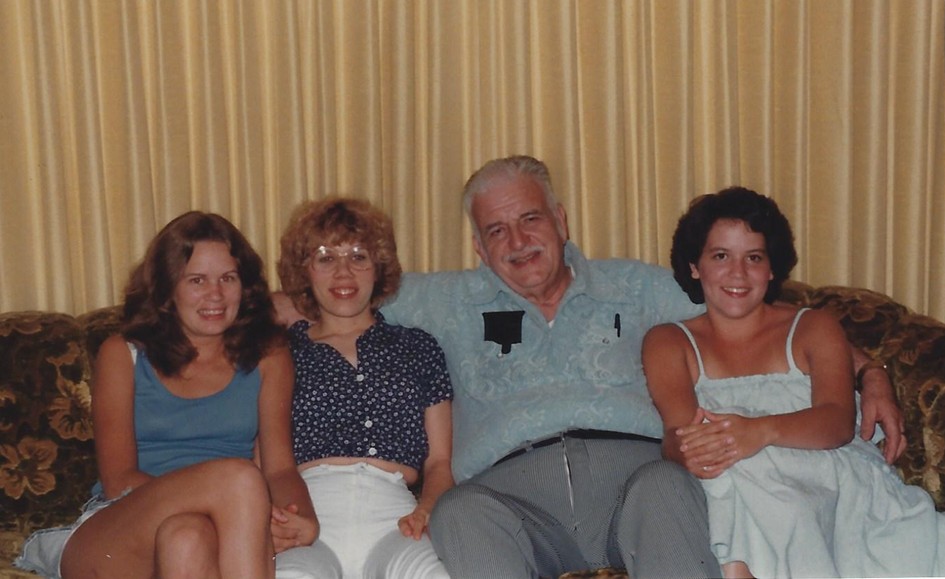
In 1980 Mark was in the Air Force and Lori was graduated from South HS.
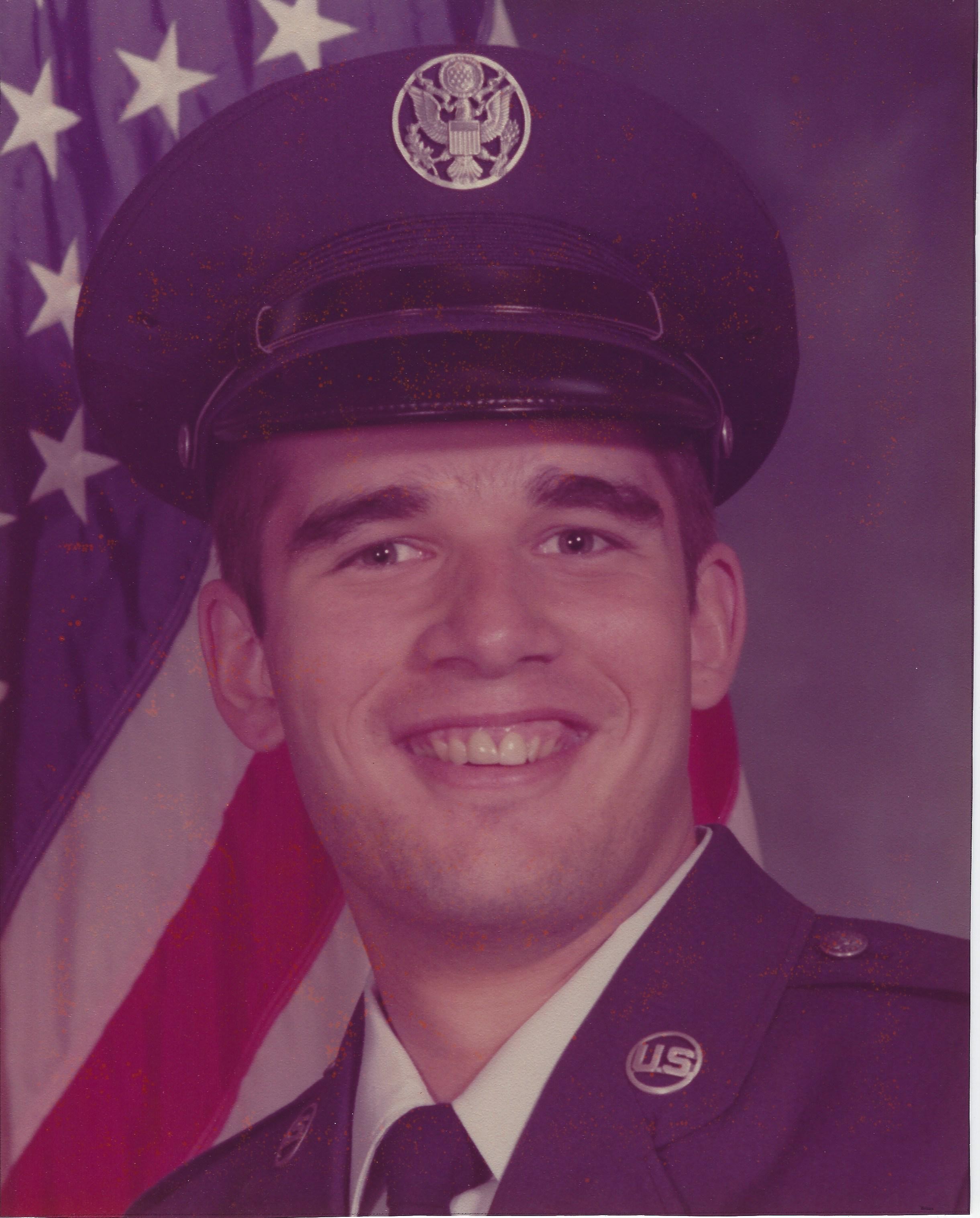
It was the perfect time for a wedding. They were married in the old Church with Birdie doing the flowers and a reception at our house with me the master punch maker. It was a happy time and then they packed up and left into the "wild blue yonder".
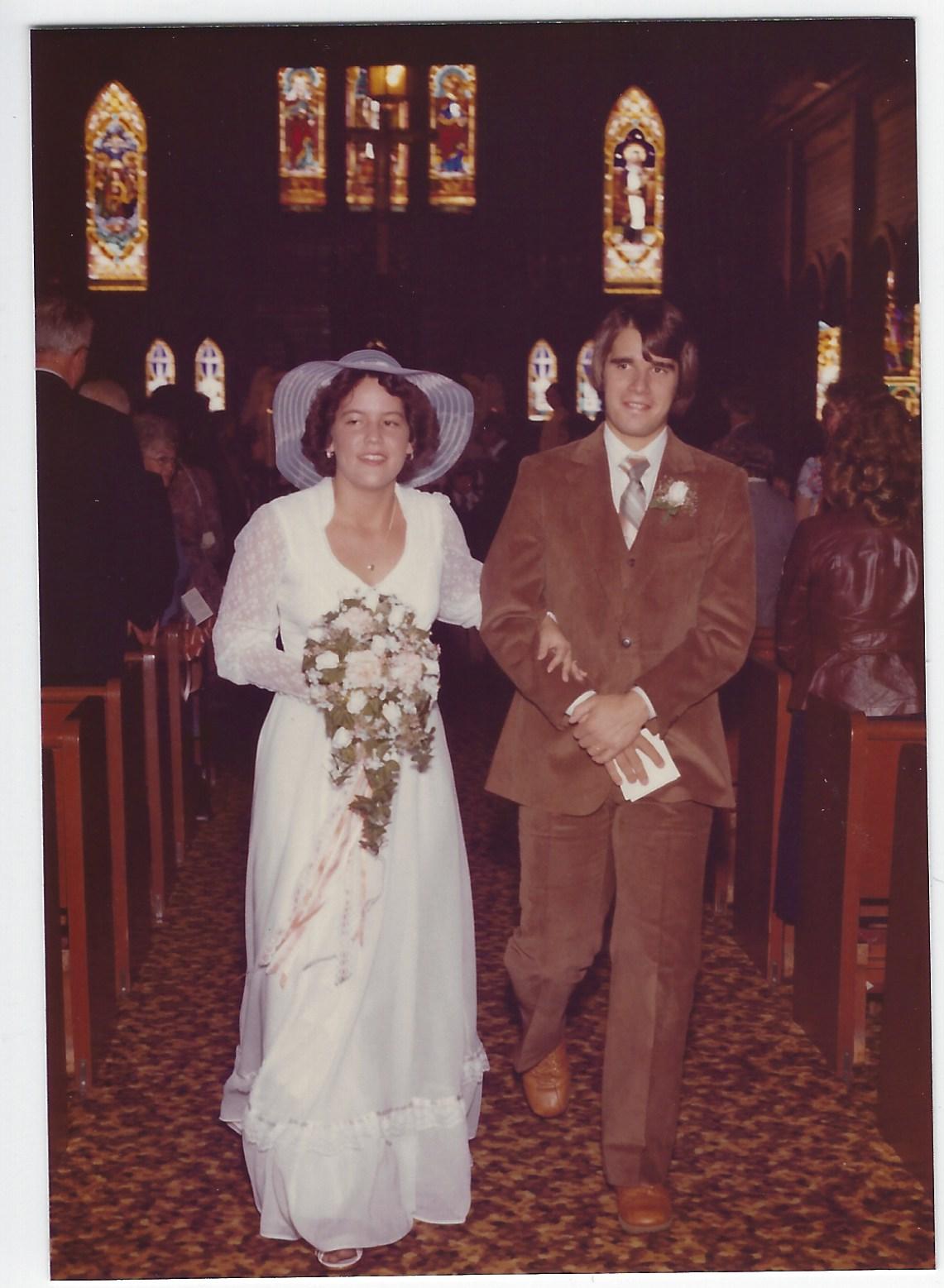
Kirstin graduated in 1980. She was an honor student and the honor club had their party in our back yard. Raucous it was not but a very successful group.
“CH7_v19_grad.mp4” could not be found.
One adventure we began about this time was a love of motorcycles. Probably this was fueled by my friend and coworker, Pat Shelley, who lived near, just off Valley View on Arlington. Pat had been a member of a motorcycle gang in Sacramento and he still had several motorcycles and had not lost his enthusiasm for riding. About 1981 I purchased a used Yamaha 500. I bought this from some fellow in Portland and we loaded it in the pickup and brought it home. Like most everything I ever purchased used, it needed some attention. Pat helped with that. This motorcycle was actually a bit much for our skill level. It had a lot of torque and required care in starting out or it would be standing on the back wheel, as I remember Matt discovering one day. A bit later a coworker, Carl Hanson, wanted to sell an old nearly worn out Honda motorcycle (150 I think) that was pretty suitable for novices.
“CH7_V12_firstHondaMC.mp4” could not be found.
Paul and Mike put it together (Carl had it mostly in a box) and became avid riders and progressed to the Yamaha. Dave was young enough to stay with the Honda. Kirstin also became very good at riding and progressed to theYamaha. However, she had one bad experience that pretty much ended her motorcycle career. She had gone down into North Albany park and was coming back out and stopped at the intersection with Valley View. A particularly touchy situation with this Yamaha where you needed to give it enough gas to start on a hill but not too much to lift the front end. Unfortunately, she erred in the latter and she lost control and ended with it dumped in the ditch on the other side of Valley View. The motorcycle was not hurt but this motorcycle was extremely heavy and she could not get it back up. So, she had to come home and get help and, even worse, fess up.
I rode this motorcycle to work quite often for a couple of years. However, not having been brought up with how great Harley Davidson motorcycles were, I wanted something smooth like a 4-cylinder Honda. A coworker I knew, only slightly, was a small Englishman who rode a Honda 650 4 cylinder. He and I had talked a few times about motorcycles etc. One day on his way home, someone in a car ran a stop sign and hit him. He was banged up a little and the motorcycle was banged up a little. When I talked to him, he told me the insurance company had totaled the bike and his wife had ended his riding days. So, he told me the insurance and I contacted them and purchased it, as is, for a good price. The main problem was the windshield was broken and maybe a few other minor items. I was able to rehabilitate it so it couldn't have been much. It was a sweet riding bike. I drove it to work for a time also. One day I was enjoying the ride to Corvallis on HWY 20 when of all things I heard a siren and it was the cop. He claimed I was speeding but we all know their radars are notoriously faulty. But he was persistent and I ended up mailing in some $75 dollars to avoid a court appearance, or worse. To camouflage the check book entry I wrote it was for 'renewal of marriage license'. It was weeks later before this strange entry was detected by the checkbook co-owner.
Birdie kept telling me that it would be very, very, very bad if one of her boys got hurt or worse on 'that thing', as she fondly referred to it. Well Paul was riding one day and he was going along Quarry and came into the sharp turn on Quarry with a bit too much speed. That turn seemed to always have loose gravel thrown out on it. Anyway, Paul hit the loose gravel and went over the North edge and down the gravel embankment. Nothing was hurt too seriously but Paul's side was scraped raw all the way it seemed from toe to chin. His mother was aghast. It seemed the safest thing for me to do was sell the motorcycle and live happily at home, so I did. End of the motorcycle story.
Birdie's father and Hilda were in the Phillipines the last two of our high school years and she was not able to spend much time with him until we came back from the Navy. During our years in Beaverton, they visited often and we were invited to family events at their home (see Chapter 5). We both developed a deep love and respect for both he and Hilda. When we returned from Colorado, they visited us for family events. Here he is with Birdie in 1981.
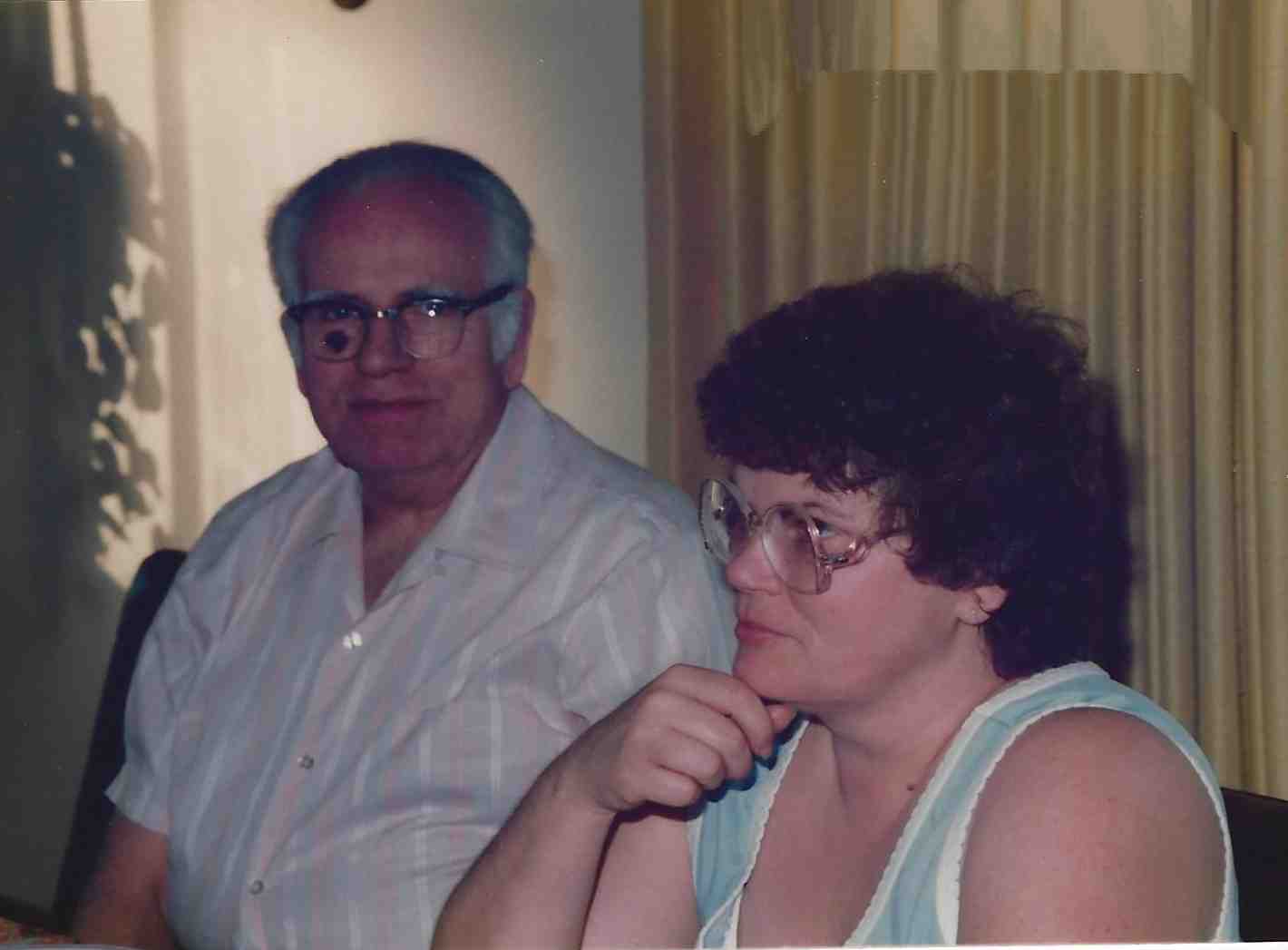
We had a party for my Mother on her 68th birthday at our house in 1981 and we had an amazing turnout
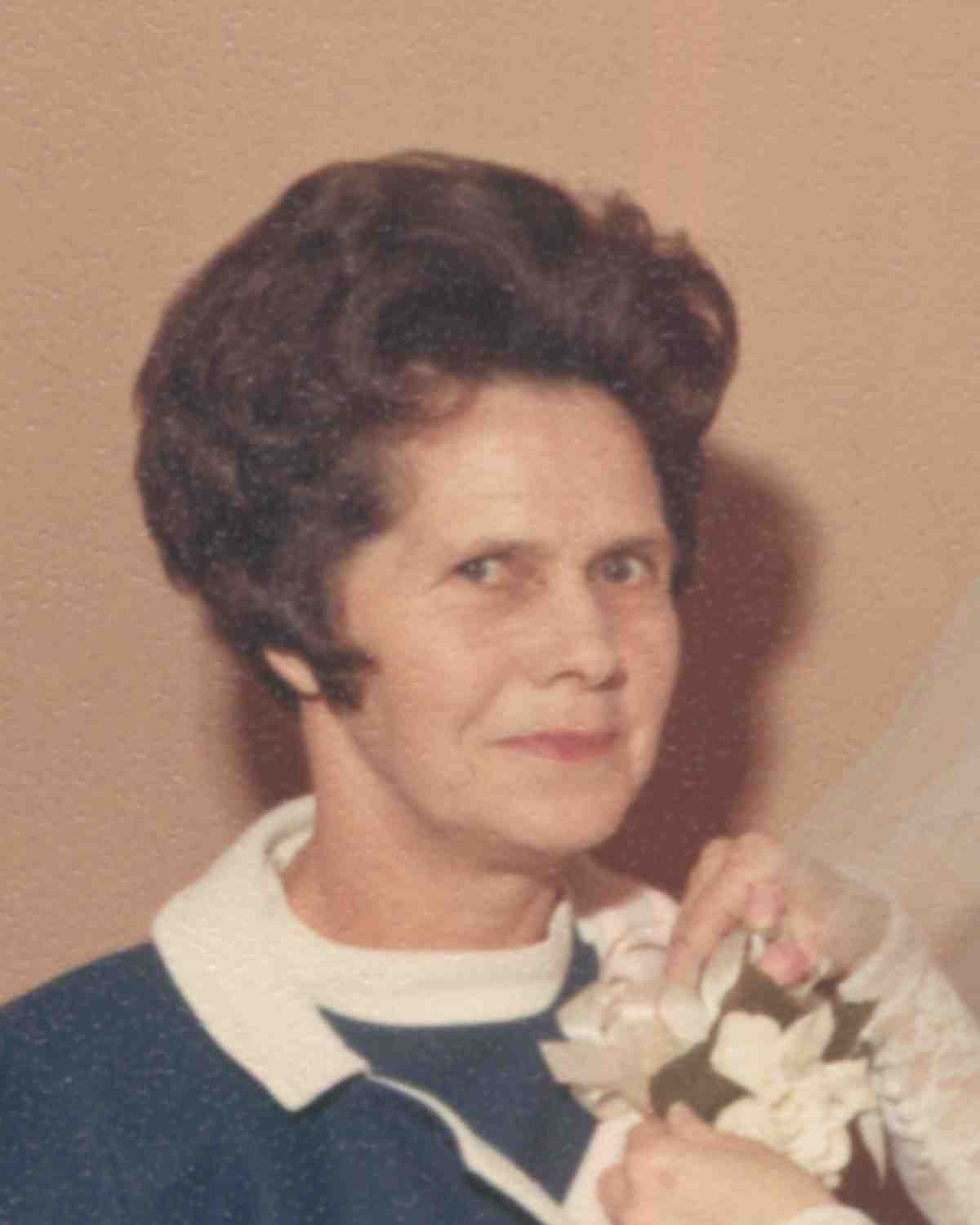
including all of her living siblings
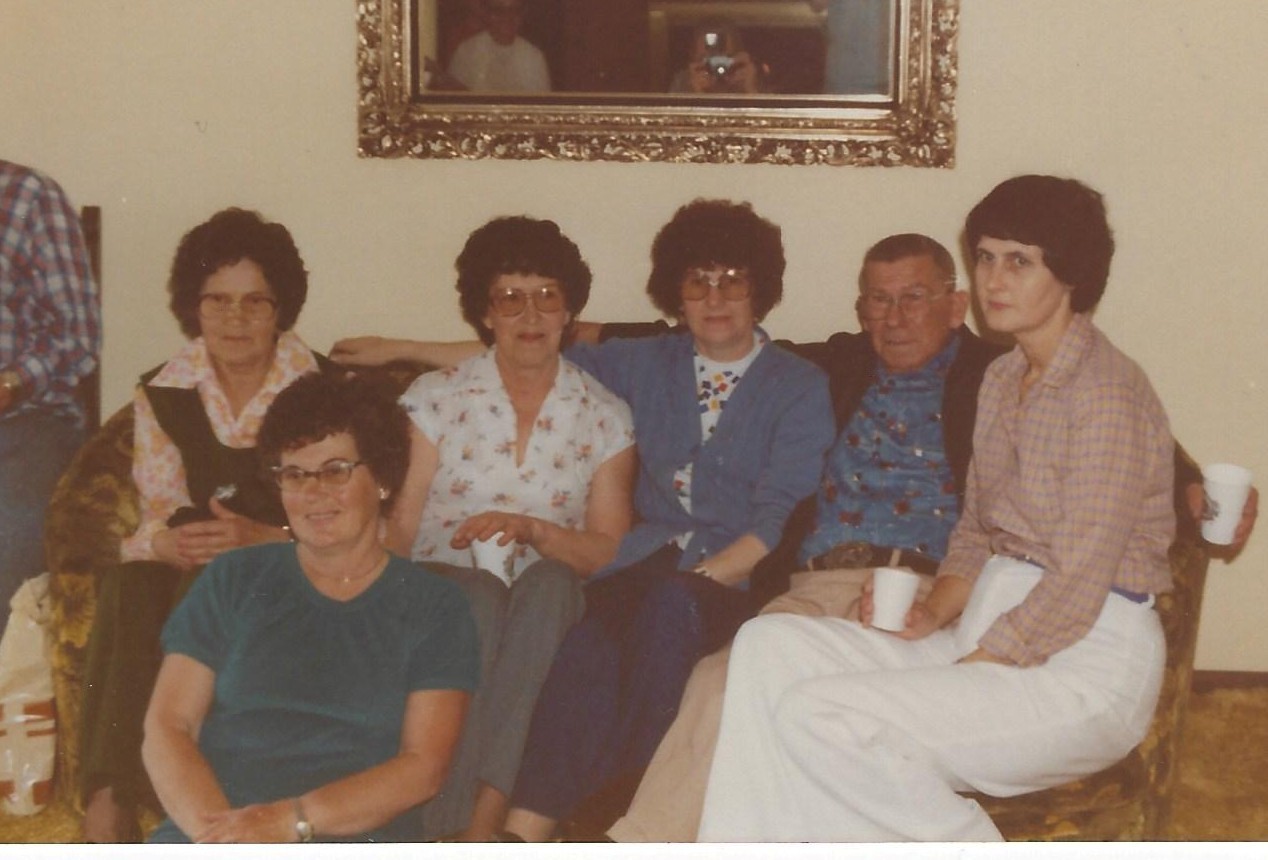
Also, all of my living siblings were there.
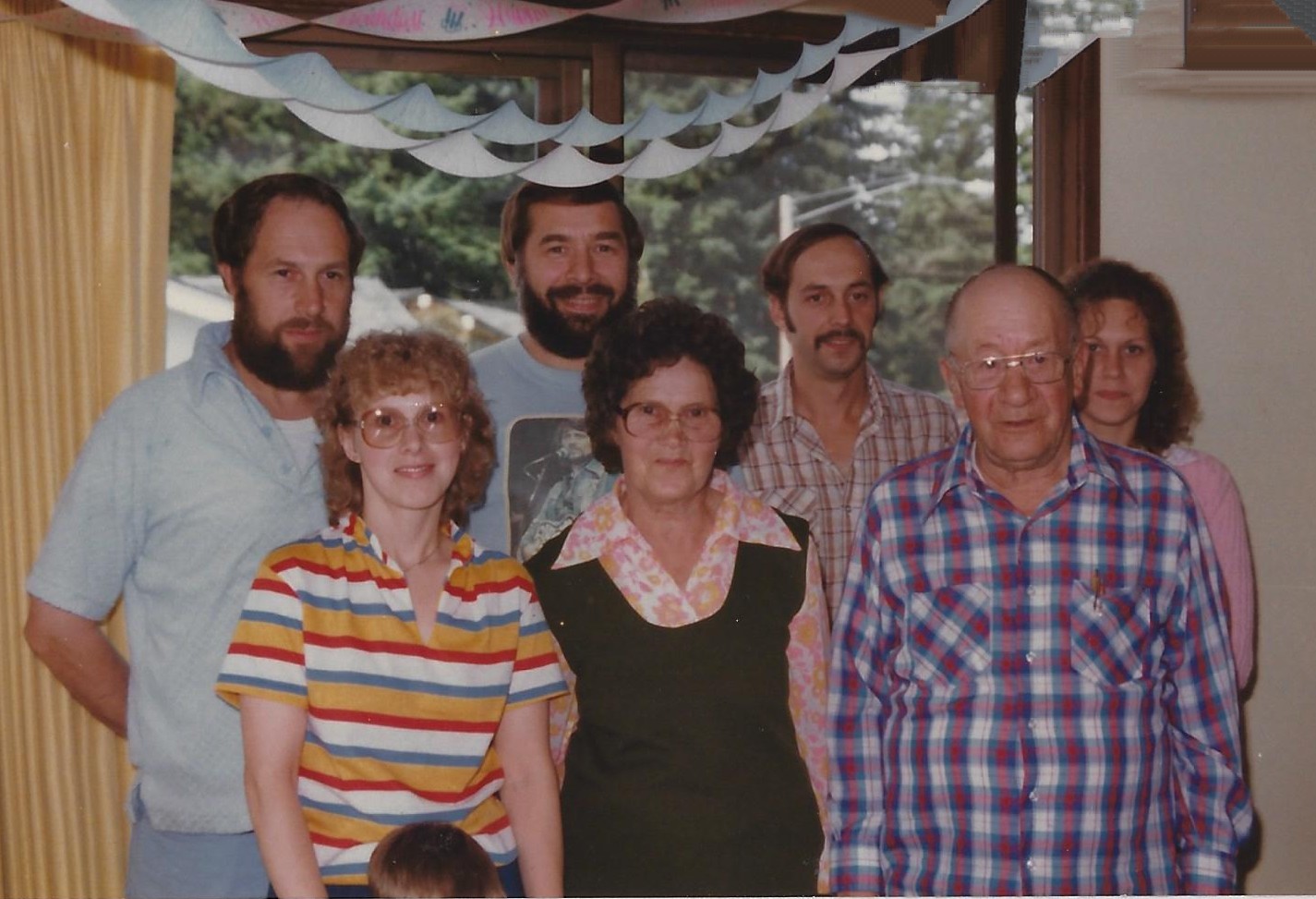
Birdie and I also made the cake for this occasion and we decorated it with concentric circles each one having the names of one generation. One point of note was that we had napkins monogrammed and we anticipated a lot would be used. We had under (make that over) estimated the family and hardly any were used. What need do Straders and Siewells have of napkins when we got our pants. But it was a great party and we got to see some relatives we hardly ever saw. Another high point was when Aunt Jean Siewell came and she had driven up with one window missing. Uncle Brown had shot it out with his shot gun. Whatever it takes to intimidate a wife and keep her in line.
Grandpa Nettleton celebrated his 80th birthday and we went to Grants Pass for that. All of Birdie's siblings except Don were there. Don had mysteriously disappeared, a not to uncommon thing in the family.
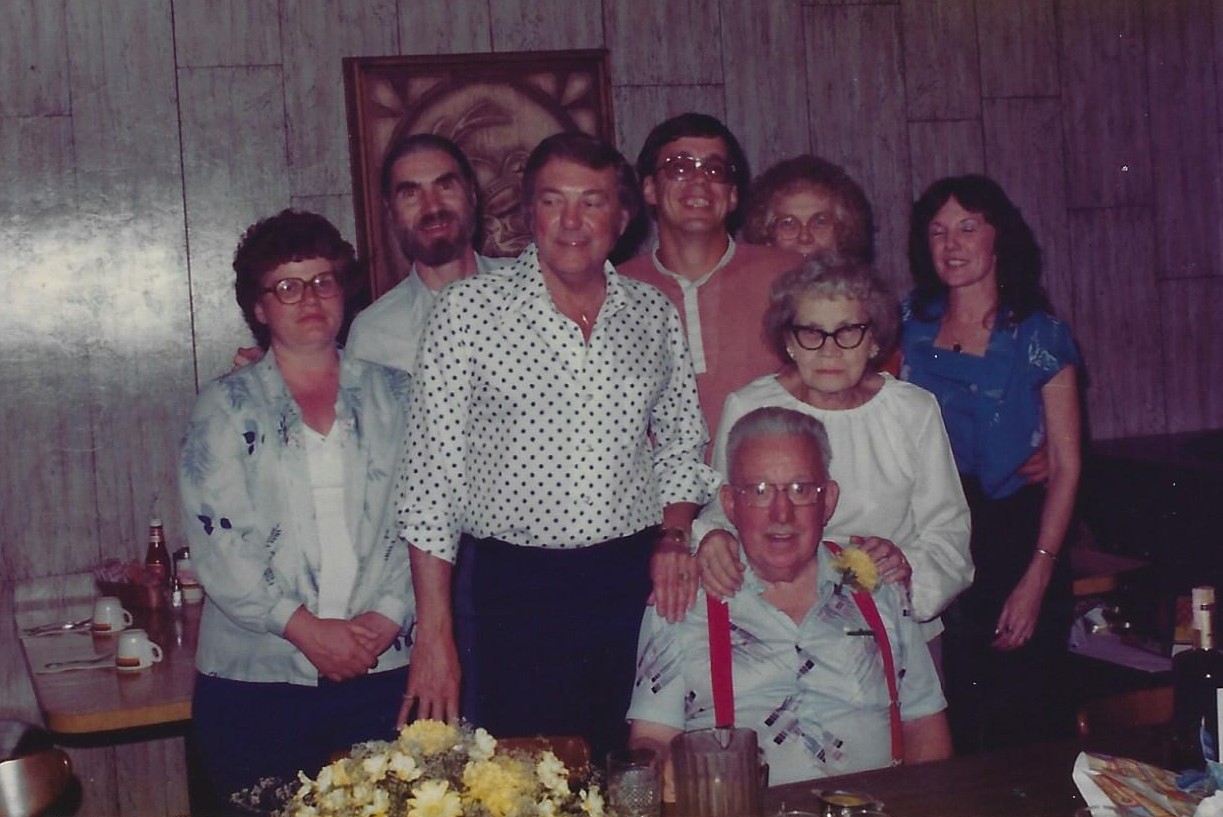
Birdie and I had developed some skill at birthday cake decorating when the kids were little. My Dad retired from logging when he was 77. For several years prior he had been a danger to all around him when he was operating a bulldozer since he couldn't see nor hear. So, they gave up their place in Murphy, OR and remained in Bandon a few years before they moved to Astoria. Just Birdie and I visited them a couple of years in which we celebrated a couple of birthdays with him including his 80th.
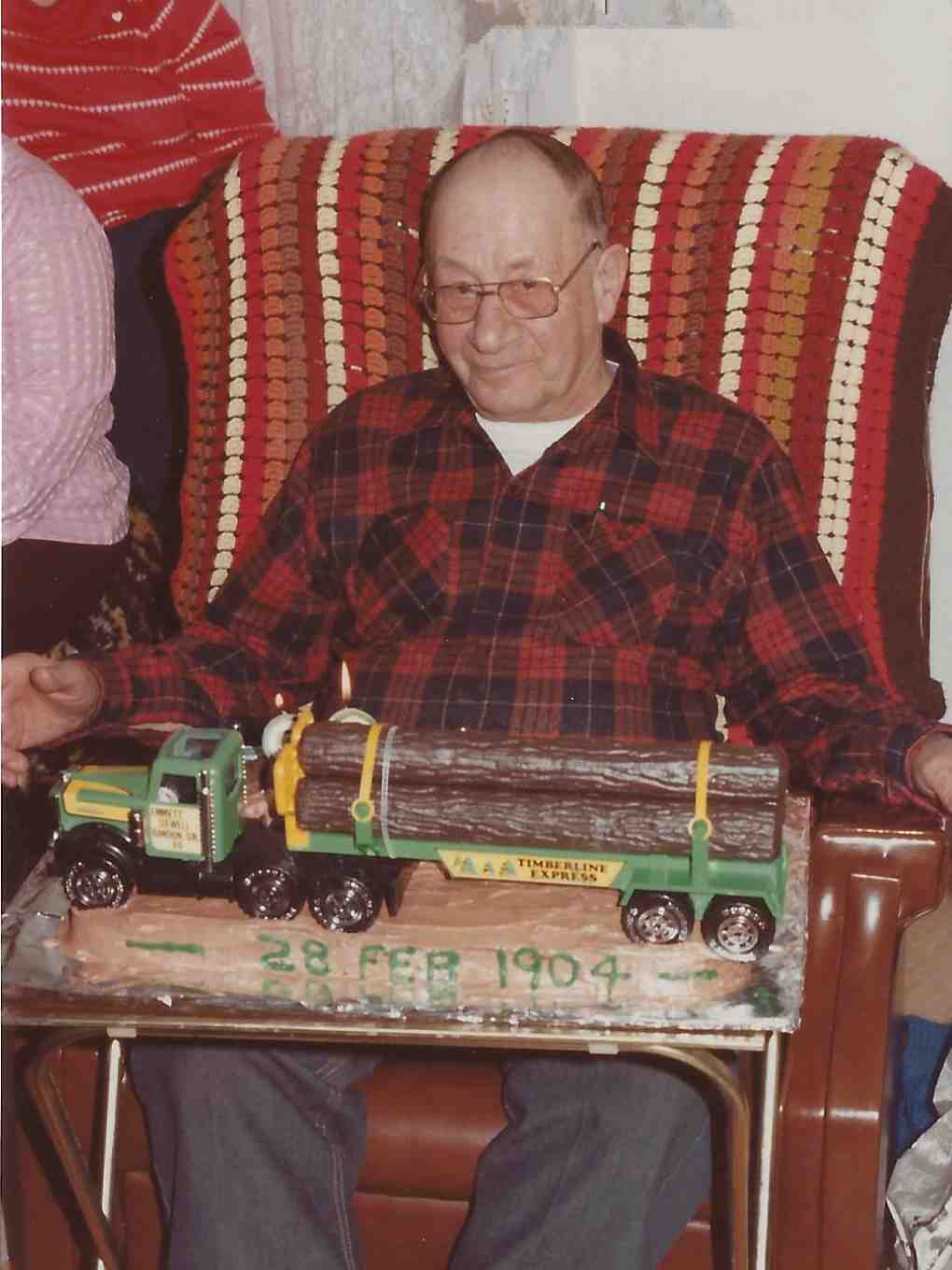
We made cakes of both his early logging career as a truck driver
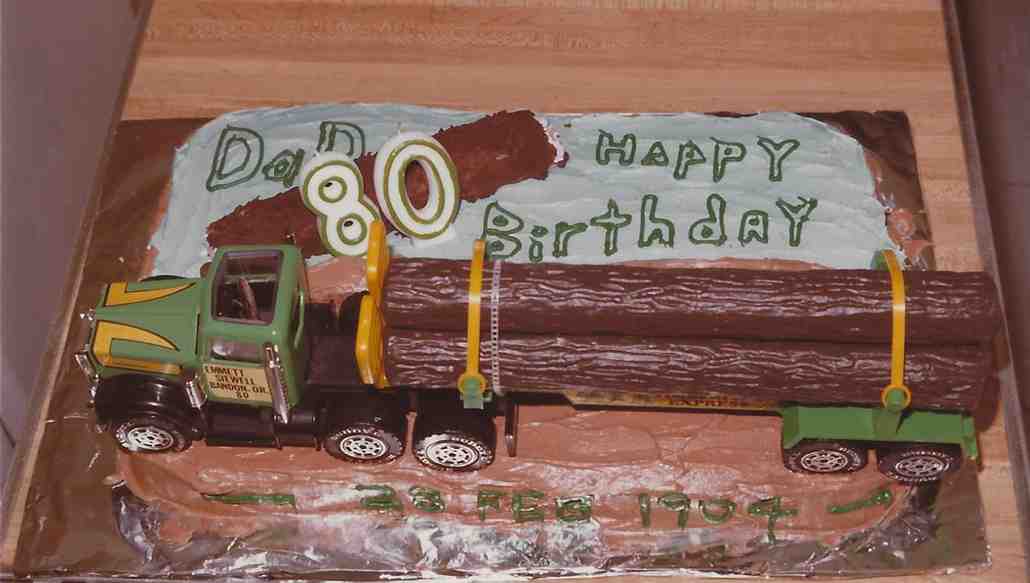
and his later years as operator of a bulldozer for cat logging.
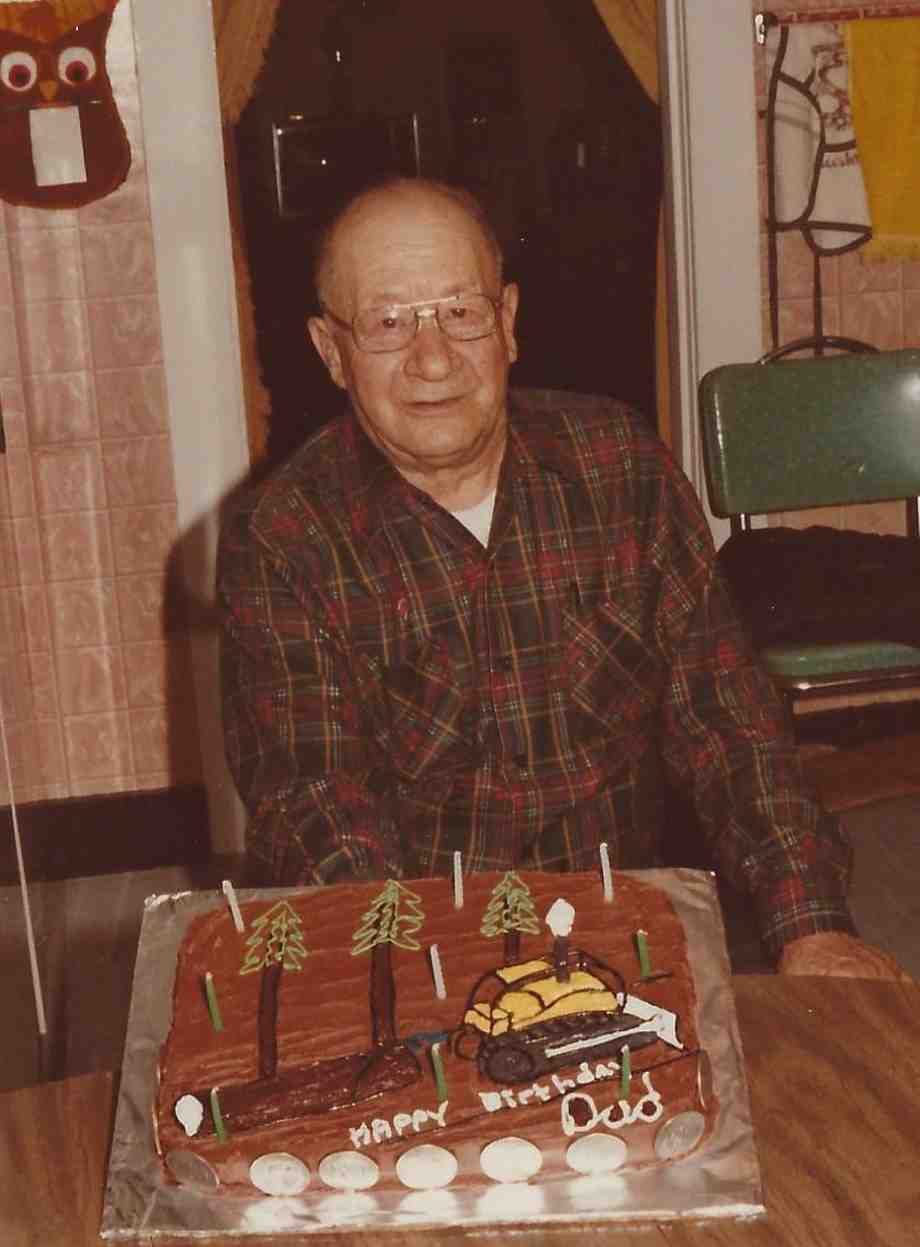
In December of 1981 we travelled to Bandon for some event which I have forgotten but we did celebrate Gilbert's birthday with him.
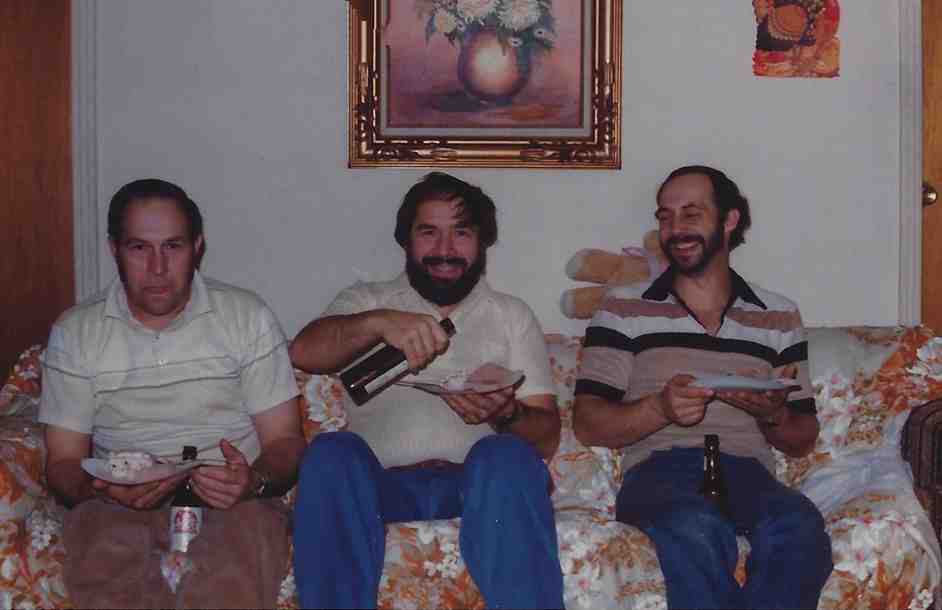
Lucky and his family were also there.

Mike Keegan was a friend and coworker at Tektronix and later in Colorado and then in Corvallis. The Keegans moved to Boise sometime after we left Colorado. Mike was working in the Disc Memory Division working on a huge project that was expected to capture the mass memory business but they were never able to make it work. Glen Moore was managing this project and after it failed, he moved to Corvallis and later worked for me in Supply Chain. Anyway, we visited the Keegan's in Boise and a couple of things of note happened: First, Birdie and I went to dinner one evening with the Keegans and we parked our car in the first parking space past an intersection. While we were having dinner a May Trucking Company truck cut the corner with his trailer, running over the curb and smashing the back corner of our station wagon. A couple standing there had witnessed the truck hitting our car and then driving on without stopping; so, the girl stayed and the guy followed the truck to see where it went and then they waited for us to come and they told us the name of the truck company and where it had gone. I don't remember all the details but somehow, we learned the driver had been drinking. The company gave us the run a round, not accepting responsibility, but when we got back to Albany, we got the car fixed and paid for. The car was drivable so our visit resumed. The next agenda item was for the families to go rafting. Mike and I came up with the brilliant idea of tying a rope between the two rafts so we could keep them together, after all the women and children were mere amateurs. We floated the Boise River and it was reasonably calm and peaceful. That is until we were passing a bridge and one raft went on one side of a pillar and the other went on the other side. Suddenly the rope idea was bad idea. The river was pretty slow but very powerful and soon the rafts were dumped. For most, the water was shallow, about knee high for Mike. The kids had life jackets so everything was okay except for the two littlest, Dave & Tim Keegan, who were floating away. Mike quickly grabbed his youngest but I had trouble walking fast enough in the river to catch Dave. Mike was able to go faster than I could and he was able to rescue Dave also. Another omen about rafting but it too was ignored.
The boys and I picked up our archery hunting again in Oregon. We heard about a place up Thomas Creek (a ways past Scio) and we tried that numerous times. It was an area that had been logged several years earlier and was mostly underbrush with lots of signs of deer but few sightings. We had the same success we had in Colorado; that is going and coming home provided good driving practice for some of the boys. I would be remiss if I didn't relate one return trip when Mike was learning to drive. We were in the pickup and I was giving instructions on when to shift to the next highest gear. He had it going at a pretty good clip when he went to shift into fifth gear and instead put it in first and when he released the clutch the wheels screeched and we almost all went through the windshield. This went a long way toward making me a zealot for fastening seat belts. Making it the law helped too! For most of my life, cars hadn't even had seat belts! I became a believer! It is still somewhat surprising for me yet that he was able to get it into first gear. He was a talented boy.
During the years of 1977-1983 I had more than enough car experience. There was continuously at least one learning to drive, then obtaining a car and then trying to keeping it running. We gave the VW bug to Mark for his graduation, but it was past its prime and he soon traded it for a Mitsubishi Arrow. This was not much trouble for me. However, Teresa's first car would be different. We went to the car lot to look at a Toyota they had advertised. They couldn't get it to run. I found an ignition wire that had become disconnected and hooked it up and the car started. But the salesman was already on the defense and we got a pretty good price. This car came to an abrupt end. Most 18-year-old are a bit short on responsibility and Teresa always tried to excel in all things, good and bad. So, she had decided to skip school that day and go for a ride. She also convinced several of our other children this was a good idea to have a little excitement of a random skip day. So, they were out driving around and ended up on Riverside drive. Now Riverside drive is a nice, quiet two-lane road but at one point it had a sharp, right angle curve (that has since been modified). She came into this turn with too much speed, lost control and after weaving down the road a ways, ran into a concrete culvert. Luckily no one was injured. The car was totaled! We will see later how little both Teresa and I learned from the experience.
It had taken longer than expected to get Teresa through Dad's drivers training, so Matt was late getting started. A couple of incidents stand out. Matt had a Mazda with a rotary engine. He and I both learned a lot about rotary engines. Mazda pursued that for a number of years and had pretty good success. I think the concept was a little ahead of development of materials that could make it reliable. I don't recall any particular problems we had with it, but perhaps Matt does. He also had an old pick up that was several decades past its prime. One day driving towards home on Crocker a tie rod came loose and he had no steering control. The fact that the tie rods are not all that positively connected and can come loose and they are crucial to any steering control is a scary thought. Thankfully Matt was going slow enough to avoid an accident. I think that when Matt decided to join the Navy the value of his cars was not a big issue.
I don't remember any moments of terror while teaching Kirstin to drive but that doesn't mean there were none. I was pretty hardened by then. The only car I remember for Kirstin
was the new Toyota she bought when she had a job at HP. It was a nice car and she took great care of it.
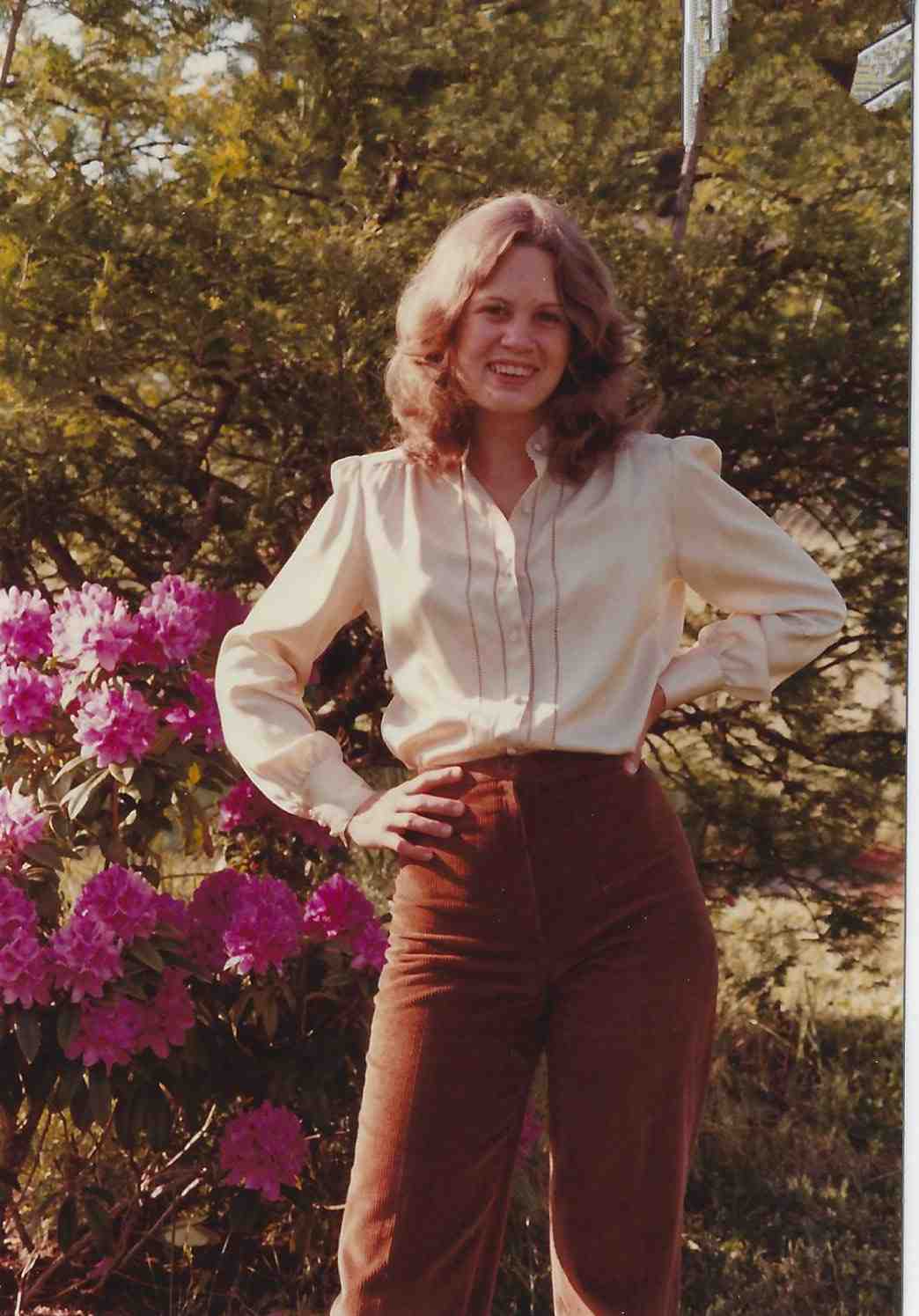
I have already mentioned a moment of terror with Mike on the hunting trip. He became an advocate for the Chevrolet Chevette. This was a pretty good design. It was small and economical. It also had the "iron duke" engine that was very reliable. Car companies had been trying with limited success since Chevrolet introduced the Corvair in the early 1960's to develop the aluminum block engine. I am not sure any were really successful before GM's NorthStar V/8 engine in the late 80's or 90's and it is not bulletproof. So, it was a great move that Chevy went back to their old iron block 4-cylinder engine for the Chevette. I think Mike drove Chevettes from high school, through the Air Force and until he finished college and started teaching.
Birdie and I celebrated our 25th anniversary in 1982.
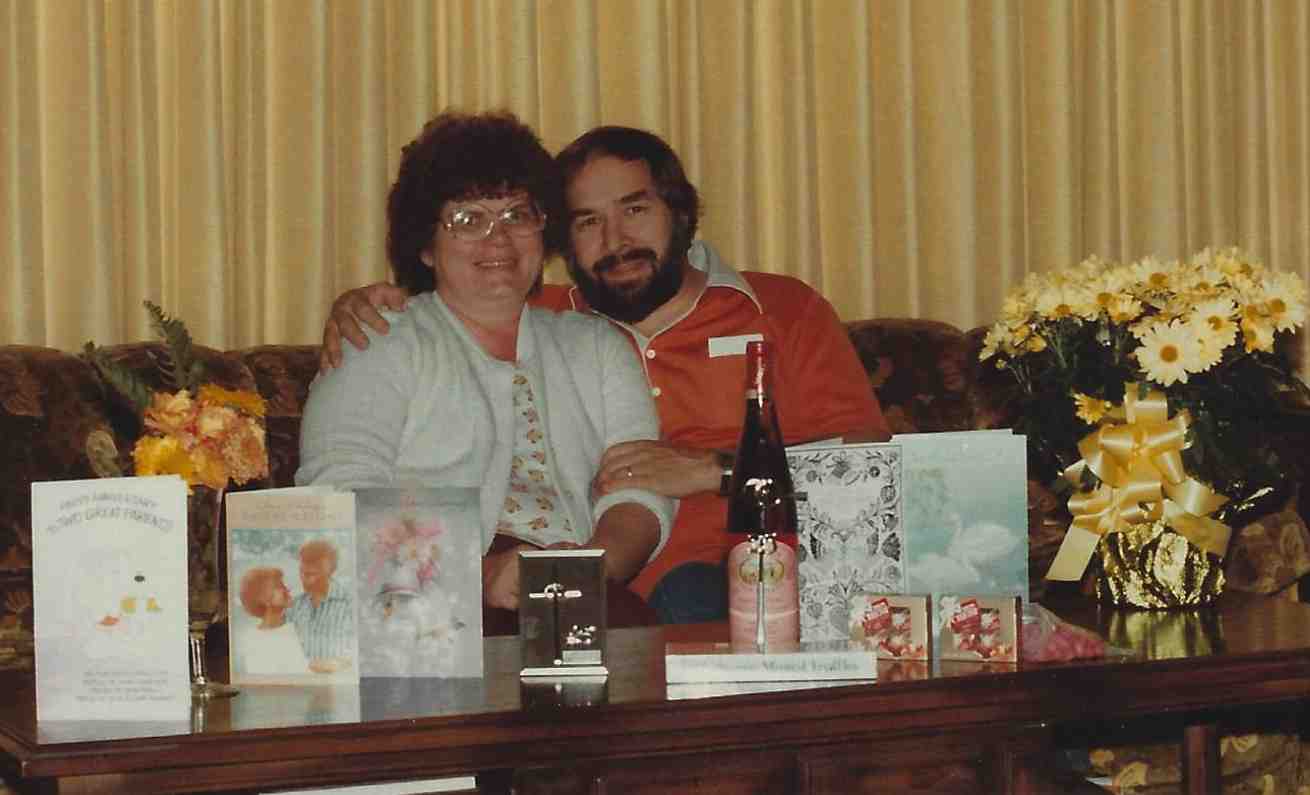
We couldn't believe the time had passed so quickly. What do they say, 'time passes quickly when you are having fun'? Speaking of having fun, Our family (Mike was off defending our country) had grown. We were even grandparents!
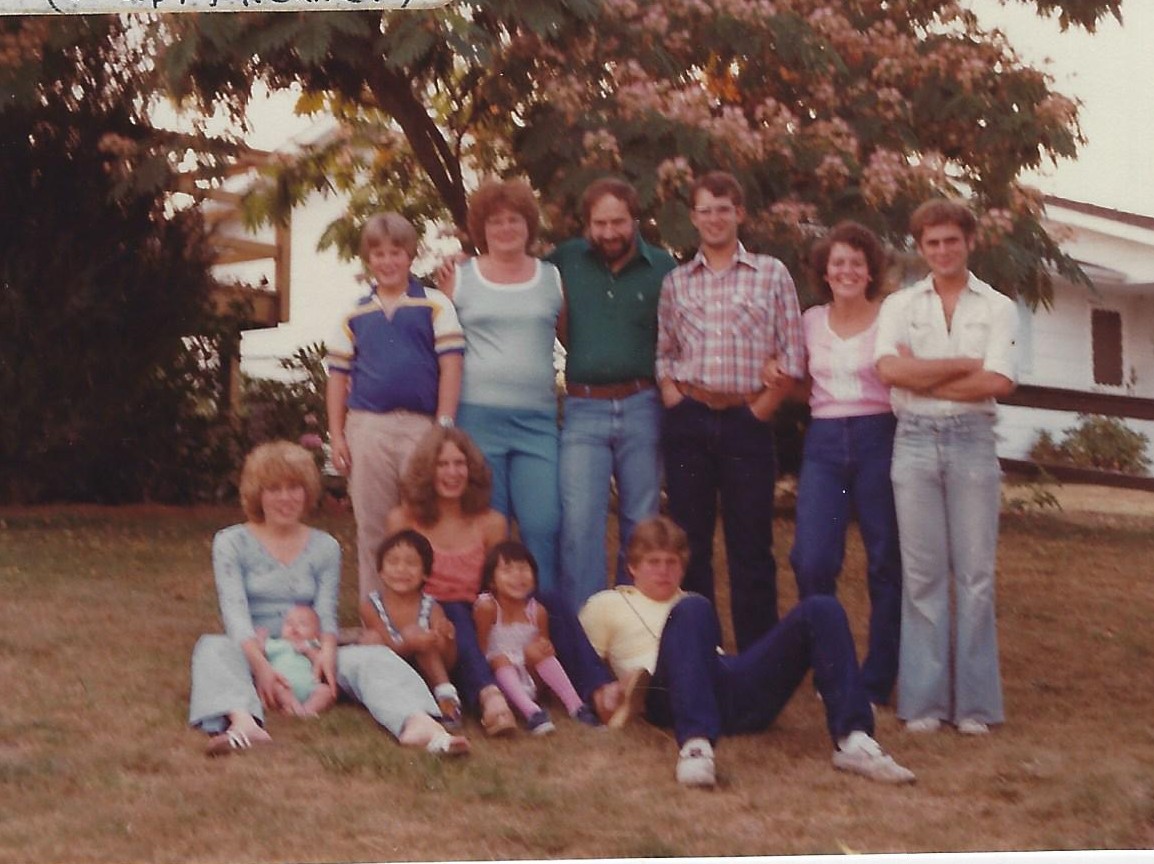
From an early age, Paul took an interest in working on cars (an interest that I sometimes did not appreciate at all, let alone enough). Often, he was the only one who would come out while I was working on cars and offer to help. However, when working on cars I was never in the best of moods because I was always doing something I had never done before, with the wrong tools and with the cheapest materials. And I regret to say I would soon send him packing. So, it was probably some sort of divine intervention which led Paul to purchase a Fiat X1/9. This was a real sporty convertible with a rear engine. It looked great, but as with most things Italian was a maintenance challenge. Perhaps to get even or from a guilty conscience or both or most likely because when he was older I enjoyed working with him, I got involved from time to time. One time Paul needed to do something to the rear suspension and I was helping and we were taking the rear axles apart. As we pulled this one section apart, we heard this tinkling, tinkling, tinkling sound. Little round spacers had started falling out and rolling around on the floor of the garage. As we watched, more and more of these spacers fell and rolled around - many, many more. As we took more parts loose, more spacers fell. As a final resort, we read the manual and it pointed out that it was very important to keep track of which spacers came out from where and in what order so alignment can be maintained on reassembly. One of those instructions that by necessity is best ignored. We put them all back in some random order and it worked fine. Those Italians know how to design cars! Humph! The other challenge with the Fiat was when it caught fire in the engine compartment. It was an electrical fire and burned up all the wiring; the harnesses became inseparable molten masses of wire and plastic. Paul managed to get it together and running again, a miracle in itself. But I think he was losing some enthusiasm by this time. He had found a Chevrolet Monza at a lot he was interested in and was negotiating with the dealer. I knew the offer the dealer had balked on which was what Paul wanted to get it for. I went down and since the dealer didn't know me, I pressured him to sell it for a good, cash price (Paul's price) right then or I was gone. He agreed. Paul got a lot of use out of this car going back and forth to school in Monmouth. It was a horribly difficult car to drive. Nothing was power and everything was hard: hard to turn, hard to stop and hard to get comfortable in. I always thought it was a remarkable tribute to Christie that she could actually drive that thing.
Teresa talked to a Navy recruiter and joined with only the recruiter's assurance that based on her high scores on the Navy tests she would get sent to a good school after boot camp. Based on my somewhat dated military experience, my advice was to get it in writing before signing on the dotted line. I have known few, if any, 18–25-year-olds who listen to advice from their parents. So, Birdie and I drove her to Portland for the final swearing in and departure. We had earlier taken Matt and seen him depart up the same long stairway. However, Teresa soon reappeared and sadly reported that they had told her she was too heavy for her height. Teresa was in great shape and there was no way she shouldn't be accepted. I marched back up with her and I don't recall the specifics of the debate, but she ended up in the Navy and was off to boot camp in Florida.
After boot camp, they predictably and nonsensically did not send her to a tech school but rather sent her to Seattle as a yeoman.
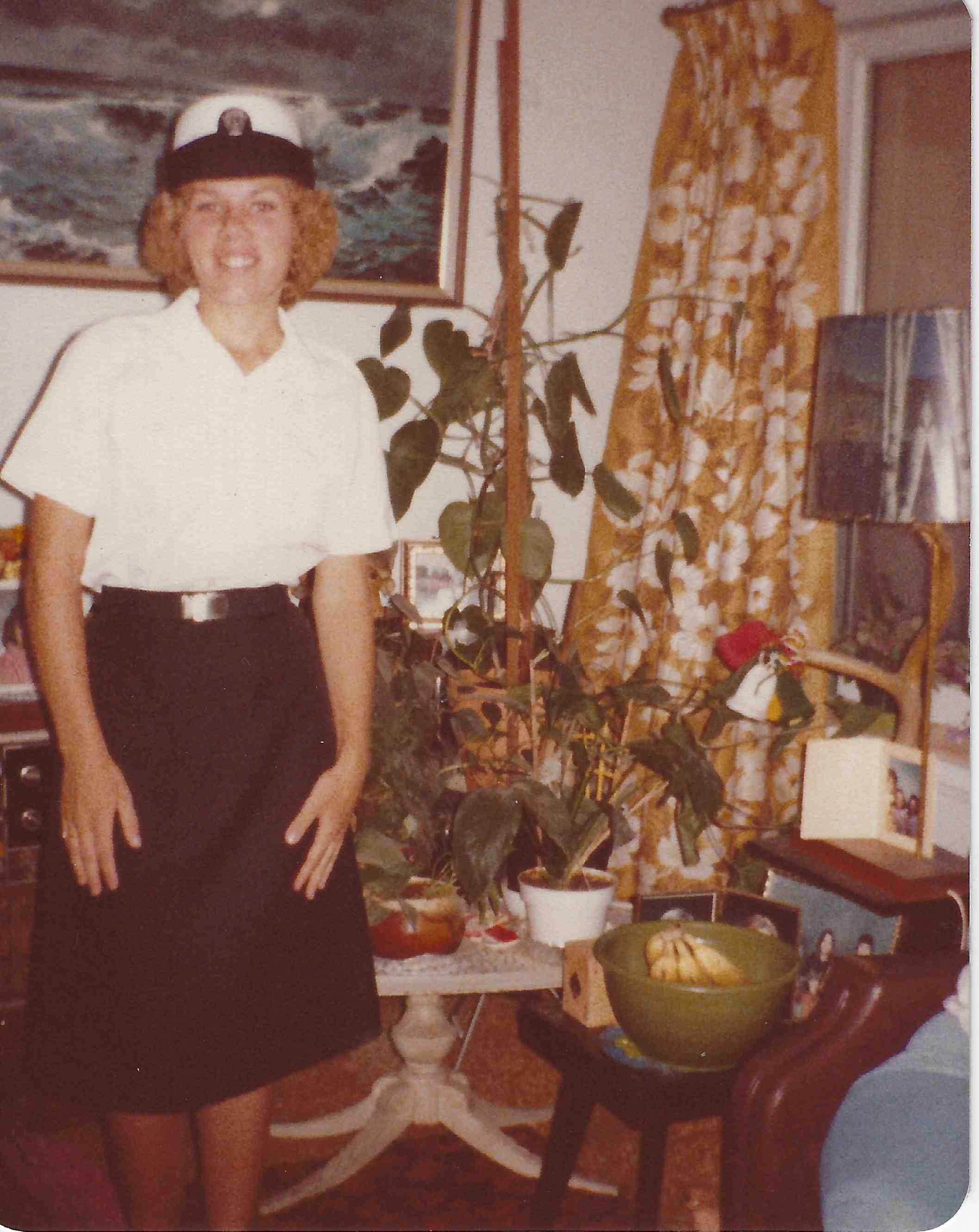
On one of her trips home, her Mom and I surprised her by working out the purchase of a new sharp, red chevrolet Monza.
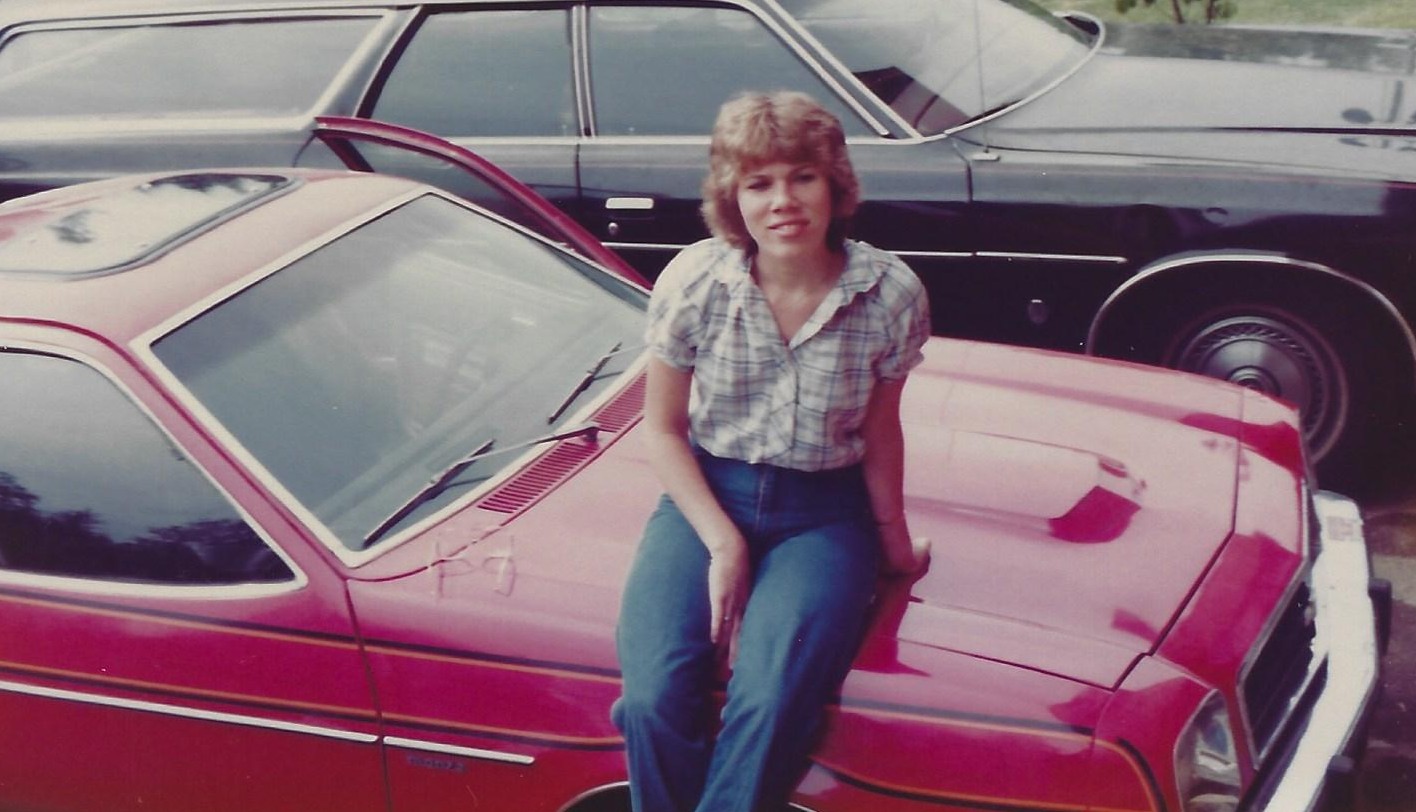
We essentially loaned her the money for the down payment and first expenses and she purchased the car. This did not come to the end we envisioned as she got into an accident in Washington. Both Teresa and the car recovered but it was never the same and Teresa sold the car.
Possibly on her own and possibly with some influence from me, she decided she would like to go the Air Controller school and be one of those people in the tower that controlled all aircraft movements in and about the airport. So, I started a writing campaign to convince the Navy that my daughter was at the top of Navy personnel for intelligence, the Navy advertised they needed good people, and here they were wasting her talent. I started with her commanding officer and when I got unsatisfactory results from him, I wrote to the Bureau of Naval Personnel (BuPers) While in the Navy and working in our Operations Office, I had to send the squadron's monthly reports to BuPers and so I was not that daunted. I hammered the theme that they spent millions advertising for talent, and then when someone brilliant signed up, they just wasted her. It apparently hit a nerve. I got a phone call from her Commanding Officer and he assured me he would get her into Air Controller's school. But this path was not to be, Teresa had fallen in love and her priorities had changed and my efforts were for naught. She demurred on the school and transferred to Southern California. She later chose to get out of the Navy. She lived with Maxine and Gene near Seattle while she was pregnant and then had our first grandchild, Luke at Madigan hospital in Fort Lewis.
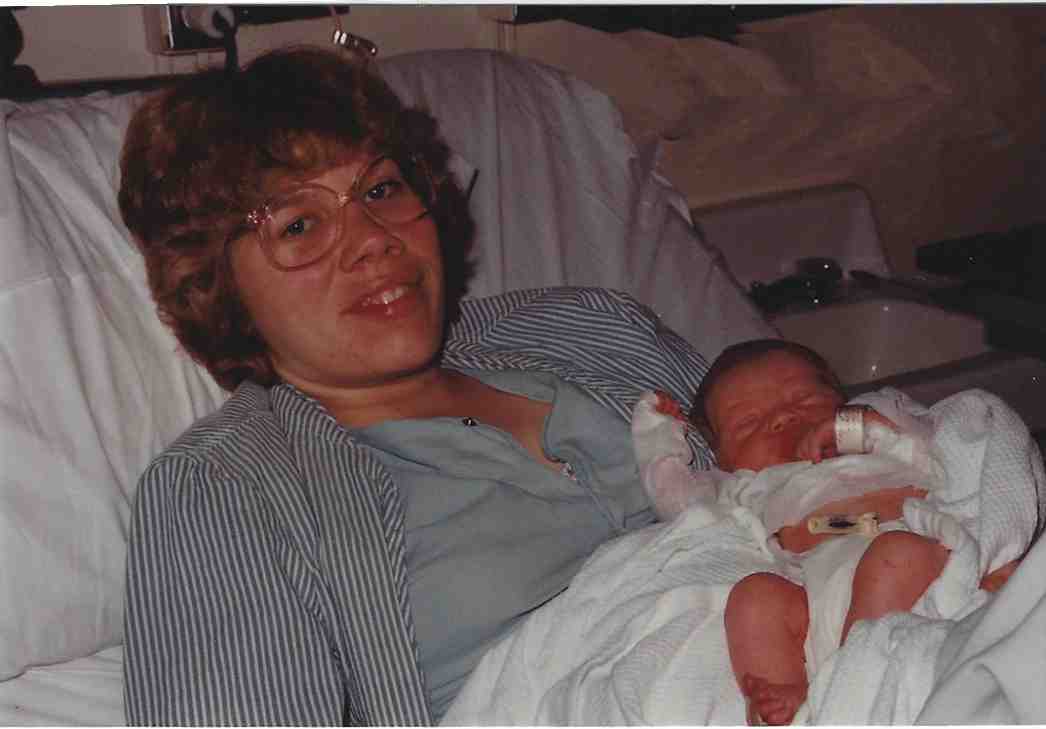
Birdie and I went up immediately after the big event.
“CH7_V21_Lukeborn.mp4” could not be found.
Birdie called Luke her little sunshine and w enjoyed his first few years.
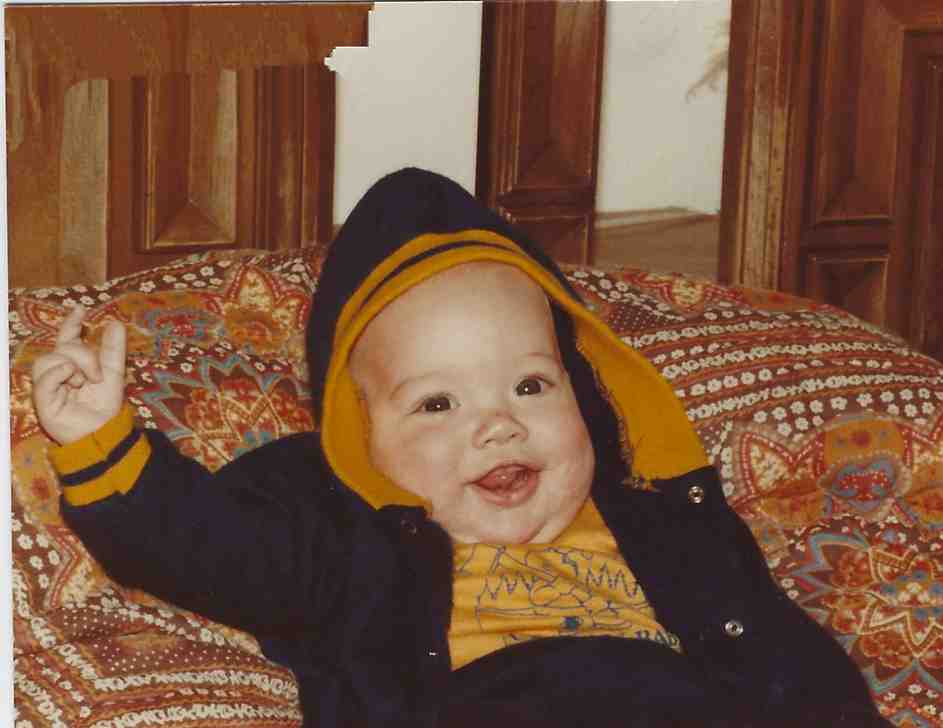
her little sunshine and we enjoyed his first few years. Even the great grandparents were enthused.
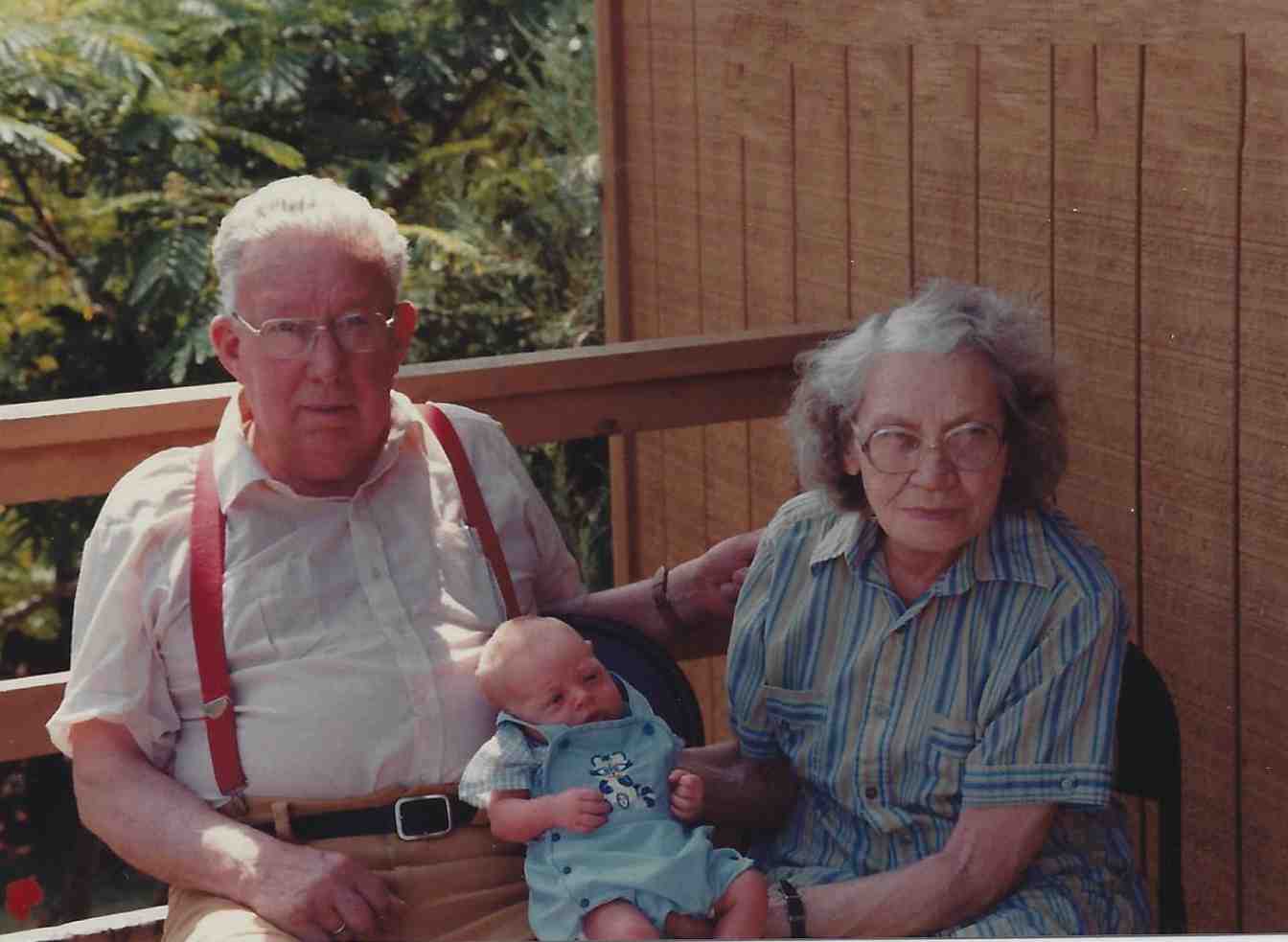
Luke's biological father, Chris, came down to visit one Christmas; this was a year or so before Luke was born. We played some pool and one of his stratagems was rather than try to knock in one of his balls he would to try to leave the cue ball in a position that the next player could not play from. This became known (by us) as the "Australian finesse". Sometime after Luke was born Chris returned for a time. One of the songs that was popular in Malta and which I had enjoyed while in the Navy and stationed in Malta was "A pub with no beer" by some Australian singer. Chris was familiar with it and after he returned to Australia, he mailed me a CD with that song on it. The movie, "The Man from Snowy River" also came out about this time. Chris told us it was based on a short poem by an Australian and Chris send me a book of his poems that included this one.
Kirstin played both varsity basketball
“CH7_V18_baskballSouth.mp4” could not be found.
and volleyball at WAHS.
“CH7_V20_Kvolleyball.mp4” could not be found.
She was pretty good but the WAHS girl's teams were in the early phases. West volleyball teams in recent years have won several state championships and Kirstin's teams laid the groundwork. We bought a decent volleyball net and started playing in the field. We had some good family volleyball games.
Birdie's longtime friend, Marie, had moved to Pendleton and we went out to visit and also go to the Pendleton Round-up.
“CH7_V31_Pndltonroundup.mp4” could not be found.
Turned out that not everyone fully enjoyed the Pendleton round up. First there was the flies. I suspect Pendleton is bad for flies always but during the Round up they are out in force. Birdie was not impressed and did not attend daily events. During the weekdays they had a lot of events to sort out the top performers and then on the weekends did the finals. Some of the boys and I spent time at the daily events. One memorable event happened. There were quite a few Indians at the Pendleton round up and they had set up a tee pee village with probably three dozen tee pees, some of which were quite large. From our vantage point in the stands we could see the tee pee village in the background. One day as we were watching these tee pees started tumbling over and in a few seconds a swath of fallen tee pees ran through the center of the village. Later we found out that some young Indian boy had started up a tractor that was near the village and was unable to control it once he got it moving and it plowed through the village. Several were injured but no one was killed. The Round up ended with a gala show that the Indians put on that was very good.
Kirstin graduated in 1980.
“CH7_v19_grad.mp4” could not be found.
She soon got a job at HP. She was a great help with Joe and Gwen when we got them. Some days Mom had had it by the time she got home from work and Kirstin would take them for a while and give her mom a much-needed break. Kirstin didn't have to do any of the major discipline so a good rapport with Joe and Gwen developed which continues even now with Joe. A couple of episodes around this time were memorable. First, Kirstin was dating a boy who had an old but jazzed up car decked out with a desirable stereo. The two of them parked in a somewhat secluded area of North Albany Park and did who knows what to pass time until it was rather late. Then the car wouldn't start. So, they walked to our house and pressed me to go help get it started. I was more inclined to help in the morning and when he protested that someone would break into his car and steal his stuff, I pooh poohed it! So, he decided to stay until morning and then I went up with him to start the car and whoa and behold, someone had broken in and stolen his stereo stuff. Kirstin didn't marry him.
Mike possibly had the most natural sports skills in our family. He was an outstanding pitcher in baseball and he was an excellent shooter in basketball. He was also great in our family football games and one of the best pool players. The rest of us used competitiveness to even the field.
Mark joined the Air Force and he and Lori were married by Father Stead in September 1980.

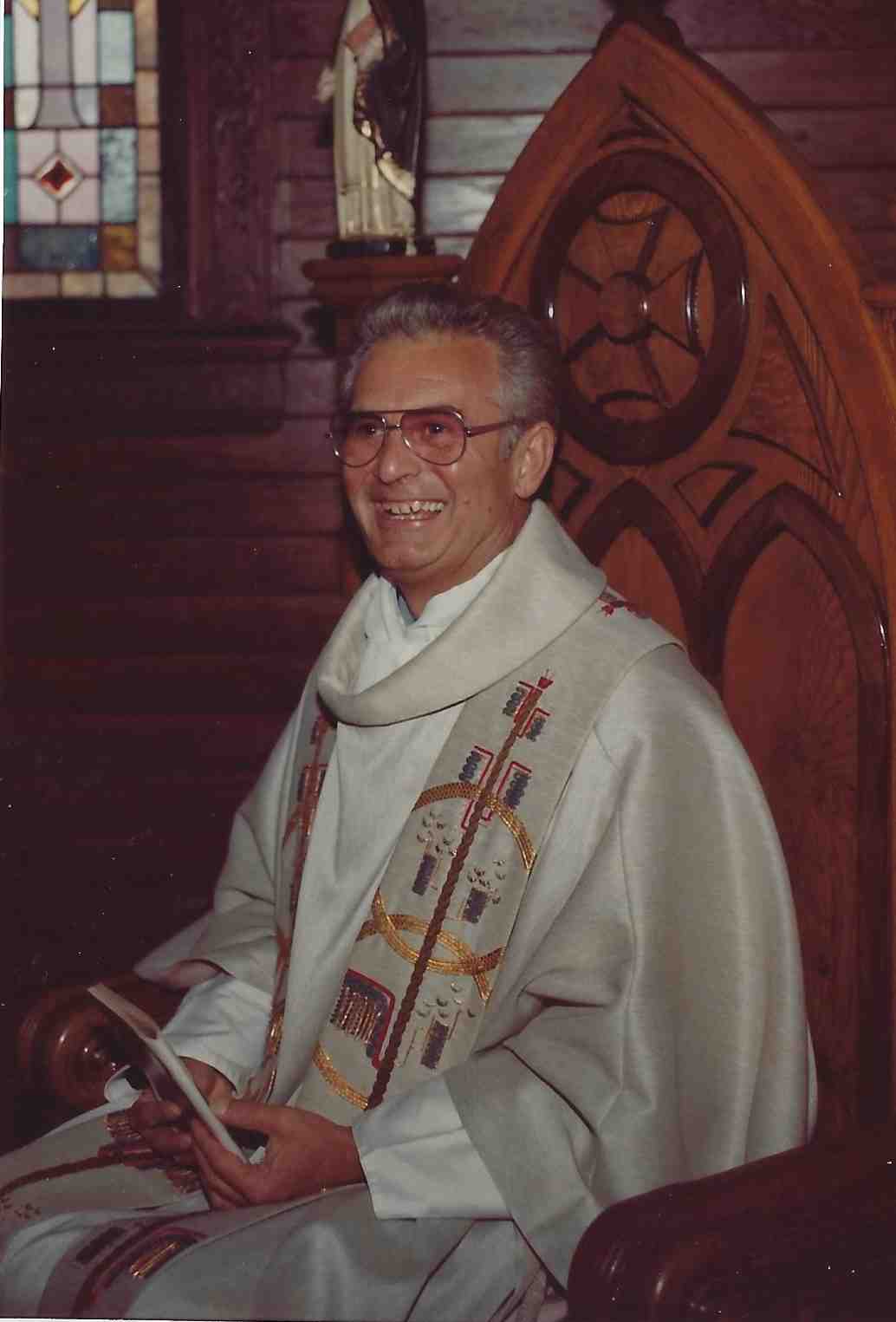
They got married in the old St Mary's church in Albany. Birdie made the flower arrangements and they were impressive.
“CH7_V25_oldchurchflowers.mp4” could not be found.
The reception was at our house and I handled the rum punch, which went over well. Mark was stationed at Cheyenne and they lived there. Cheyenne was like Colorado Springs, the snow never melted "it just blew around 'til it wore out. One of the popular events was racing with snowflakes." One year when Mark and Lori were coming home for Christmas on the train they almost froze to death, a more interesting story than experience.
While in Colorado Birdie and I had talked about the fact that God had given us so much that we should share it. So, we pursued adoption and talked to those who took care of such things in Colorado. My best recollection is they were government employees (County or State?). Anyway, they told us how many adoptions they did each year and it was a very small number. The main limit was the bureaucracy of the process and the fact that government employees by nature of no consequence for poor performance and no reward for excellent performance tend to crowd the former. We finally gave up in frustration
However, we again talked about it around 1980 soon after Birdie 'retired' from HP. One of the employees that Birdie had worked with at HP was Christine, one of the original adoptees from Korea by the Holts of Creswell, OR. I initially contacted them (Holt adoption agency in Eugene) and I don't remember what but something discouraged me. So, I opened the phone book and looked under adoptions and one of the first on the list was Albertina-Kerr, the orphanage in Portland where Birdie's Mom had worked in the early thirties. They were now doing adoptions. I called them and we were assigned to Nina Johnstone'
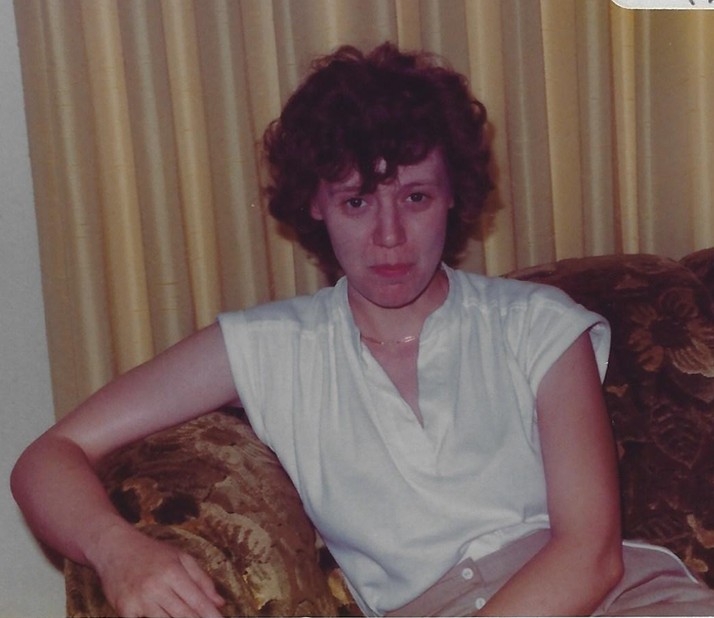
She by some coincidence was an only child of a family that subsequently adopted a large number (I think ten) of the Holt Korean children. (After Holt had so much trouble with the red tape of our government to adopt Korean children, he helped many others and eventually set up the Holt Adoption Agency.) Anyway, she said that they had a number of children available who were Native American from Canada. We decided that would work so Nina sent us pictures of a little boy and his sister. She had told us to look at these and then she would send more until we saw one that appealed to us. We realized that God was involved in choosing the ones that were sent, so we decided we didn't want to go through any process of looking at pictures and trying to choose. We started the adoption process and before long we were scheduled for a visit by Joe and Gwen. The social worker from Winnipeg would bring them to Portland and we would have them for a week. In retrospect this is a tough ordeal, both for the children and for us. First, we were throwbacks from the generations who believed children were supposed to behave to thrive in society as opposed to the current generation, which expect society to change to accommodate their children; and further, that consequences for misbehavior of young children was necessary to achieve the former. We were advised by Nina not to discipline the children in front of Margaret, the social worker from Winnipeg. So, the children arrived and we went to Portland to a restaurant just at the bottom of the hill from OHSI hospital, which had a large outdoor area for eating. Having been warned, we assumed Margaret was still in charge of them. I don't know what she decided but no discipline was in effect and the kids were terrors. They ran around annoying other patrons at the restaurant and Margaret just ignored them and kept talking. We were appalled. Finally, when Joe had taken food off the plate of one of the customers and so annoyed them that they got up and left; we did our best to end it and get out of the restaurant and get the kids home to our house. The rest of the week was pretty uneventful in comparison. We understood that no major progress would be made in a week, and it wasn't. It was traumatic for the kids to be left with strangers. So, we all made the most of it and Joe and Gwen went back to Winnipeg.
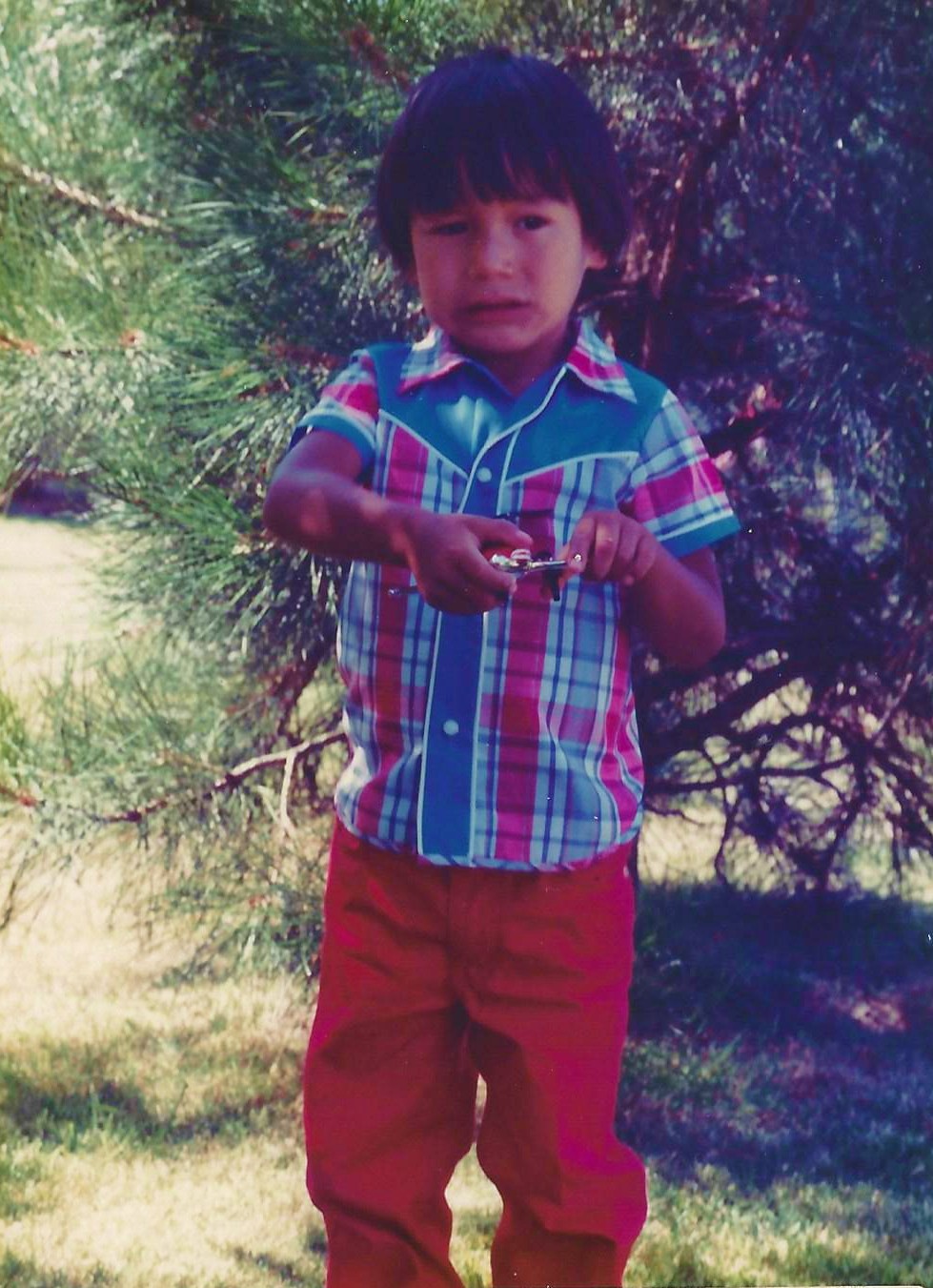
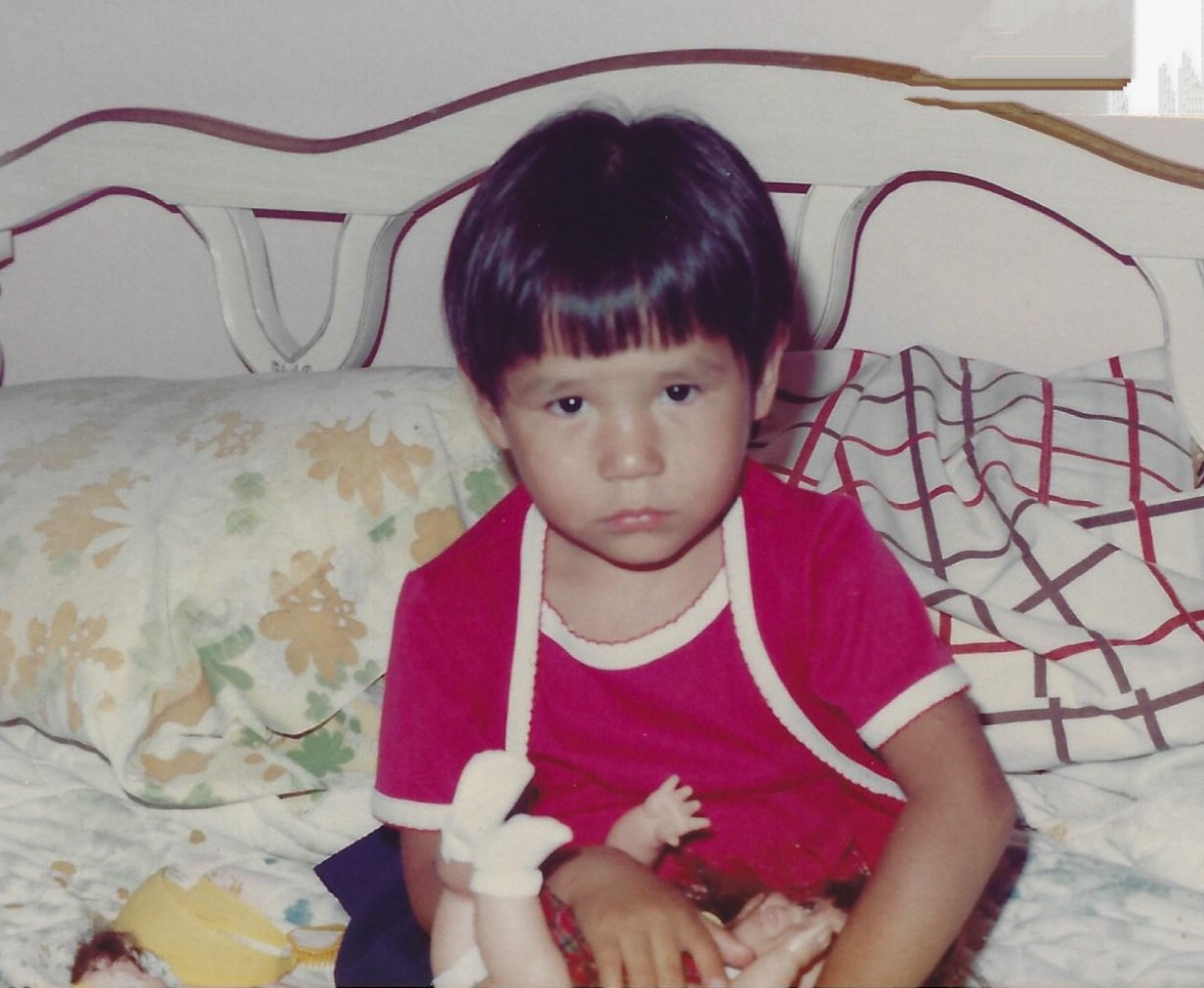
All of the hurdles were overcome and we proceeded with plans to go get them and adopt them. There was a time period, I think one year, after we got them into our home before we could actually adopt.
So, Birdie and I flew to Winnipeg to pick them up. We stayed there several days and went to visit them in their foster homes. Joe was in a group home which was ran by Ruby Piche'.
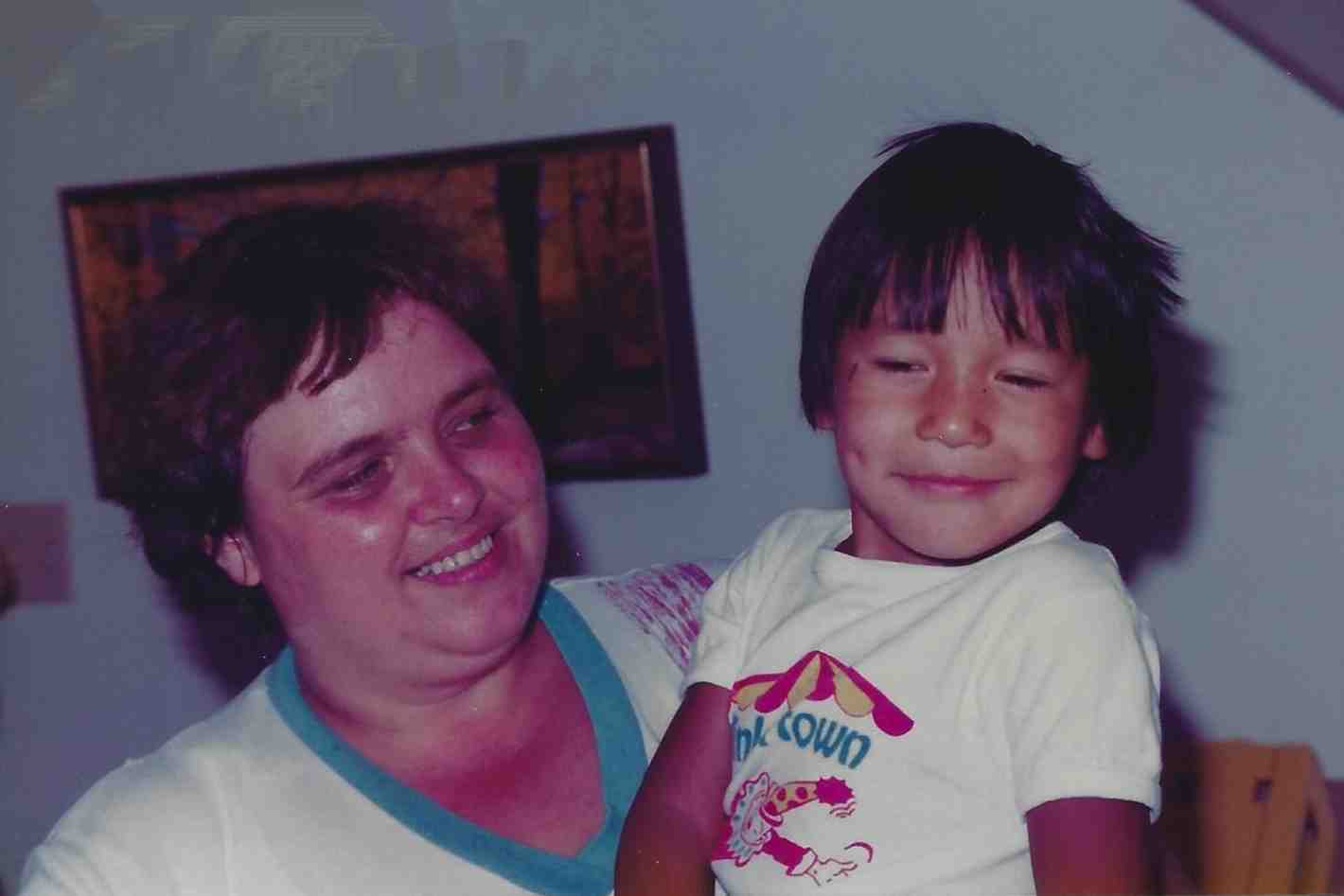
Ruby and Birdie hit it off pretty well and communicated for many years until Ruby passed away following heart surgery. Note: The universal health care system of Canada, which many in our country want to adopt, put off the surgery for eight months compared to my surgery in 1994 which occurred within two weeks of my first noticing pains. She never fully recovered from her surgery. Through their friendship we were able to follow the lives of at least one girl who was in the group home with Joe and it was kind of sad to see her basically follow the same path of bad choices that her parents had made that got her there in the first place. Margaret spent quite a bit of time with us and filled us in on the history. Joe and Gwen's parents were alcoholic and incapable of taking care of Joe and Gwen. They had been picked up several times left alone, one time locked in a closet, before they were permanently removed and placed in Winnipeg Children's Aid, which managed the foster care.
Gwen's foster parents were a middle-aged couple that had an older boy and a severely retarded daughter about Gwen's age. The mother sold copper products out of her house; I don't recall what the husband did. Gwen's full-time playmate was the retarded girl and Gwen's language was influenced by the mis-enunciation of the retarded girl. The mother was rather strict especially concerning threats to her copperware. But all in all, it was a nice clean home and the kids were well cared for and healthy.
We were soon on the plane headed back to the Oregon. The kids did well on the flight; Joe being a bit more of a button pusher than we would have liked and although he pushed every button accessible in the cabin, he failed to bring the plane down and we were happy.
Joe was almost five when we got him. We went to Portland to celebrate his 5th birthday with Grandparents Leppert at Oaks Park
“CH7_V16_JoeBD5.mp4” could not be found.
This was a huge change in both Gwen and Joe's lives and it took a long time for them to be able to relax and enjoy even birthday parties. A couple of months later we were celebrating Gwen's 4th birthday. We were off and running.
“CH7_V14_GwenBD4.mp4” could not be found.
One day we realized that Gwen did not know her colors, so we set out to teach her colors. I soon realized she did not know the concept of color. She was quite capable of learning but it required to first teach her what color was and then to teach which colors were which. It turned out that we were challenged to teach the concept of color. We used colored toy blocks that were identical except color. Gwen mastered it. Her good attitude and cheerfulness have always been her greatest asset. Not so much with Santa though. Santa didn't bother Joe much.
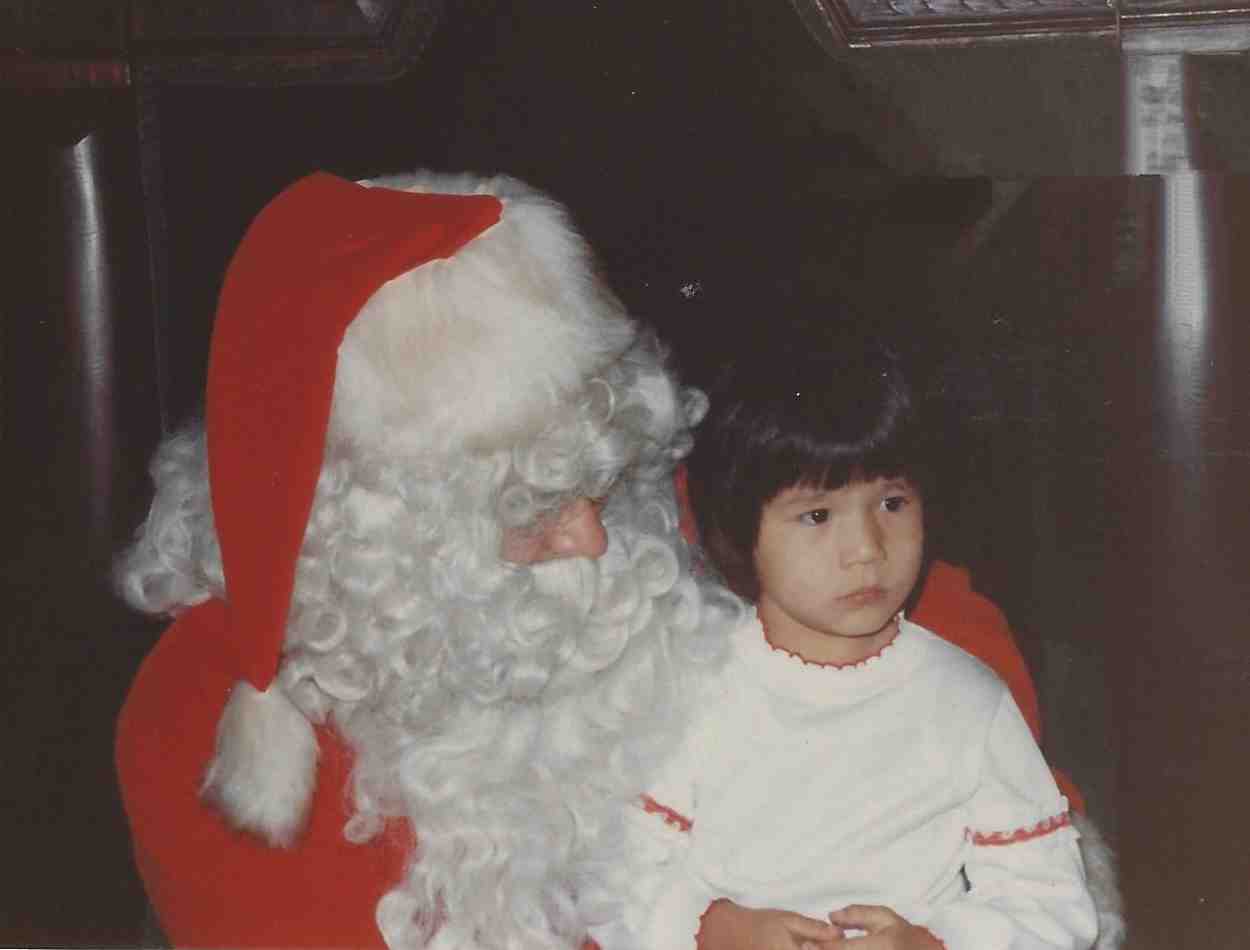
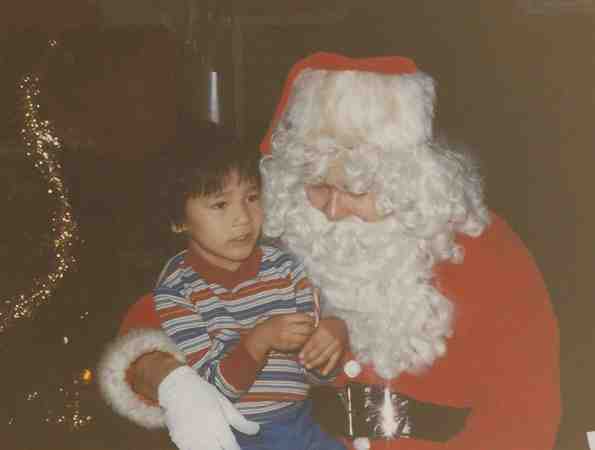
Silver Falls is one of the many beautiful areas in Oregon. We had visited it when Paul was little. So, we visited it again with Joe and Gwen and whoever was available in 1981. It was still pretty. Joe and Gwen always enjoyed those kinds of outings.
“CH7_V34_silverfalls.mp4” could not be found.
We bought Joe a small bicycle and Gwen a tricycle soon after we got them. They mastered those and moved on to bigger bicycles later but bicycles never were a passion for either one of them. Maybe because the pied piper was too old to lead them any longer.
“CH7_V15_GwenJoebikes.mp4” could not be found.
I am proud of what all of our children accomplished in sports. Birdie and I both loved sports and encouraged them as much as we could starting with buying a ball for Mark soon after he was born for his first toy. Not all really got into interschool sports but they all played in family games and were all very good. For example, we had some great football games at Ona Beach park.
“CH7_V27_onabeach_football.mp4” could not be found.
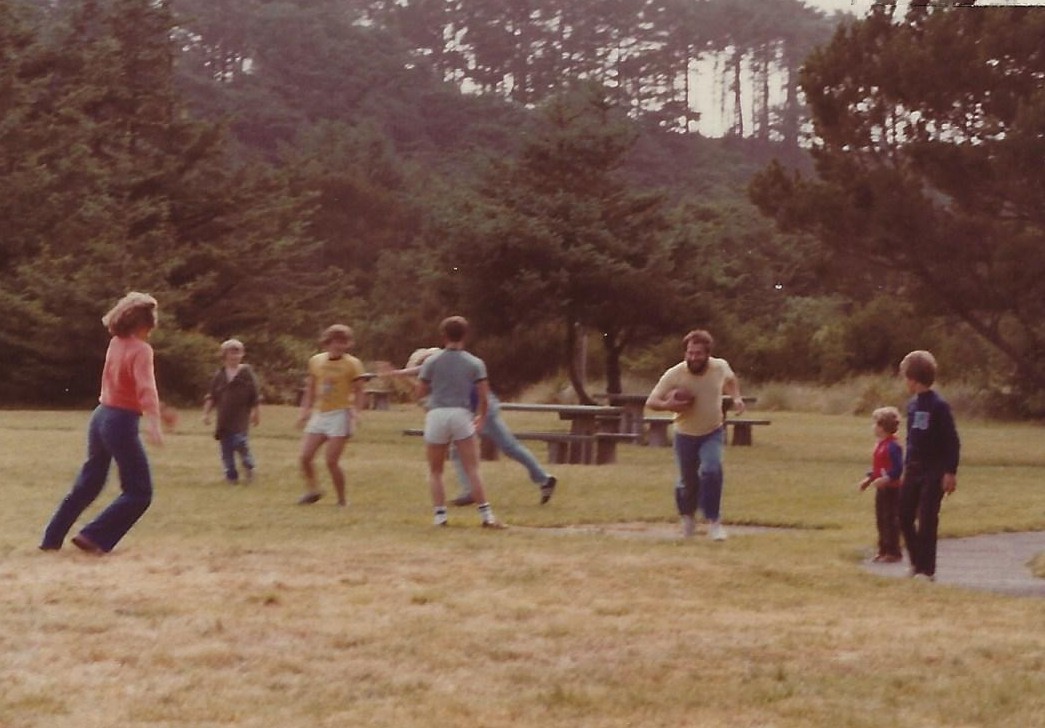
Sometimes we played with a nerf football and then Matt suggested we use a frisbee. That changed the game significantly and we had some interesting Frisbee football games.
I have talked about some of the older children's sports earlier. We talked about Paul's soccer escapades in Colorado (Chapter 6) but in Albany he was mostly into football and basketball.
“CH7_V29_Paulbsktball.mp4” could not be found.
He became an outstanding offensive guard in football.
“CH7_V30_Paulftball.mp4” could not be found.
(being named as 2nd team All-Conference as a junior and 1st team as a senior).
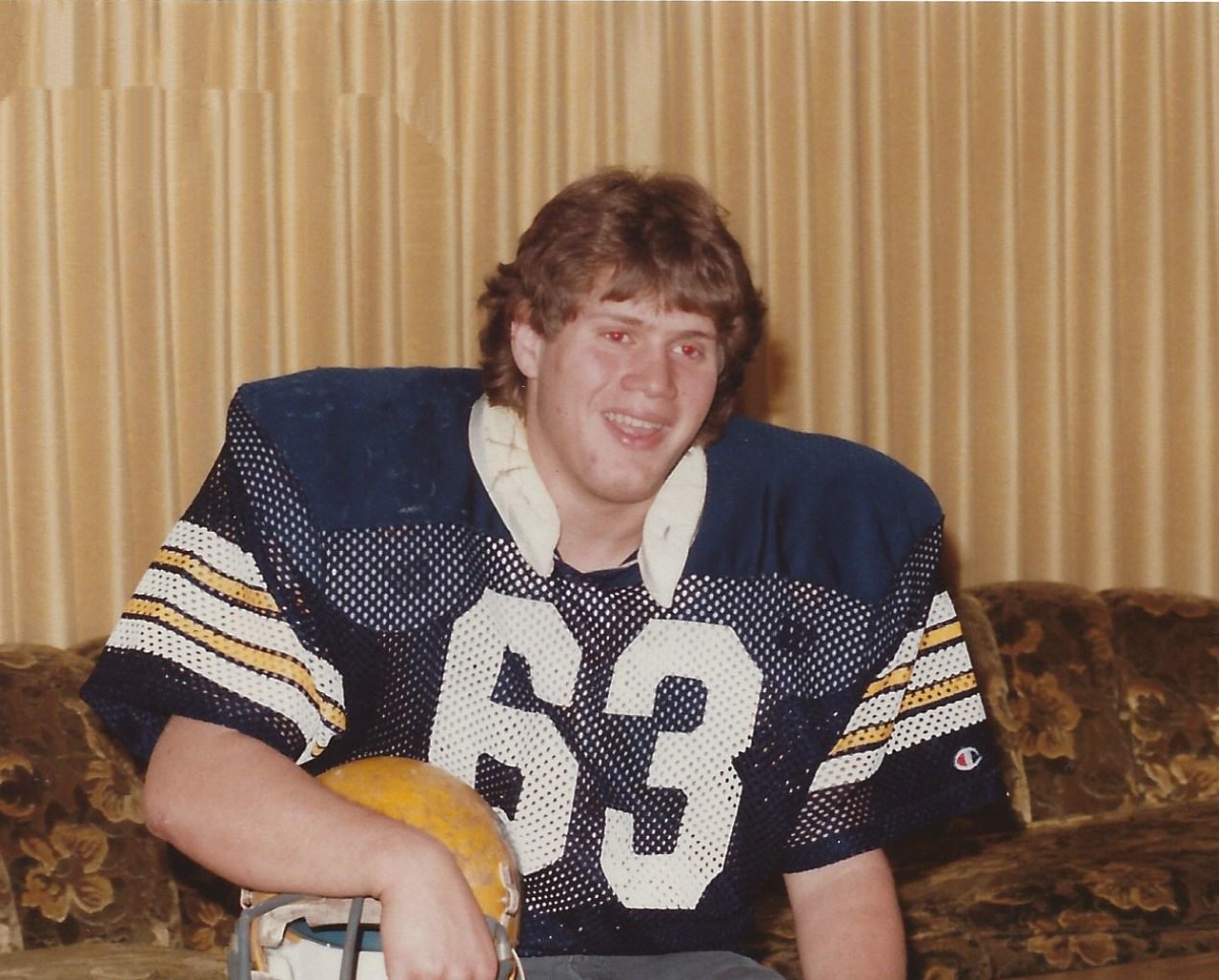
He also gave it a go at Western Oregon but wouldn't tolerate the politics. Paul and the rest of the family probably played their toughest and best basketball in our back yard. As far as playing goes, basketball was always my favorite sport, at least until I was too old and took up golf. Birdie and I watched a lot of pro basketball back in Maryland when the Celtics were supreme with Cousy, Sharman, Loscutoff , Heinsohn and Russell and Red Auerbach as coach. Jim Loscutoff was from Oregon and he was the enforcer for the Celtics. The addition of the 3-point shot has, in my opinion, ruined the game. Those Celtics were great at working for the best shot and now they just pass it around outside the 3-point line until someone is open enough or brazen enough to shoot it. You had to see the Cousy passes.
Dave also began his sports career. He was a happy boy. One of his football exploits that I enjoyed most was when he played face to face with the Woods boy who was about twice his size. Maybe it built character which allowed him to do well in high school but that is for the next chapter.
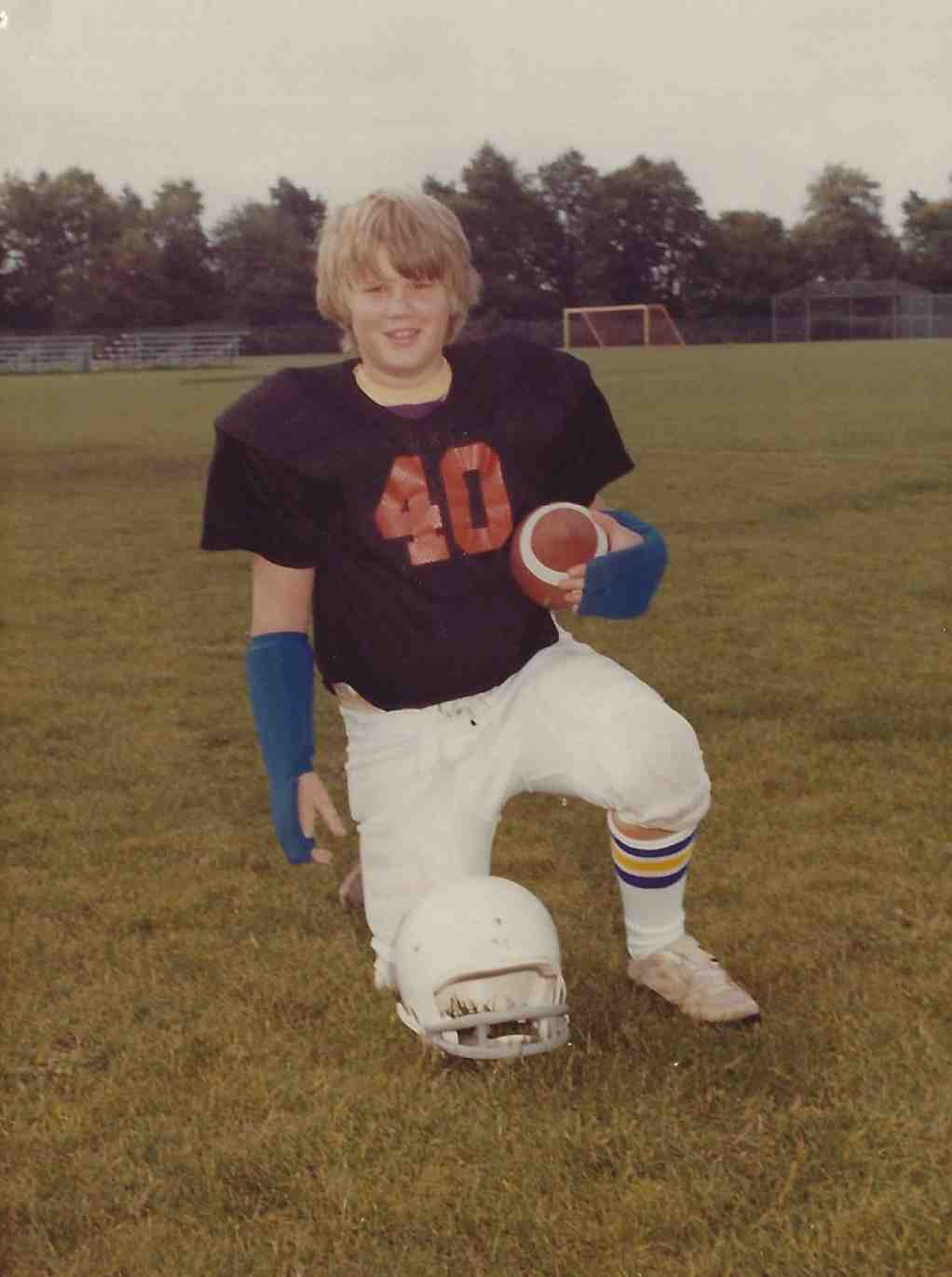
There was concern from Margaret and Ruby about Joe since he was so hyperactive. Ruby had worked things around him to keep him peaceful and told us several things not to do: don't let him see blood, don't have him in a store at closing time, or around sirens or loud noises (other than his own, I guess). They also had him on Ridlin. We had never tolerated drugs and we didn't tolerate Ridlin. The first time Joe was injured and bled, Birdie marveled at how pretty his blood was and he also got so intrigued by it he forgot to panic. None of the things we were warned about were ever a problem, but Joe was pretty hyperactive. Later he channeled it into working and did very well. Joe was always a good worker. Discipline was another thing. Neither of them was familiar with it and neither of them accepted it easily. I was fortunate in that I worked every day; Birdie got the blunt and some days she was emotionally exhausted by the end of the day. One time, I think Joe was still five, he ran away from home. I think he made it to Valley View but we brought him back. Joe had to adopt discipline pretty quickly because he was about to start kindergarten. He did and he was able to cope with school and although there were a few rough spots he graduated from high school with no exceptions. One rough spot occurred in middle school. Some boys were picking on Joe every day and it was getting him down. Birdie told him if they kept doing it to smack one of them. He did. Of course, as usual the teacher only saw the retaliation so she was going to impose punishment on Joe until Birdie intervened. She pointed out the problem that they don't ever see, someone gets picked on day after day. But as soon as he retaliates, they see that. It was/is one of our pet peeves.
. Our society will punish parents who use physical punishment to train their child. I can attest that physical punishment, except in rare cases of extreme abuse, does not cause lasting injury. Drinking alcohol during pregnancy effects the development of the brain of the unborn child and causes irreparable damage. Our society ignores this child abuse. Two symptoms of fetal alcohol effects are: lack of ability to assess consequences of actions and lack of curiosity. We saw both of these. One example: We took a trip to Tillamook. I pointed out the huge hangers just outside Tillamook that at that time had old airplanes on display and told them a little about the blimps that were used to guard the coast for submarines during WWII, but they had no curiosity about the hangers, the history or any part of it. The problem was that this lack of curiosity was pervasive and limited their ability to even play. We don't realize the importance of curiosity in our lives until we find someone who doesn't have much.
Birdie and I continued to just get older. Here we are at 44!
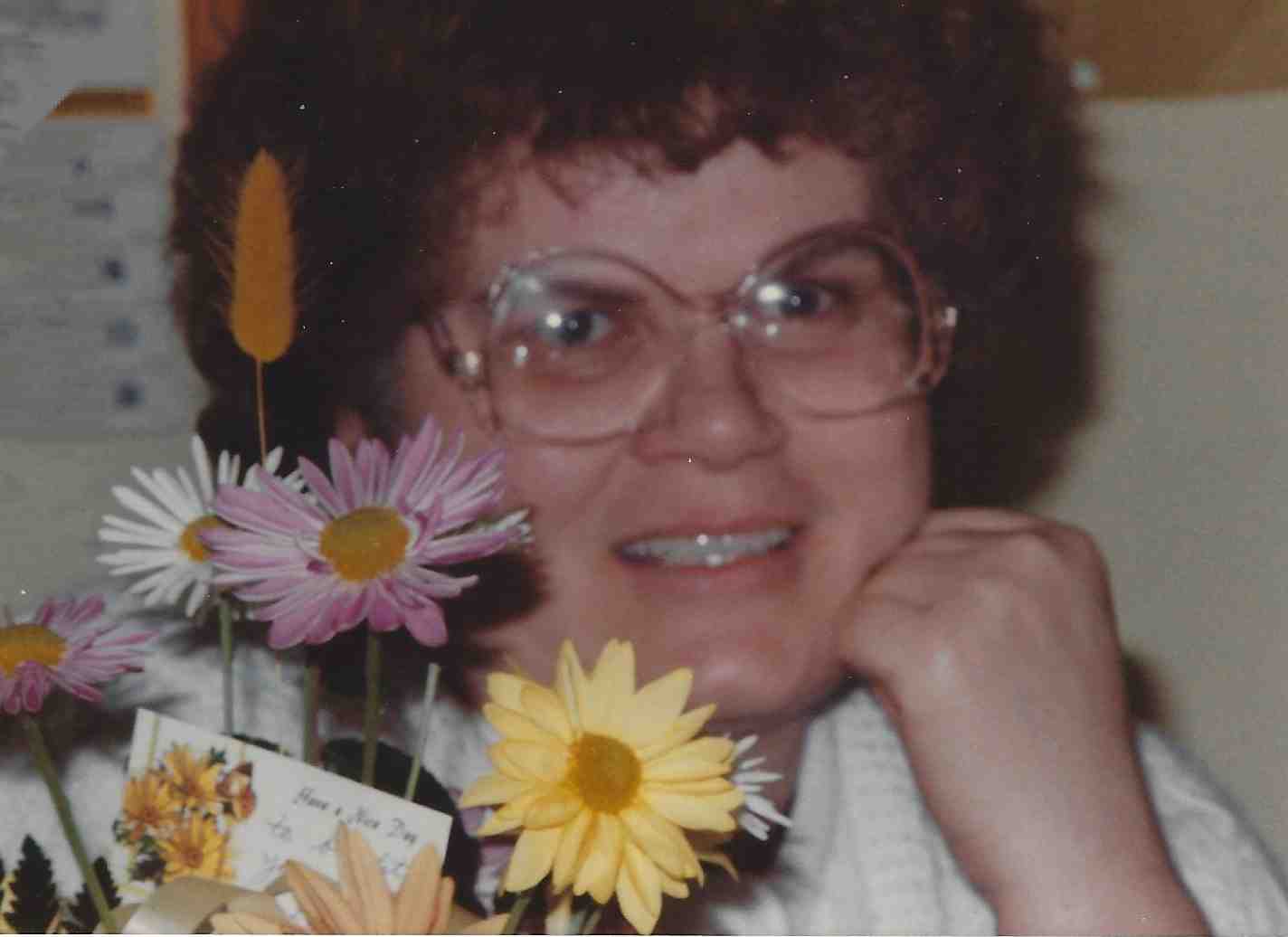
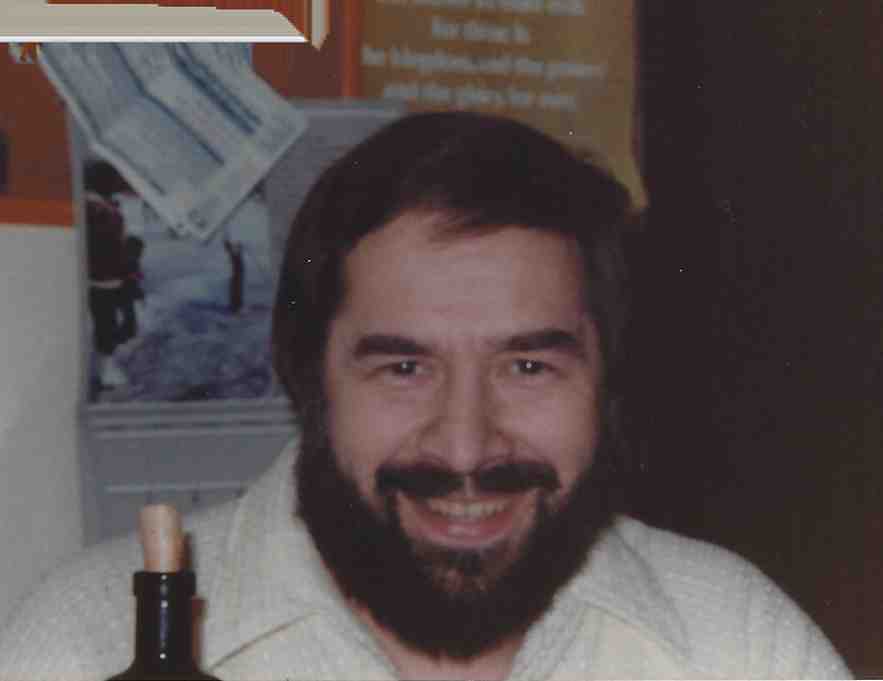
Teresa agreed to take Luke to Australia to live with Chris. As always, I have lots of ideas on why it didn't work out but I won't speculate and will leave those answers to Teresa's story. But it didn't work and Chris had tight reins on the money so Teresa was stuck. We purchased tickets for Teresa and Luke on Quantas Air lines that she could pick up at the airport and Teresa worked out their escape and she was back home. Later Chris came and tried to live here but that also did not work. So, Chris went back to Australia and that seems to be the end. He did pay off Teresa's debts, including to us, so she started over. She eventually went to OSU, worked to support herself and Luke, and earned her degree with honors.
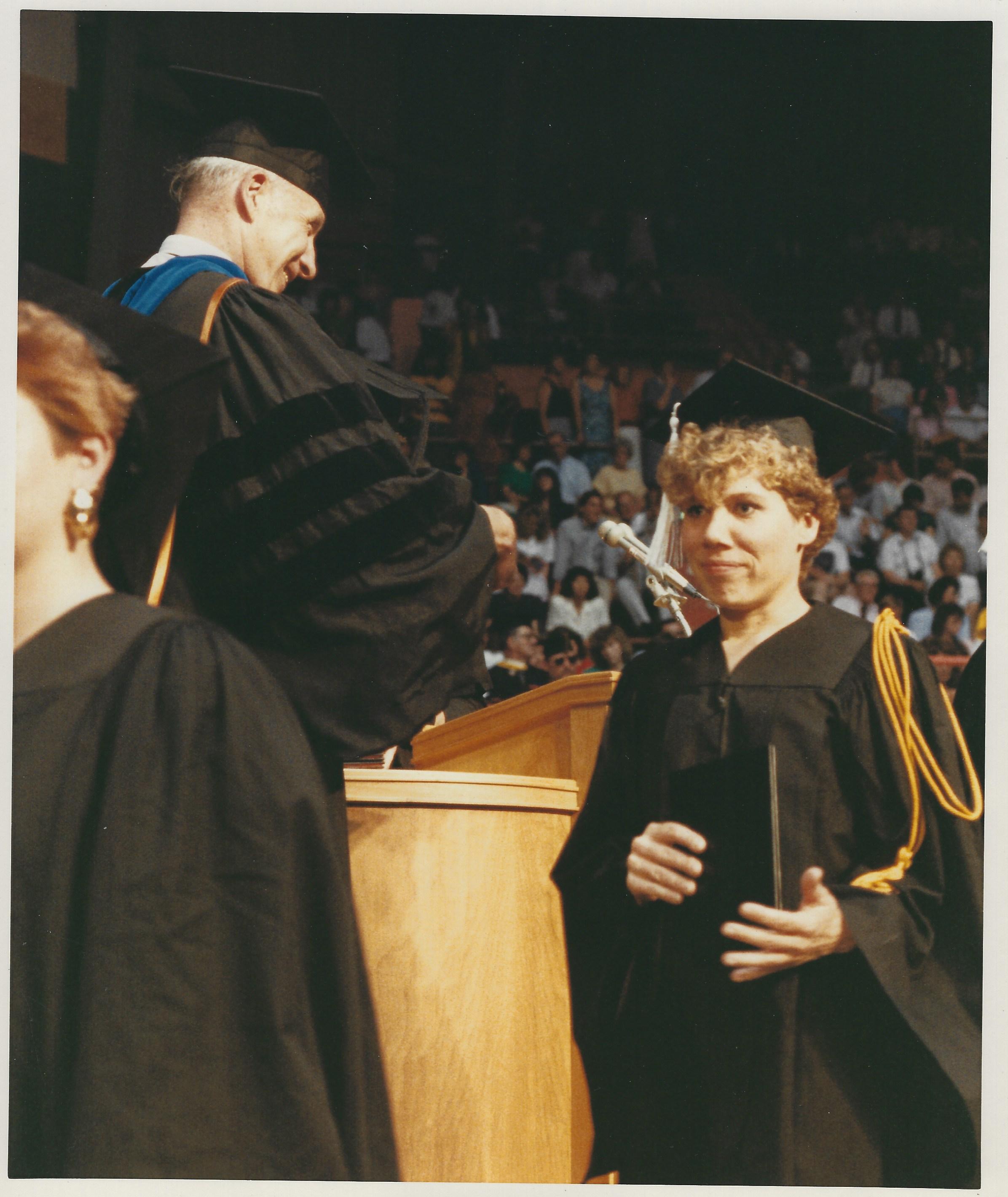
We were concerned about her living situation so we cashed in our tax cap (tax exempt retirement savings) and purchased a mobile home and put it on a lot in Corvallis. The boys and I helped get it ready and approved and Teresa and Luke lived there until after she graduated. We gave it to her as a graduation present. She was off and running on her next adventure in life, Greece. She is a vagabond!
Mike graduated in 1982.
“CH7_V24_Mikegrad.mp4” could not be found.
He was a bit of a shaggy graduate but still dashing.
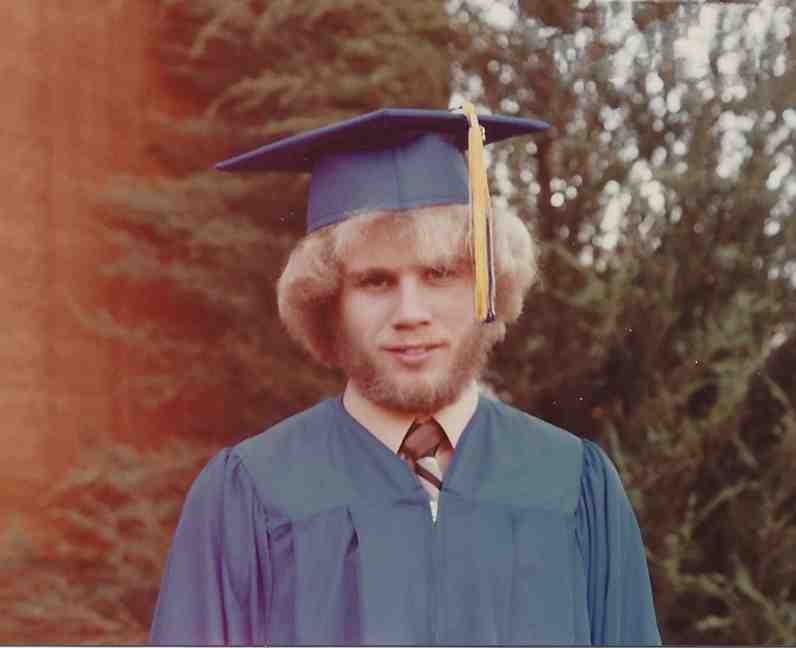
He and Cindy were married in the old St Mary's church in Albany. Cindy was a sprinter in track and also of Czechoslovakian descent so I called her the 'fast check'. Who knows what that means? Mike also joined the Air Force and ended up maintaining missiles in silos in Arkansas.
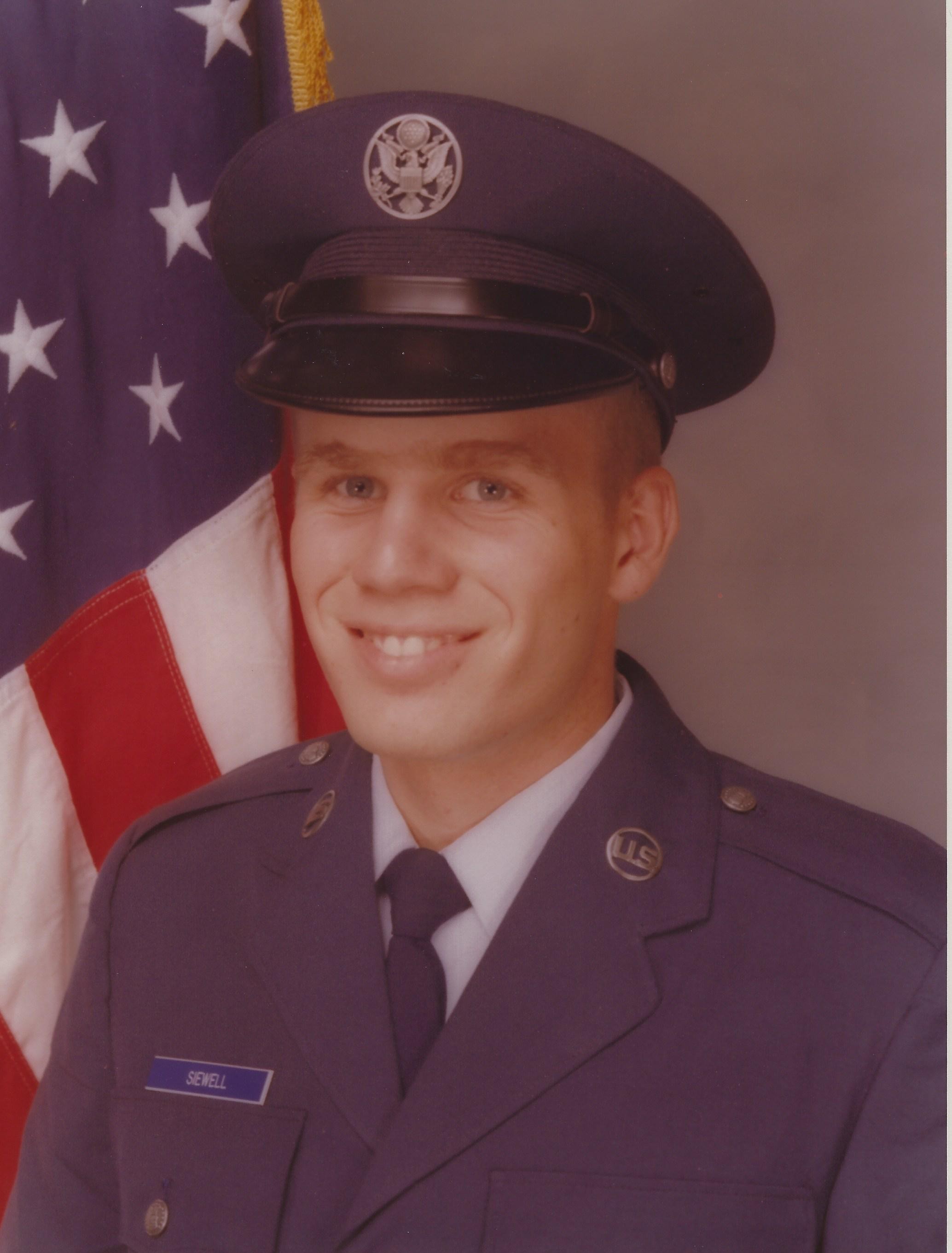
We visited them there once and I recall a couple of things. First, there was an incessant noise from some noisy bugs they have in that area. Second, we went to dinner in a buffet style restaurant and we were astounded by a huge mound of frog legs some guy was carrying to his table. I don't recall becoming a fan of catfish or frog legs. The South is different! Mike took us on a sojourn across the Mississippi to Memphis and down to Vicksburg and back. We toured the battle site around Vicksburg and then went through the town on our way back. This part of the sojourn has come under immense criticism in each of the years since. It turns out that Birdie had read quite a lot about the Civil War and had read about the people of Vicksburg having parties and dancing right up until Grant captured the city. Well as we were passing thru Vicksburg and we saw an advertisement in front of an old building saying they were re-enacting the party and dance that was going on just before Vicksburg fell. Over Birdie's protests we decided we didn't have time to make the stop so we continued – an enduring mistake!
Mike had laid out a plan to go in the Air Force, save his money, and get out and go to college. He executed the plan perfectly. He and Cindy moved into the mobile park that Teresa was in and he got his teaching degree at Oregon State. He then moved to his first job at Baker City high school. The marriage ended in divorce but I believe it ended up best for both in the end. Only they know for sure.
We had to keep Joe and Gwen some period of time (I think 2 years) before the adoption could be finalized. To save money I typed (with a real typewriter no less) up all the documents required and we appeared before Judge Knight in the Corvallis Court House
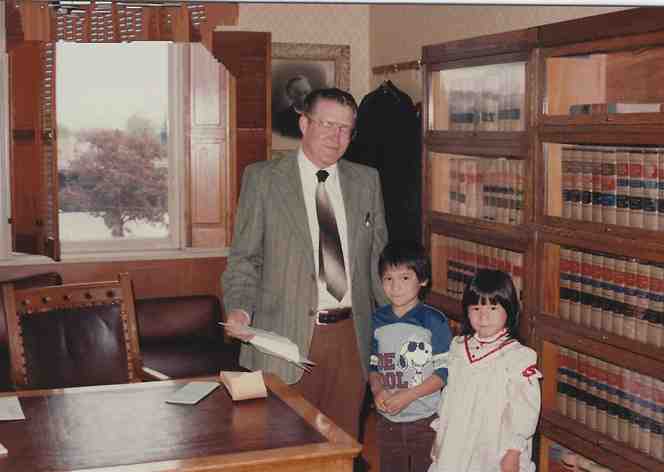
to finalize the adoption. As I reflect on the adoptions, I realize that we had no idea what we were taking on when we took it on. God in his infinite wisdom knows that many good deeds would go undone if we knew in advance what it was going to take. But both Joe and Gwen became great kids; Joe was always the hard worker
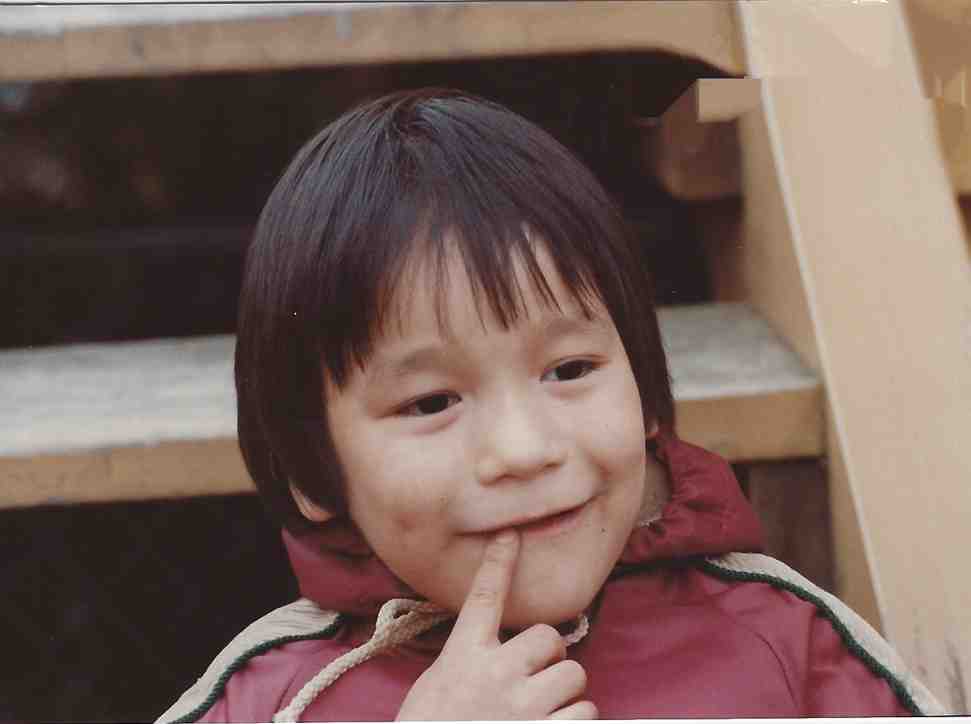
and Gwen had a smiling, positive outlook.
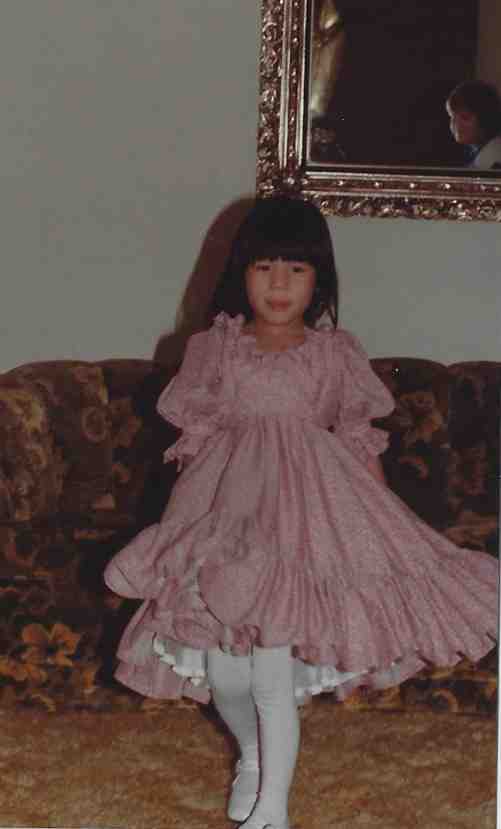
Now we just look at the great progress that Joe and Gwen have made in becoming good and independent adults to realize we did the right thing. Even if they don't always agree!
Paul had a couple of exploits that I should mention. One was with friend Pat Bender: the radio station said they would give away an ATV to someone who could solve their puzzle. They provided clues hidden at various locations throughout Linn county and gave out hints over the radio to where these could be found. So, Pat and Paul focused on solving every riddle and finally won the prize.
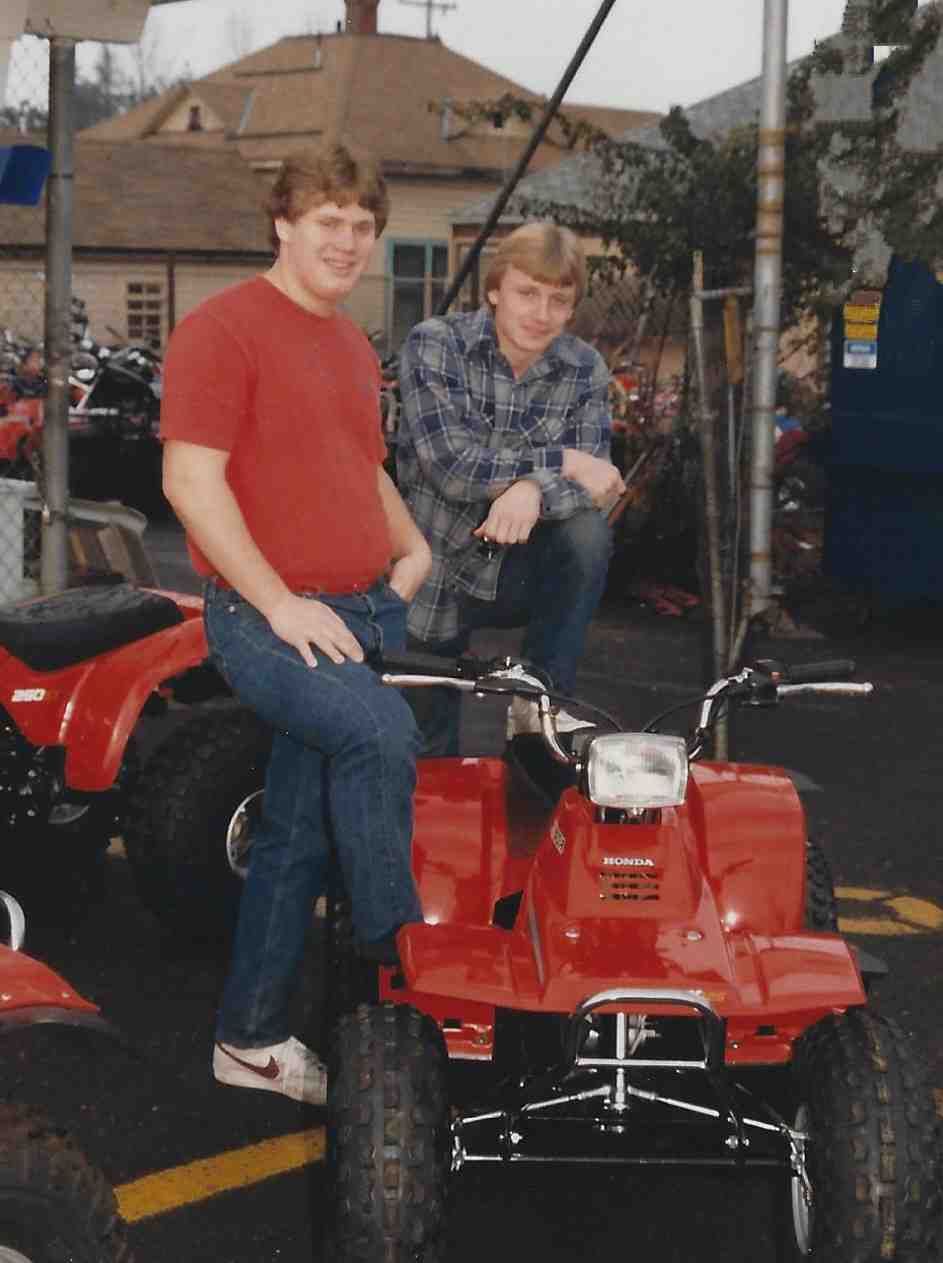
The radio station also put on a slackwater drift every year which involved every imaginable floating device travelling on the river between Corvallis and Albany. Paul and Pat tried their hand at this. One year it was an original, homemade device that probably beached somewhere along the way and was left for dead. Paul and Eric made a more sensible run with one of our rafts
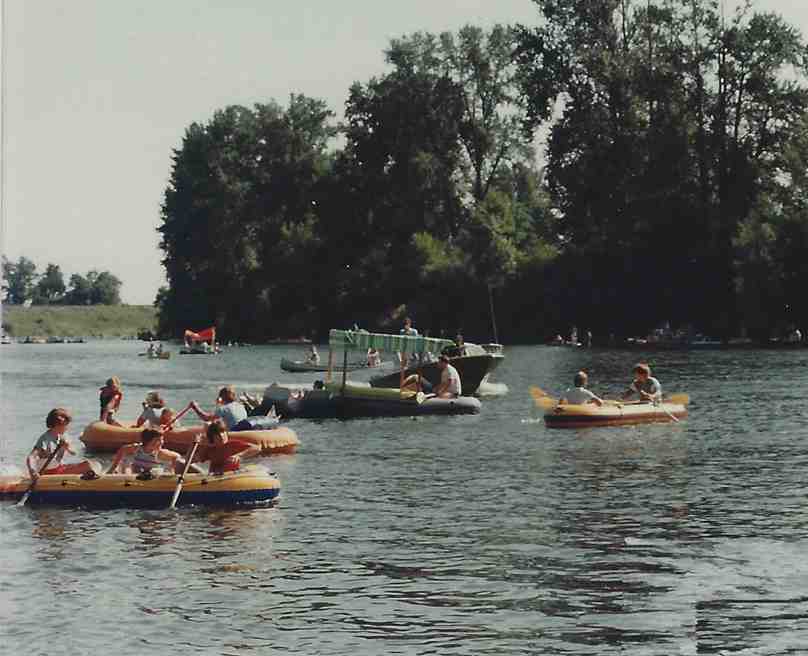
It looks in the picture as if some girls in a similar raft were interested but I guess the boys had their hands full just staying afloat, or keeping the beer hidden.
This is probably a good time to mention my good friend Pat Shelley.
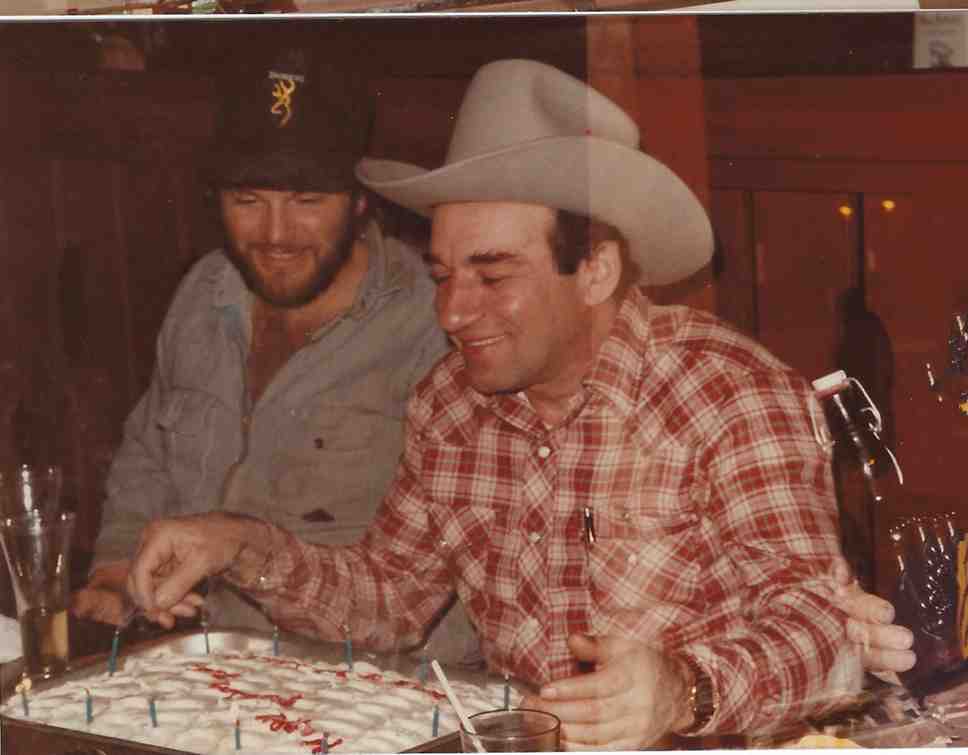
Pat is the one who got us into motorcycles. I worked with Pat. Pat was a great sketch artist. At work he was utilized a lot to put on paper an idea that some engineer, including me, had envisioned. He not only put the idea on paper but he would flesh it out into something that looked practical and might even work. He was a great friend and had some memorable birthday parties at his house.
When we picked up Joe and Gwen in Winnipeg, Margaret told us about a younger sister who was about a year and a half at that time and had too many health problems for them to consider putting her up for adoption. We told Margaret of our interest in keeping her with Joe and Gwen. Two years later, Margaret called and told us that Amanda was healthy enough for adoption; so, we started the process. At this time some of the Native Americans in Manitoba were objecting to having their children adopted into the USA. They weren't willing to adopt or take care of them, but they didn't want others to. So, in spite of the fact that there were several hundred in the care of the Children's aid society in Winnipeg and they could not get Native American families to adopt them, the liberals passed a law to stop adoptions into the USA. Like most liberal programs it sounded noble but it didn't help the kids; it just made the liberals feel better. So, we were told that Amanda could not be adopted by us. Not one to fade at the first obstacle, I wrote a letter to the premier of Manitoba with a picture of Joe and Gwen pointing out they were happy and doing well and they were being deprived of growing up with their sister, Amanda. It apparently hit him in the right place because he placed a call to someone in the chain above Margaret and told them to do the adoption. The only obstacle then was that Amanda's mother was given one last opportunity to come in to the court and express her desire to take care of Amanda. She had a time scheduled but she never showed.
Mark and Lori had settled in Cheyenne Wyoming for his stint in the Air Force and we (Mom, Dad, David, Joe and Gwen) made a visit in 1983. We travelled through Idaho and since we had interest in the Nez Perce wars, we travelled through Lewiston and down to Kamiah and on to the Lolo pass, visiting some of the battle sites as we went. Gwen and Joe were too small to get much out of it. We stopped on top of Lolo pass at a lodge and we had hot chocolate and talked to an older Indian woman. She told us a little about Fort Fizzle, which was where some settlers planned to stop the Nez Perce march to Canada but the Nez Perce went by them on some cliffs way above them and so their plan fizzled. We stopped and saw Fort Fizzle and imagined the Indians passing on the cliffs above. This was just outside Missoula and we stayed overnight at Missoula. While in Missoula we received a call from the social worker in Winnipeg that we were approved to adopt Amanda but we needed to move quickly. The Premier had intervened and the word was given to the social workers to let us adopt Amanda. So, we were pleased.
We met Mark and Lori at Yellowstone and saw a few of the sights including Old Faithful of course'
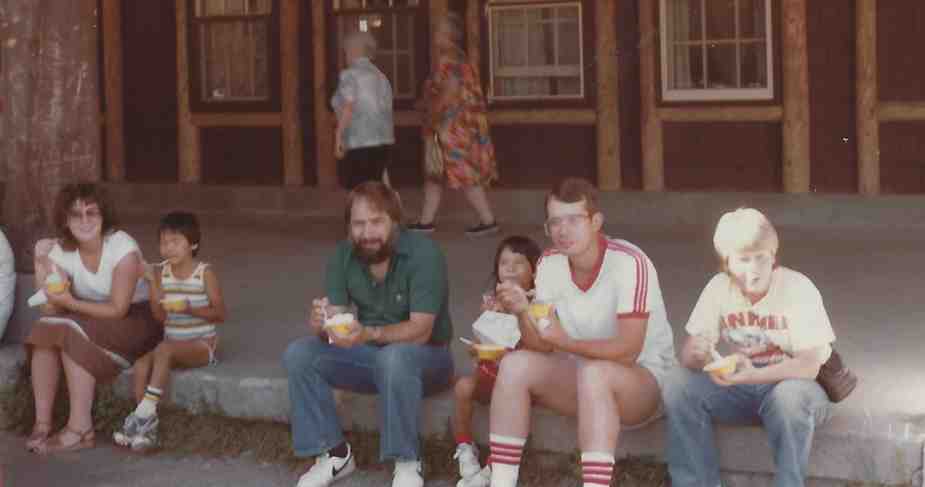
We spent the night in some cabins I had reserved somewhere near the Wyoming/Montana border and they turned out to be a bit more rustic than I had envisioned but we survived. We spent several days at Mark and Lori's in Cheyenne. A couple of noteworthy events happened. Mark and Lori had a microwave which was rather new to us at that time. Mark wanted to hard boil an egg in it and he placed a napkin over the egg and turned it on. There was a rather sudden explosion! Tiny bits and pieces of the egg and napkin were scattered throughout their trailer. I doubt they were ever all found. It was a good lesson. We also went to Cheyenne Frontier days and enjoyed that. We bought a hat for Dave but Birdie and I tried it for effect.
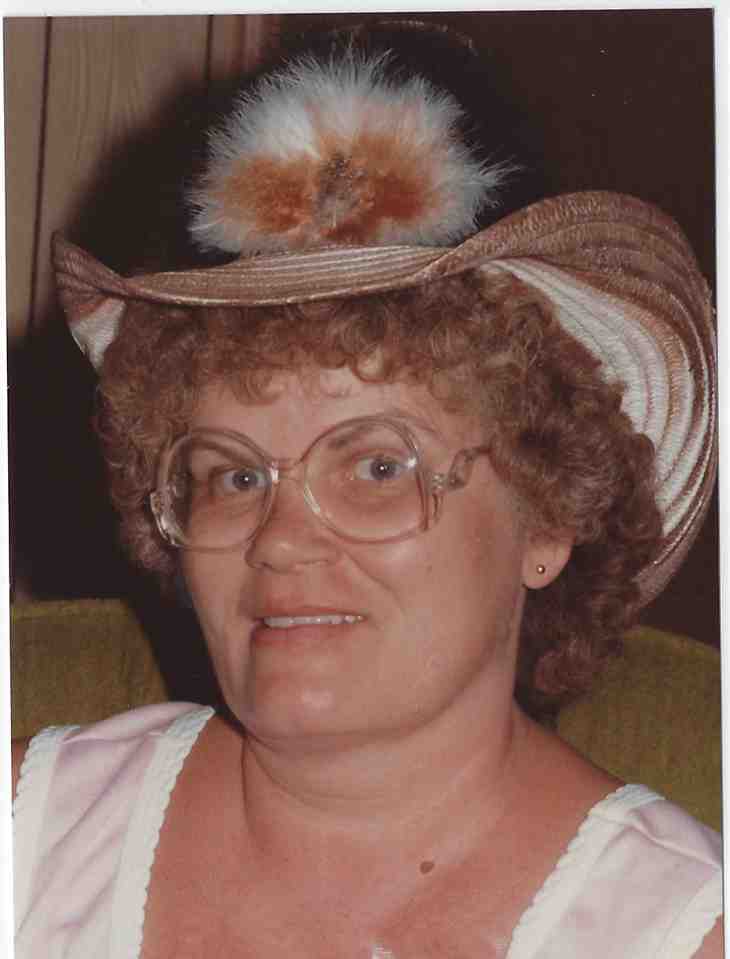
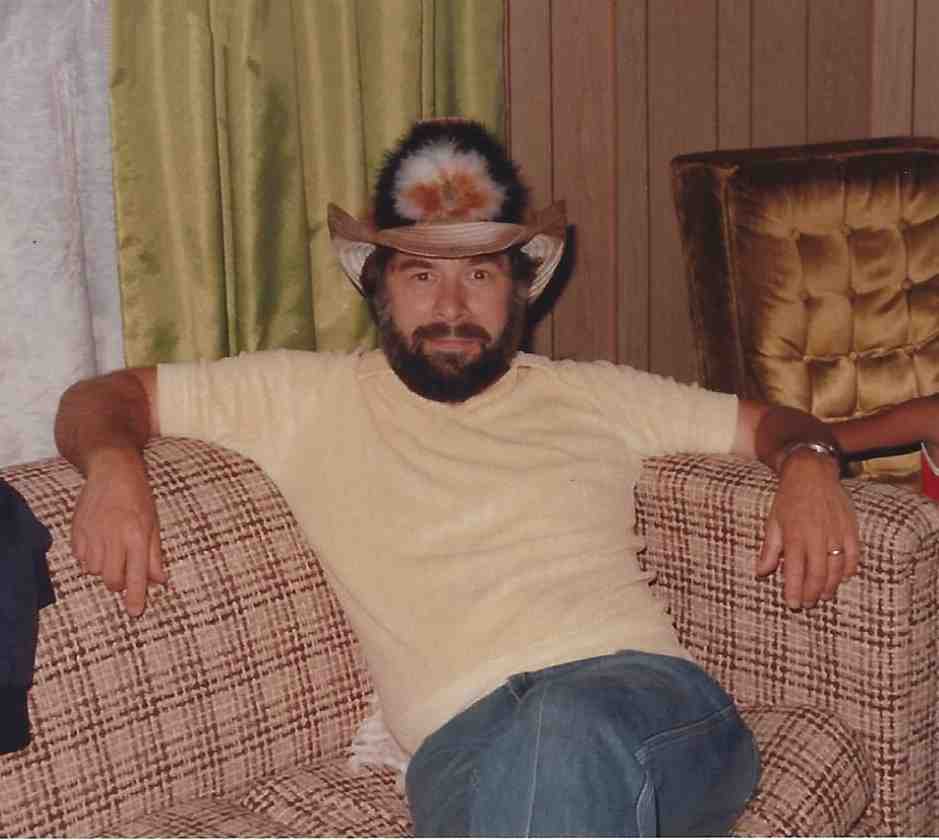
We watched some of the Kiowa Indians dancing and a couple of them talked with Joe and Gwen.
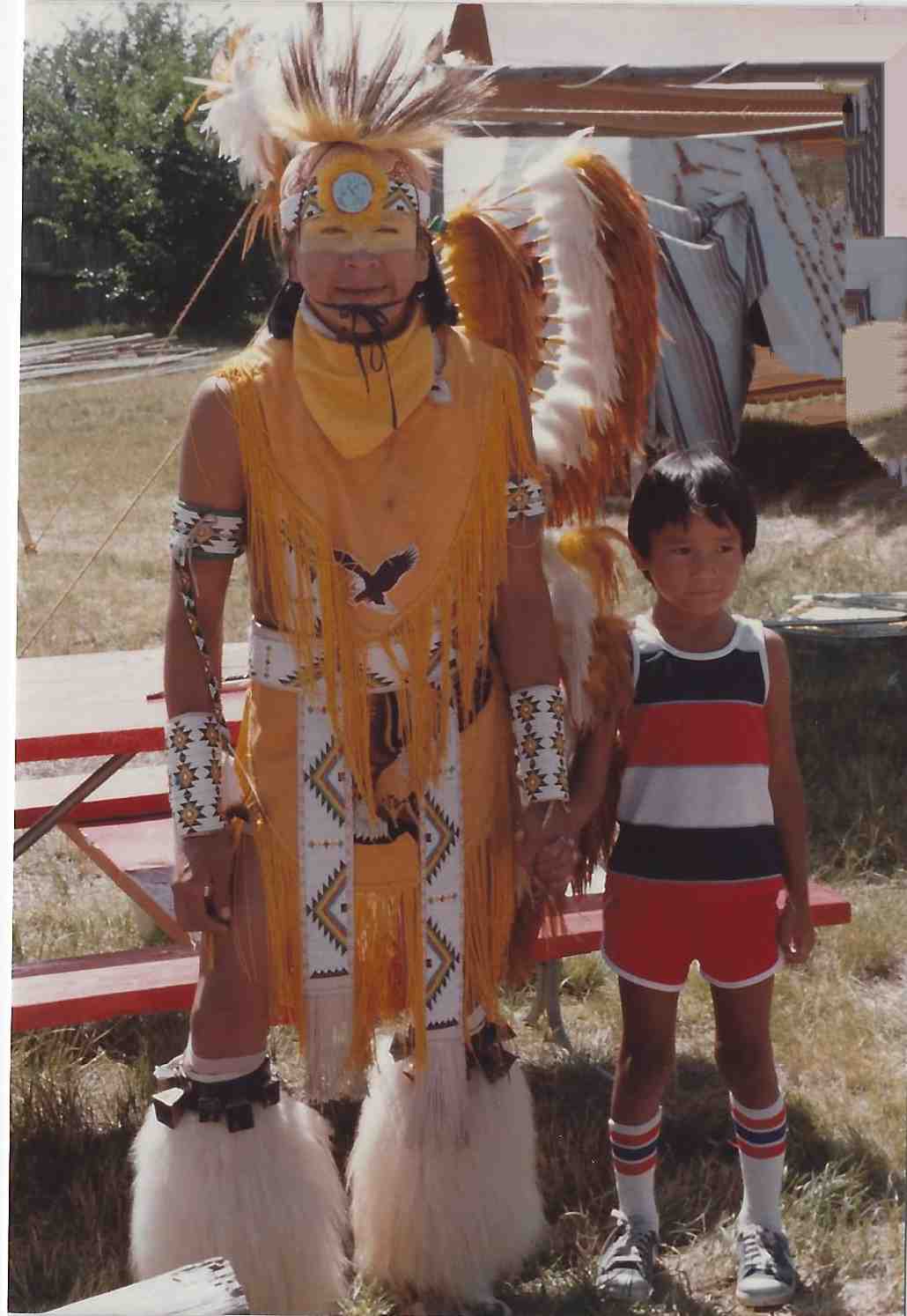
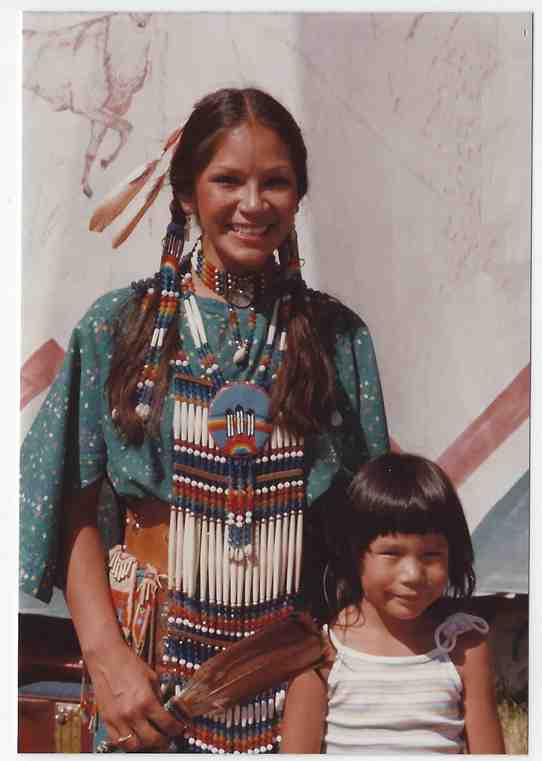
The Charley Pride concert which was exceptional. I always liked Charley Pride but he was even much better in person than on record. Same can't be said about Waylon who has little personality on stage. On our way home we were travelling through the southern part of Idaho and we came to a flat area where the road seemed to go for miles without a turn. Along the straightaway was a tractor cutting the grass along the edge of the highway and the only thing the operator had to do for hours on end was every mile lift the blade to pass over a mileage post. We forever after used that as our example of the world's most boring job. We stayed overnight in a motel near the Idaho/Oregon border and I took Joe and Gwen swimming in the pool.
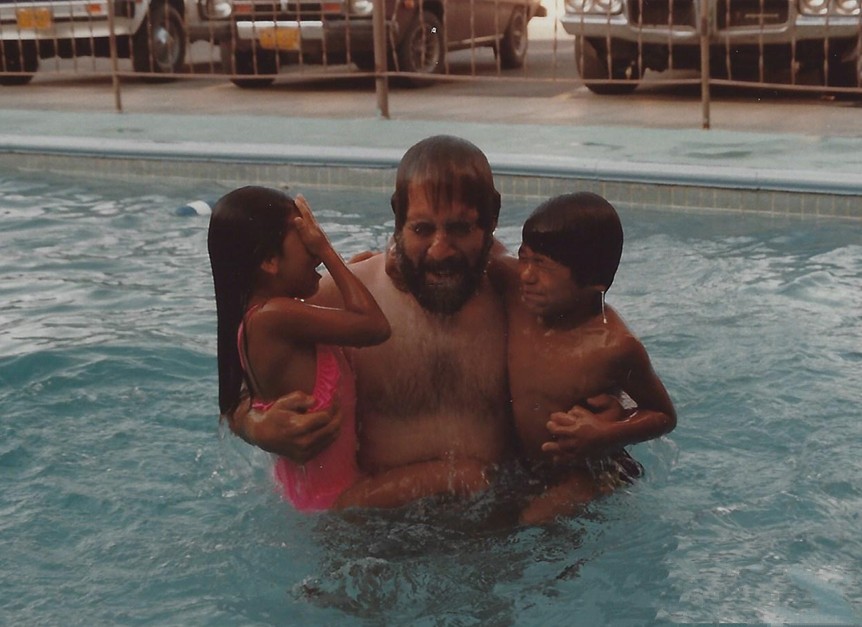
Birdie celebrated her 45th and this is Gary and Birdie in December of that year.
“CH7_V4_B45BD.mp4” could not be found.
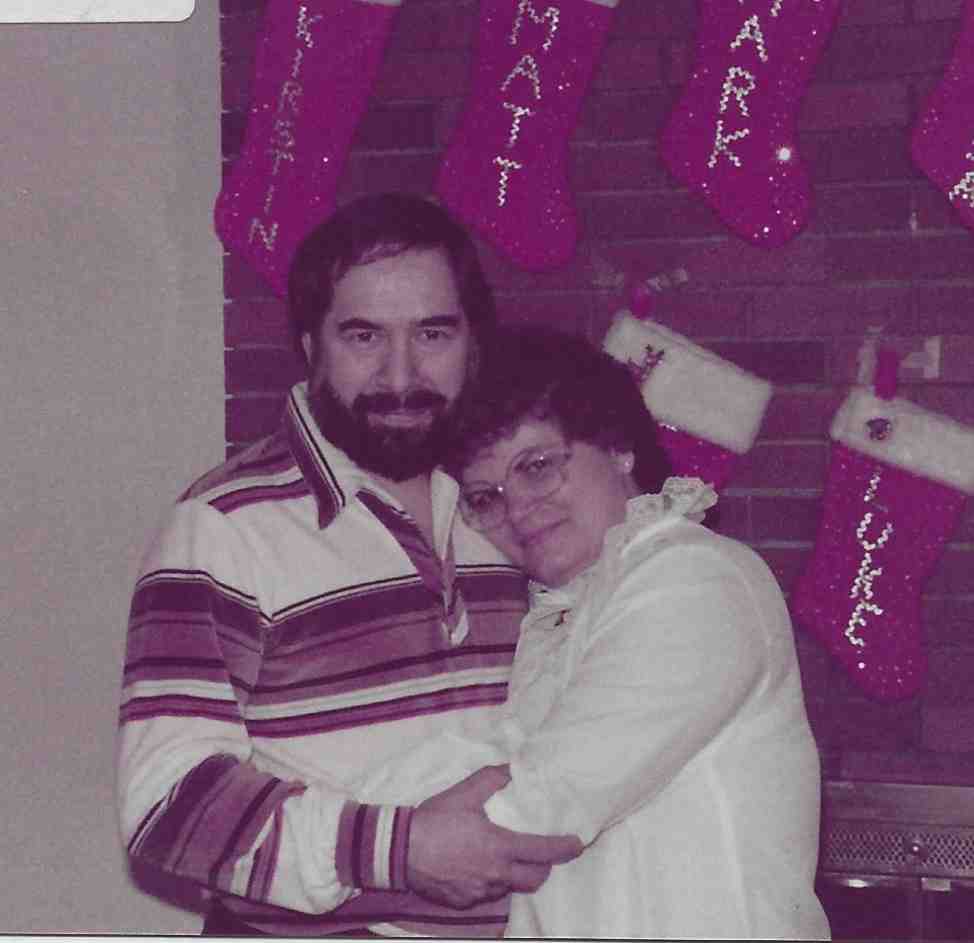
We looked young! We occasionally danced in the front room and we had more Waylon to dance to including three of my favorites. Old Friends in our minds is about us.
Soon after we returned from Wyoming, we planned a trip to Winnipeg. We didn't have the visit-to-our-house phase with Amanda like we had with Joe and Gwen. We flew up and Margaret took us to visit Amanda at her foster home. The foster mother was an older woman who had raised some boys and who now had an autistic boy and Amanda. She was short on discipline and had allowed Amanda to just eat what she wanted and that was mostly porridge. Margaret also took us and Amanda on some outings to get us acquainted. We saw Fort Garry and learned a little of the history of the Red River area.
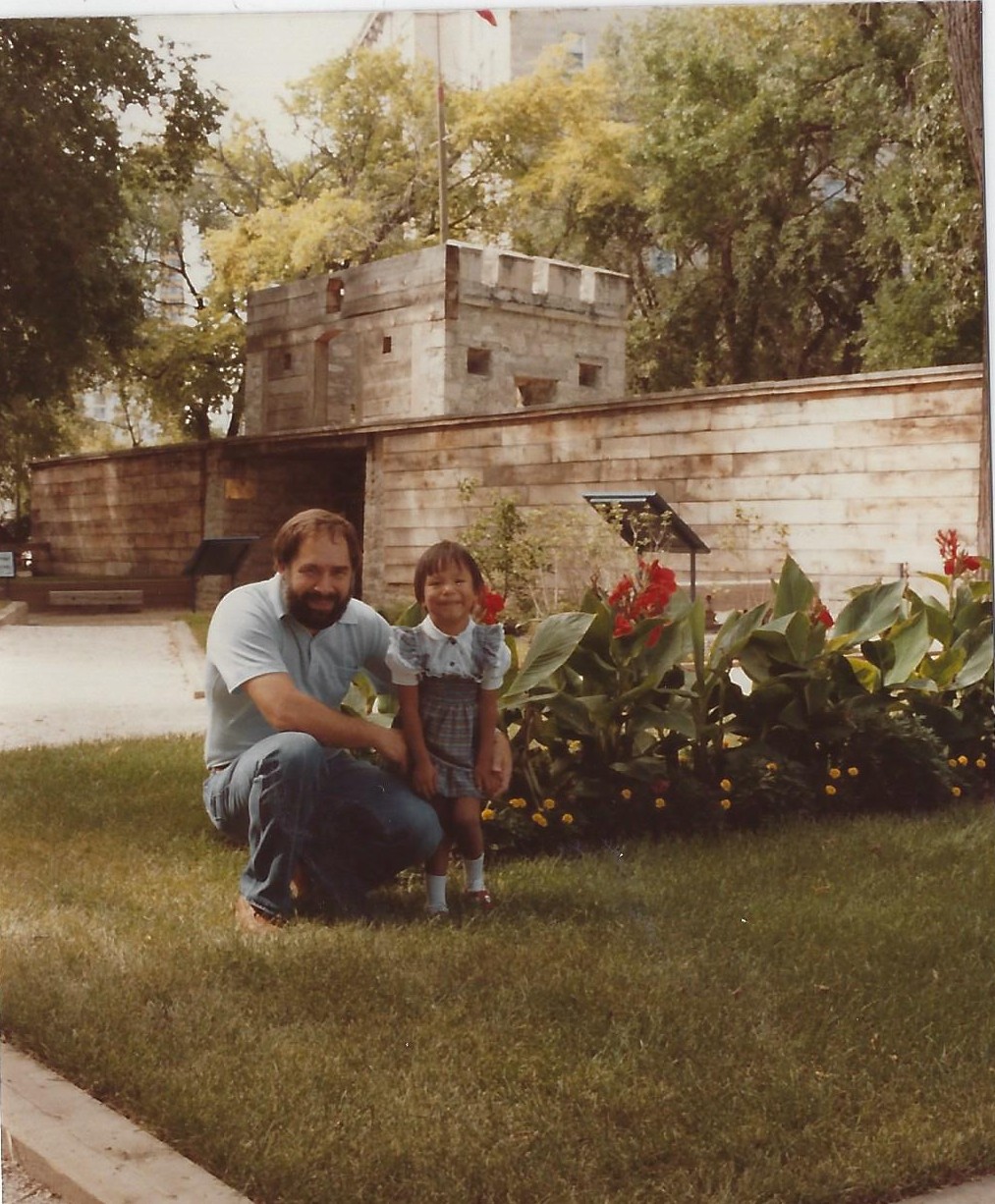
Margaret told us a little about how the Premier had intervened and word came down to her to make this adoption happen. So, she did. The trip back was not as eventful as when we had Joe but that was a good thing. Amanda joined her biological siblings.
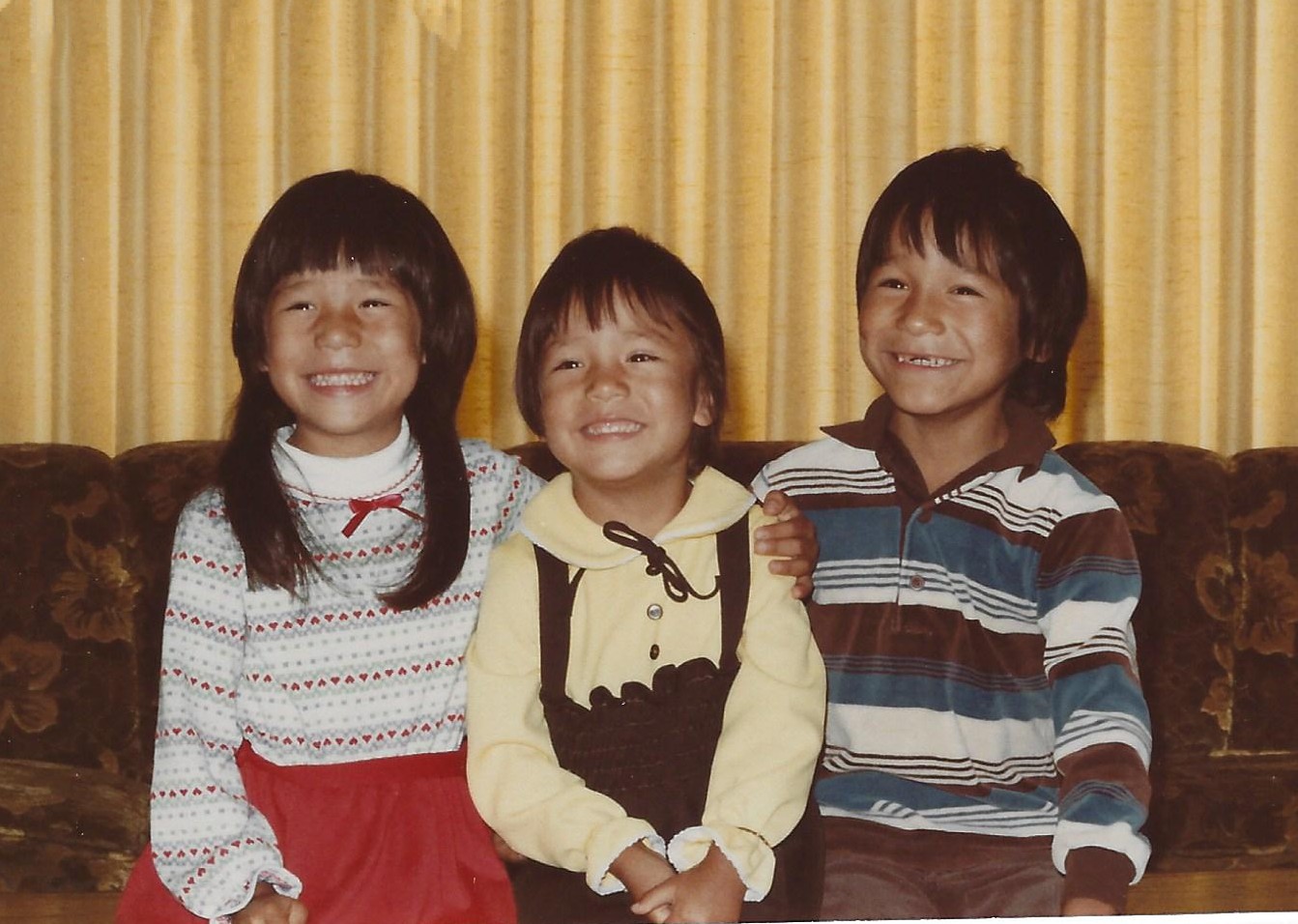
Soon after she was baptized by Father Walsh.
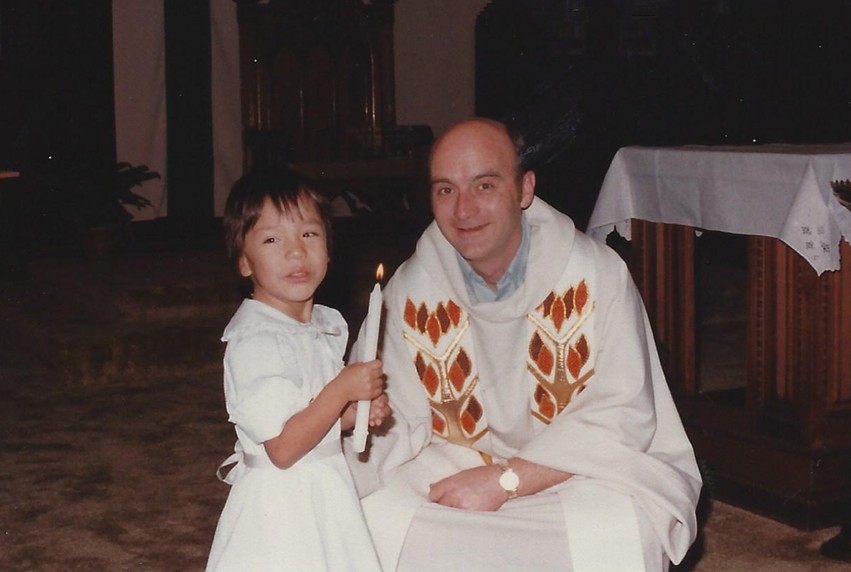
Kirstin later met Dennis who also worked at HP. They became engaged and everything seemed to be going fine until Kirstin became pregnant. This was a difficult and confusing (and thus sometimes contentious) time for Kirstin and Dennis. She decided to call off their engagement at that time. They eventually, with the help and encouragement of her sister Teresa, reconciled and married (Chapter 8).
In 1984 we sojourned to Los Angeles to attend the wedding of Matt and Joni.
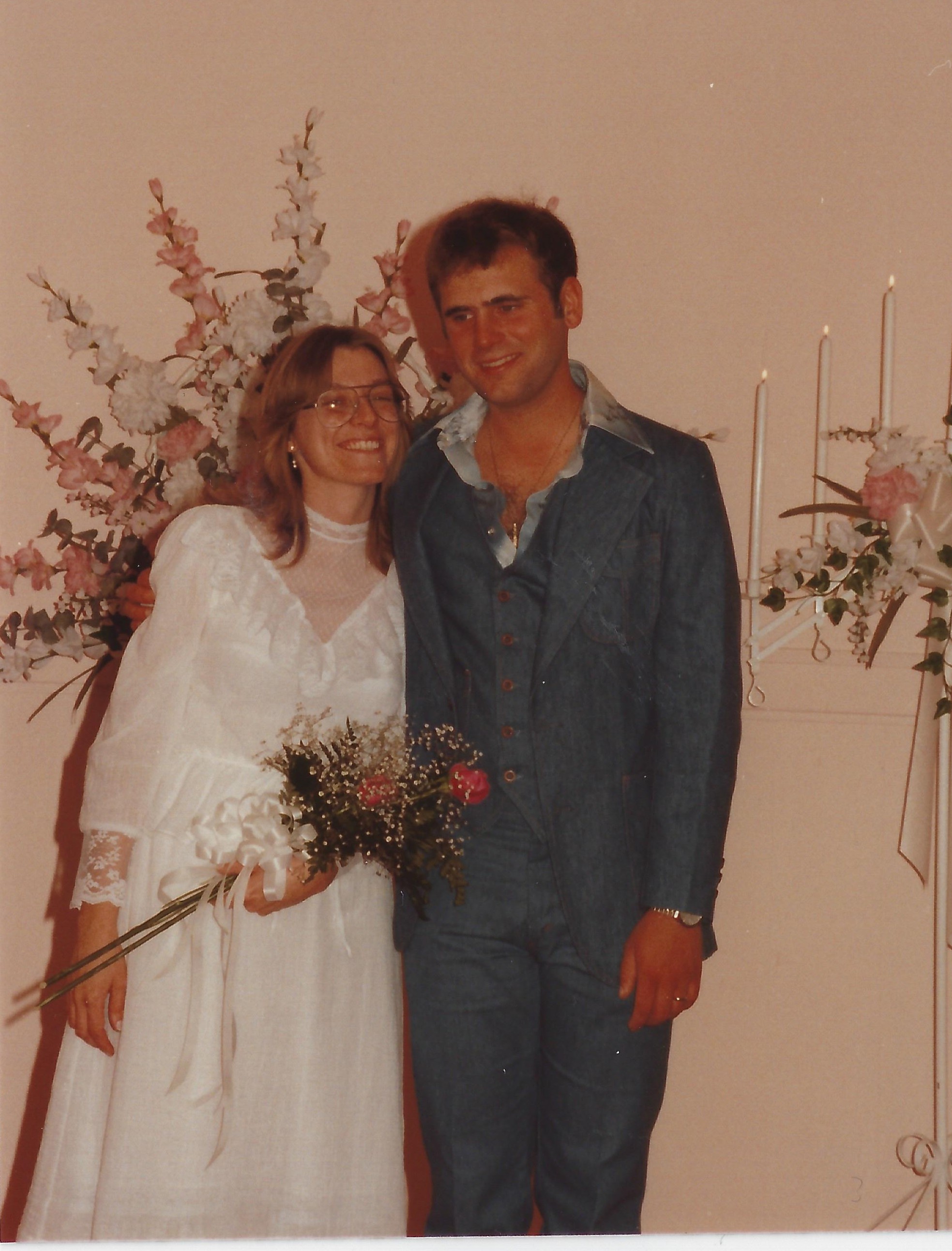
They were living in Oxnard. They took us into Los Angeles to see a few sites. Couple of things of interest: first, Matt was driving and he didn't wear glasses and couldn't read the road signs, so Joni had to read them for him. This poor eye sight and traffic in Los Angeles were not comforting for us, but as you can see, we survived. We visited the museum with the display of long-gone animals that roamed the area and fell in the tar pits. We also stopped in Hollywood and saw the names of the stars in the sidewalk. Of more interest was a hooker who was walking down the street chained to her pimp. Some shadowy people started following Matt and his Mom panicked and yelled out to him and the shadowy figures turned around. She can be scary. The wedding was interesting as it was in a wedding chapel. We met Joni's parents and they were nice. Her Mom loved to talk and sometimes didn't require an audience. Her father was obviously a hard worker. The reception was a small party at Matt's with some of his friends and Joni's sister Susy and we parents.
During Auntie Ruth's time in Grants Pass, we got to know her and learned to love her. We made occasional trips down to take her to Erik's, her favorite buffet breakfast. Sometimes we also ran into Joe and Rosemary and got to know them better. Joe and I got along great. Birdie and Auntie Ruth discovered they had more in common than they could have imagined, including glaring at the photographer who would dare take their picture.
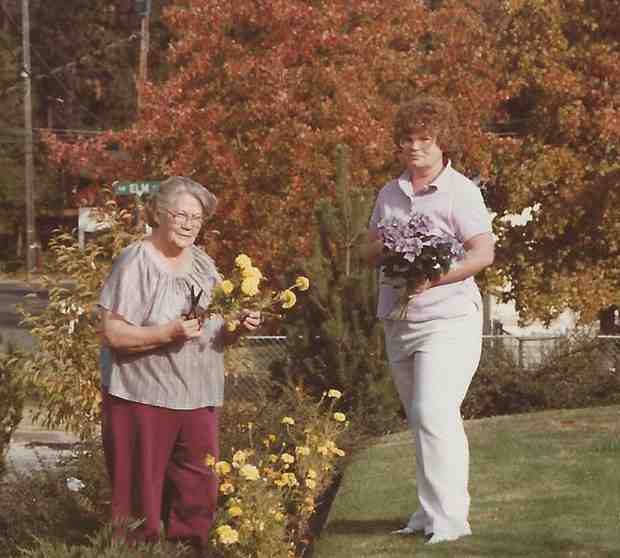
Catching up on my career. During the year I stayed in Printhead Engineering to help Greg get started, Tom Haswell moved into a desk next to me. Tom came from the Fort Collins Division in Colorado where he had been very successful at developing a special integrated circuit for use in an HP desktop calculator. He had moved up and then fell out of favor with his bosses and was shipped off to Corvallis, ostensibly with a promise of landing a suitable management job. It is possible he was friends with Ed Shideler since Shideler also came from Colorado. Anyway he and I hit it off and he spent as much of my time as he could picking my brain for my opinion on different managers in Corvallis. I was easy pickings. Tom will return later.
After my year and true to his word, Greg insured I could move into the Inkjet team working for Frank. Frank divided his team into two parts: one headed by Marzio Leban that developed the resistor and wearlayer on silicon and a second under me that developed the orifice plate, assembly, ink and testing. Frank wanted to be free to promote the Inkjet project (and himself), both of which he was very good at. The engineers I inherited had been a close knit team with Frank and they were close friends and that provided some obstacles but we worked through them. For example, Niels Nielsen was doing the testing. He was very good at it. He kept meticulous records of everything occurring on the project. But he had been treated like a prima donna by Frank and felt he was indispensable. So, when he and I sat down to do his performance review he decided to establish some ground rules for how I was to treat him. He was going to do this by threatening to leave. He said during the review he was going to try to find a job with the Inkjet team in San Diego and move there. I told him if he wanted to do that, I knew some of the managers there and I would help him find a spot. He backed off his bluff, we got along well and a few years later I did help him get a temporary assignment in San Diego.
The most difficult task facing inkjet was the building of the orifice plate. Not only did it require developing the plating process but also we had to develop new measurement techniques to inspect the large number of orifice. The engineer working on the plating process was Paul McClelland. He and I met at Tektronix. He was a young baby faced chemical engineer who graduated from PSU about the time I did and he went to work in CRT manufacturing when I was in CRT R&D. I don't know the path that led him to Inkjet at HP but he was a good, creative engineer. So creative that he would set up a tank for plating and work on it a week or two and then dump it and start all over with a completely new set of chemicals for the plating bath. Finally after a few iterations I told Paul he had to pick one and stick with it and just make it work. He did. In parallel to Paul's effort, we looked around the world for someone who might be plating something this difficult. We paid $25K to a European company but they could not come up with anything that was close to our criteria for orifice diameter specifications.
For the measurement challenge I hired an engineer named Bob Conder who was working applications for video cameras. He did come up with a technique for measuring the orifice and later when I was the Mfng Engineering manager, he set up a team for doing print inspection using video cameras. He was a pioneer in this field in 1984.
One last comment on working in R&D from 1981-1984. Once Ernst and I had the falling out over printheads in front of Ed Shideler, Ernst did not like me. So, my engineers got stock options because we had the toughest tasks of the project but I got none. More on this later.
Paul graduated high school in 1984. On many occasions, he had brought his friends into our house to play pool etc. and we got to know several of them. For many years after that we would meet people at Church for the first time and they would say: "Oh, you are Paul's parents?"
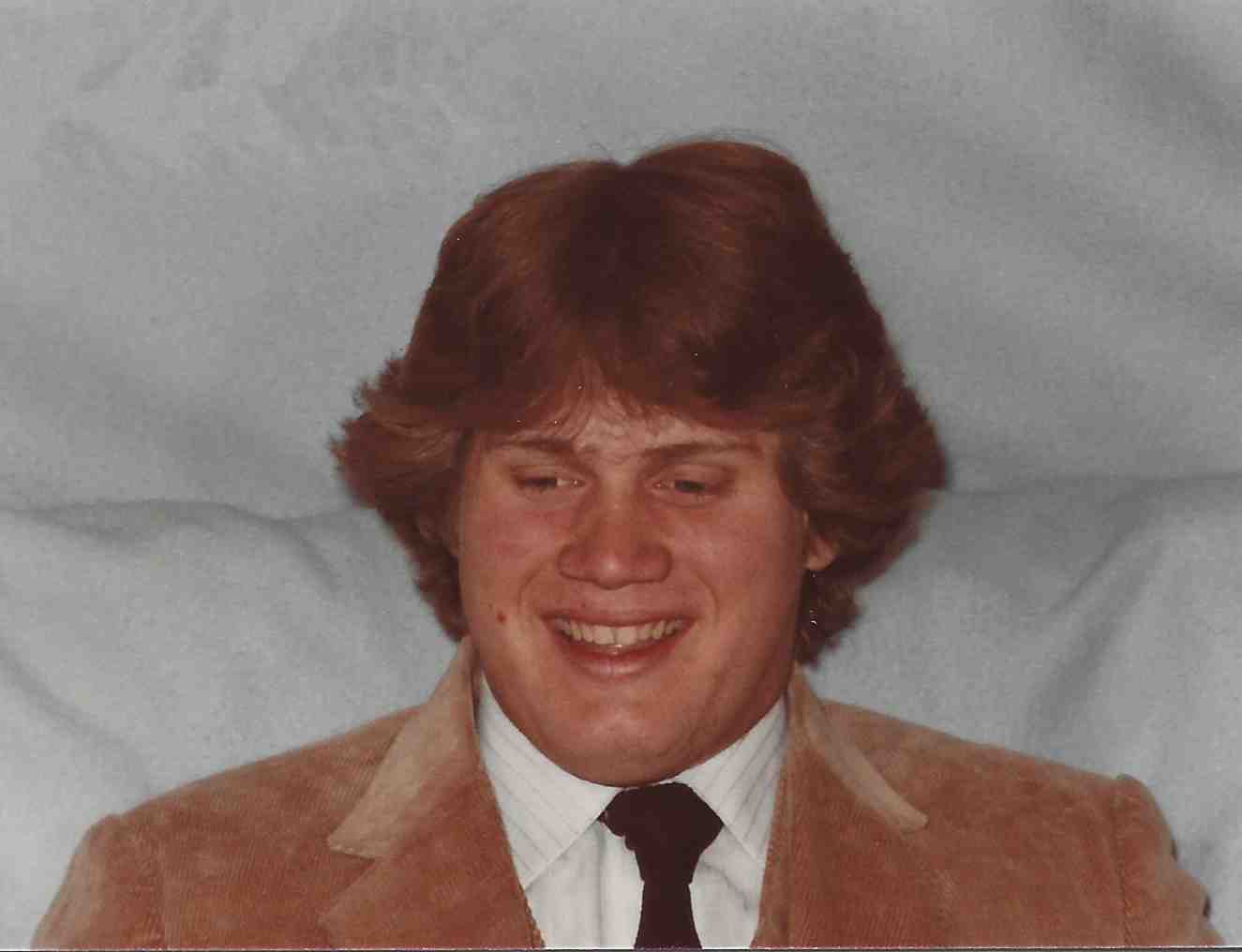
The year Lizzie was born, 1984, which was a good year year for grandchildren.
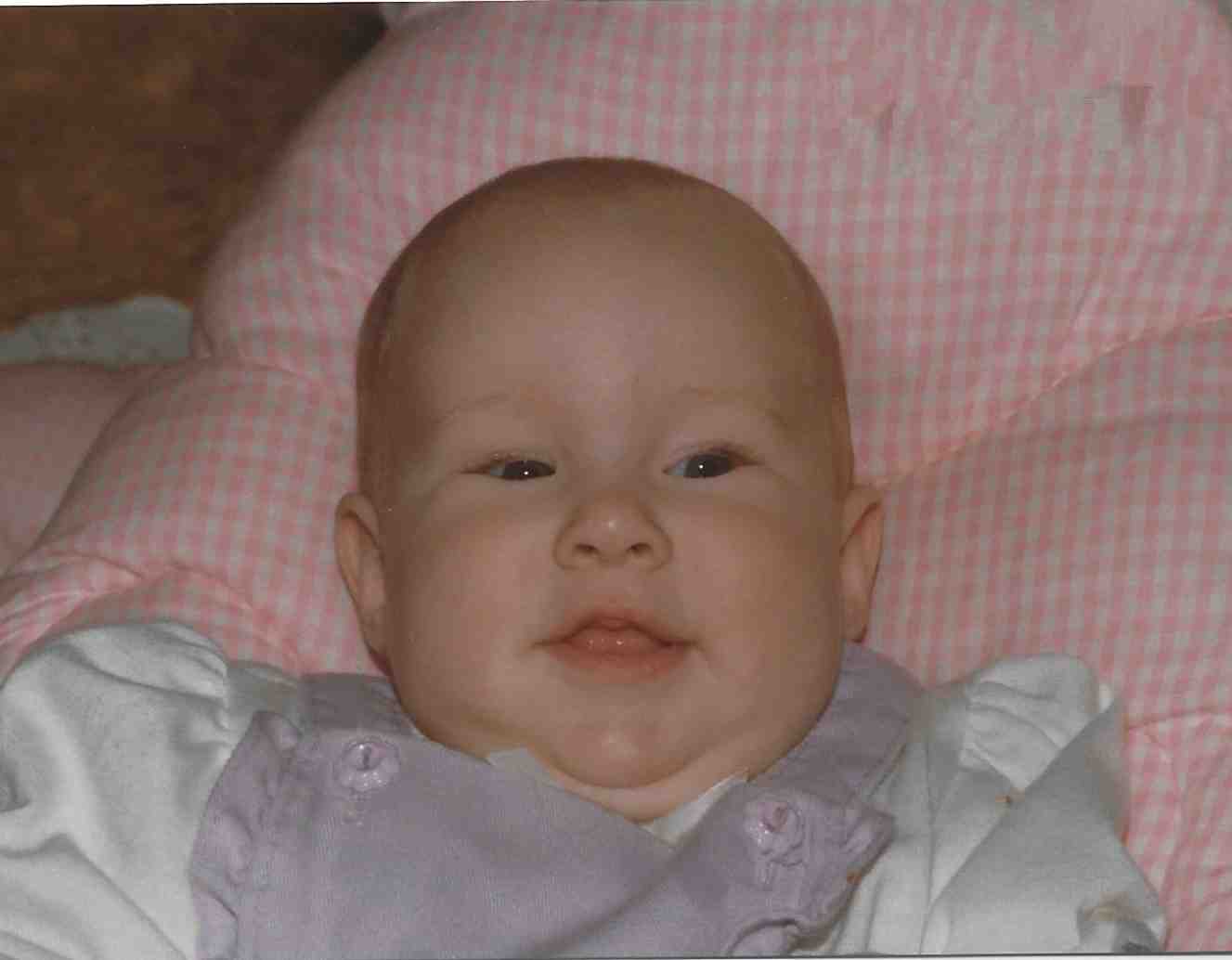
we got two more, Stephen and Jennifer.
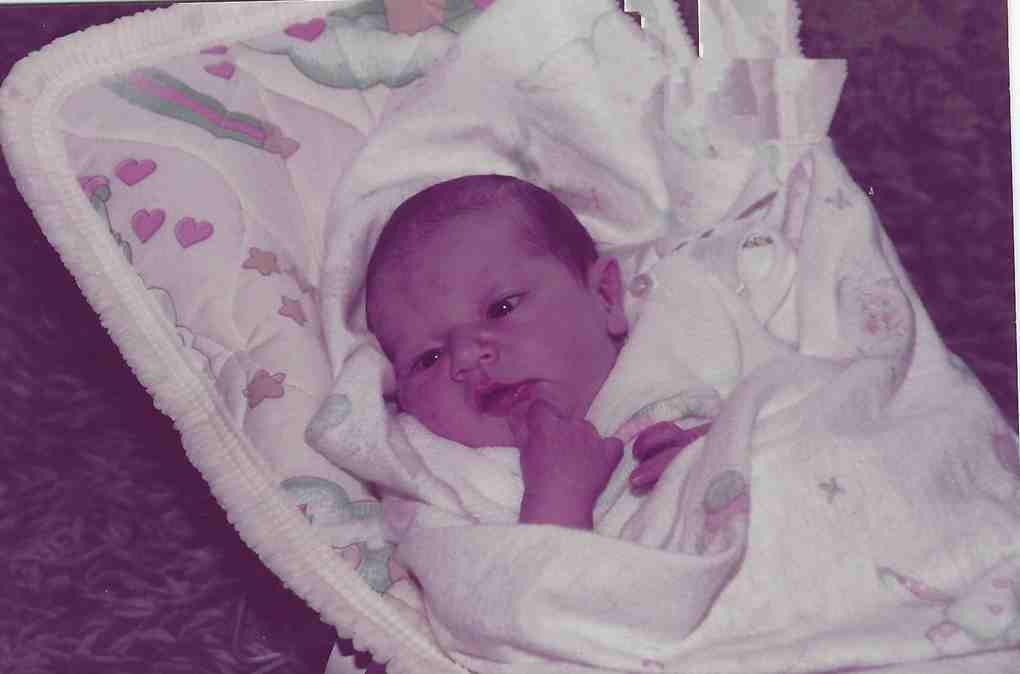
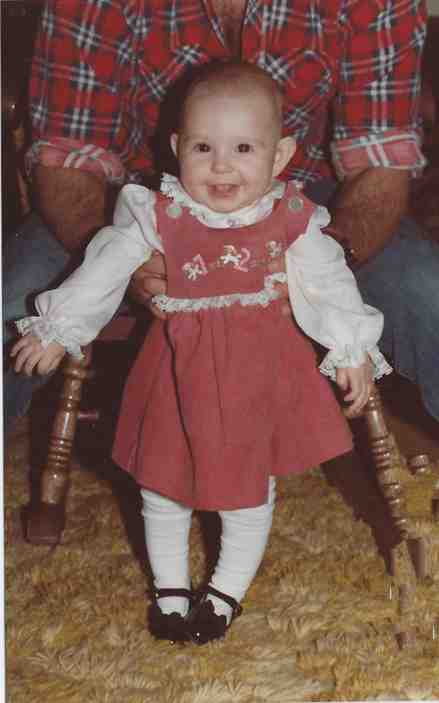
Lizzi was a beautiful baby and little girl. Her grandmother was there when she was born and it was love at first sight.
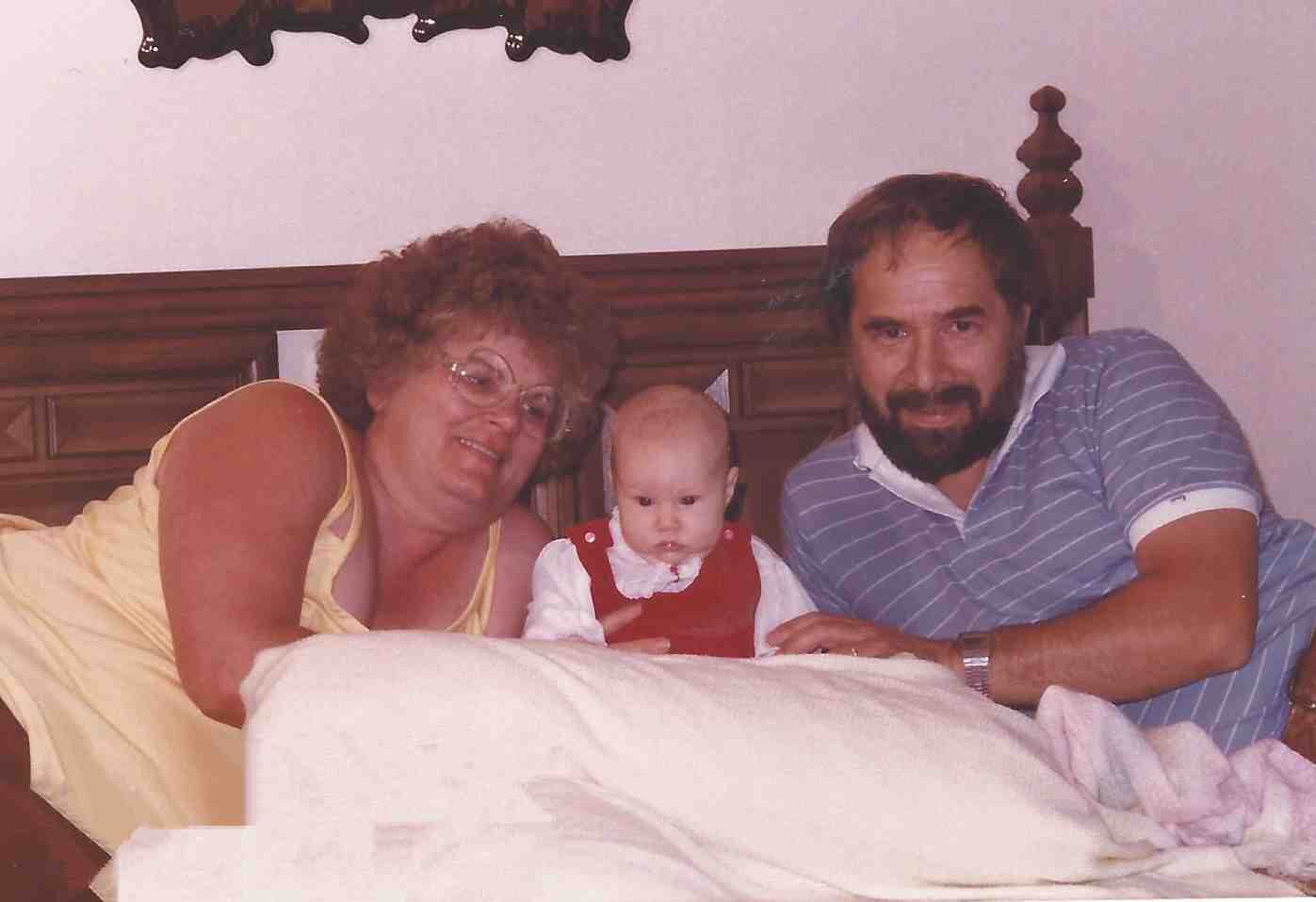
Besides being pretty, Lizzie always was bright and curious and eager to compete. I called her precocious but maybe that was because we both loved naps!
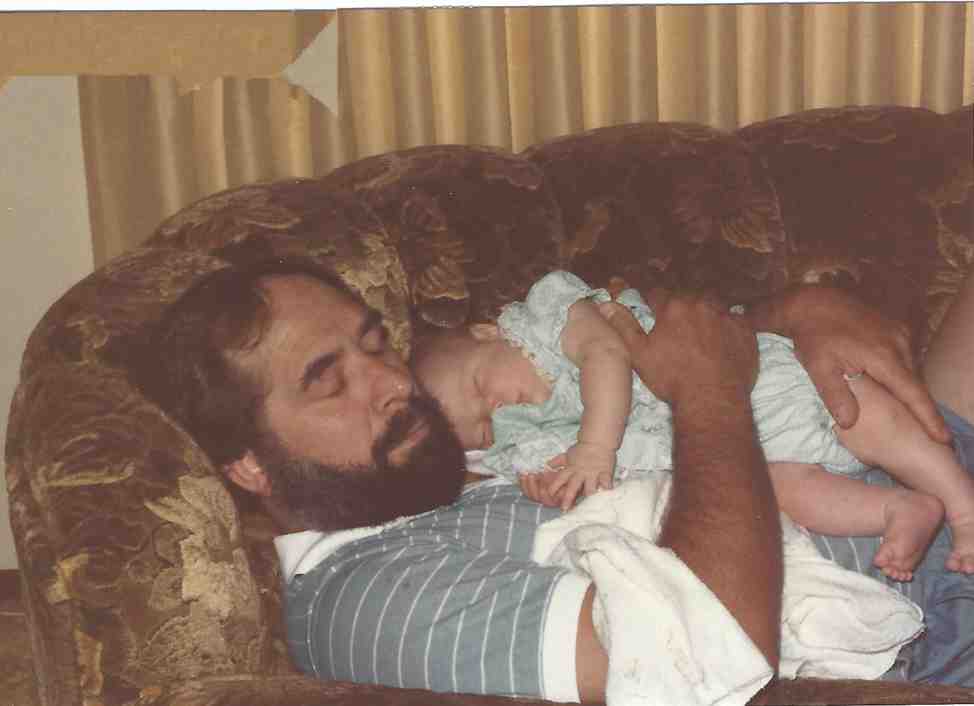
Stephen was born while Mark and Lori were in Cheyenne. He was baptized in the old Church.
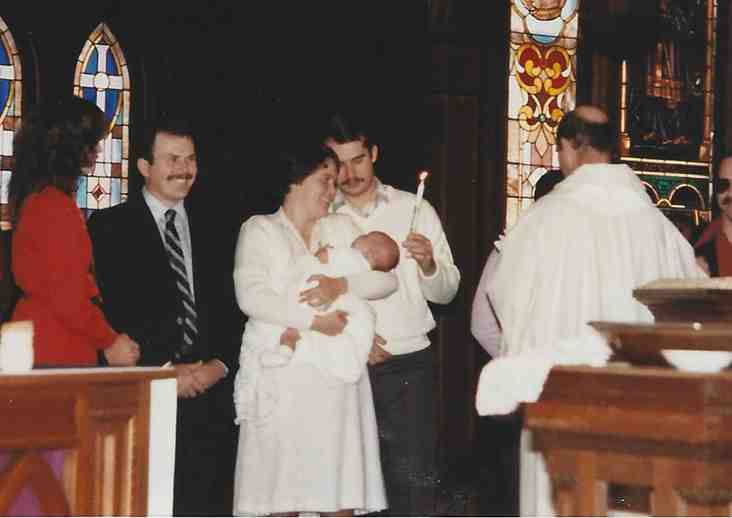
Jennie was born in Misery (or Missouri as the locals like to call it). Matt was in Guam but when he got home, he had a beautiful little girl.
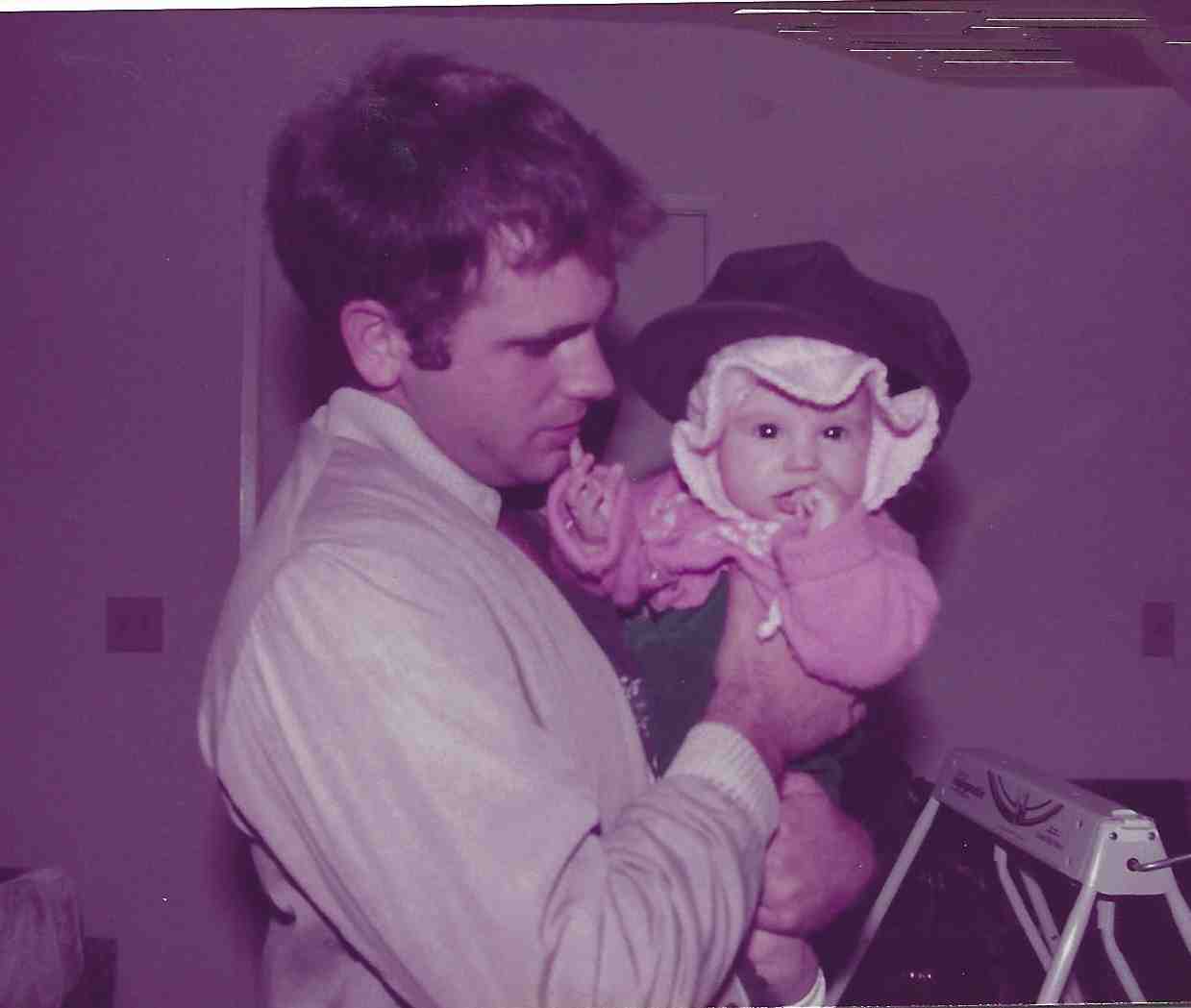
When these three grandchildren were in the early years of school they visited on holidays and birthdays and I used to make up problems and put them on a white board and they would compete to see who could solve it first. Not surprising that Lizzie went into a career that involved solving problems. Luke and Lizzi were both baptized in the old church by Father Dan.
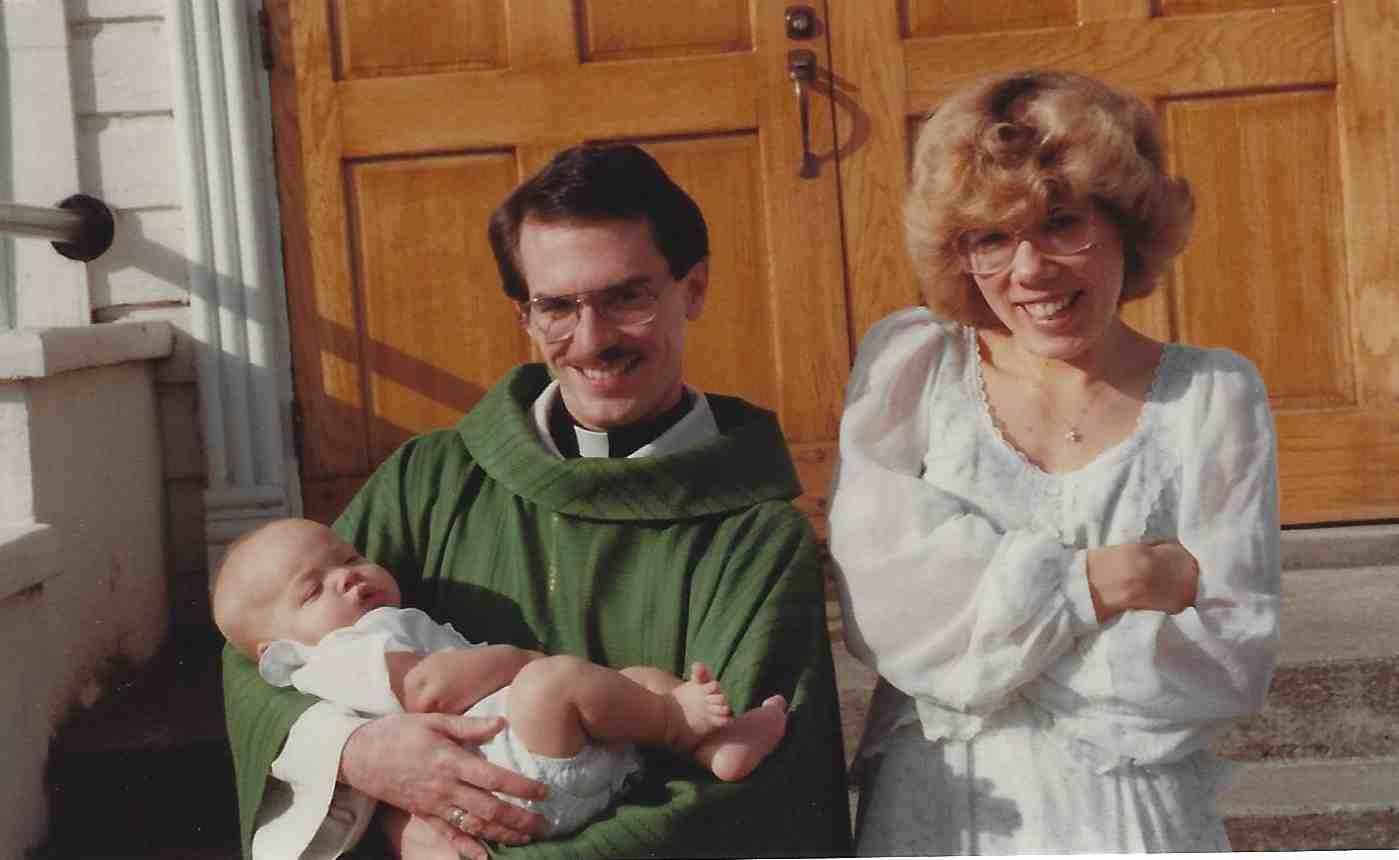
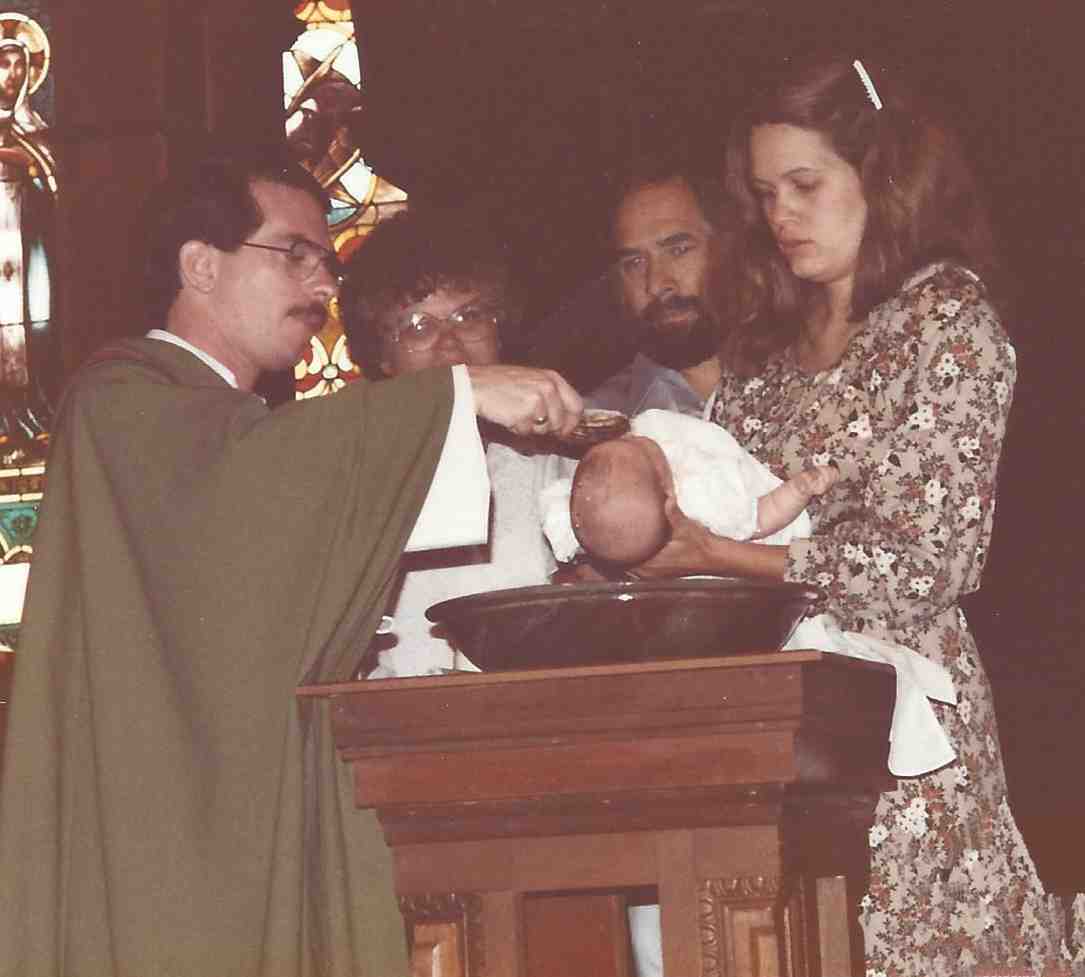
When I was growing up my Mother told me so many critical things about my Aunts Blanche and Dorothy that I disliked them. However, when I was an adult and had a chance to have adult discussions with them, I discovered that the things were false and probably reflected some envy on Mom's part rather than reality. These Aunts were especially good people whom I learned to love and appreciate a lot. It seems some of our grandchildren listened to similar things as teenagers and young adults about Birdie and I but haven't yet matured enough to want to verify the truth on their own. They knew us much better than I knew my Aunts. As a process development engineer I used statistics as a tool for process control and any decent statistician knows that when you have only heard one side of the story, you only know half the story.
It is arbitrary where I separate chapters 7 and 8. However, with the birth of our first four grandchildren occurring in the span of 1982-1984 we entered a new era, being grandparents. And we were only 46!
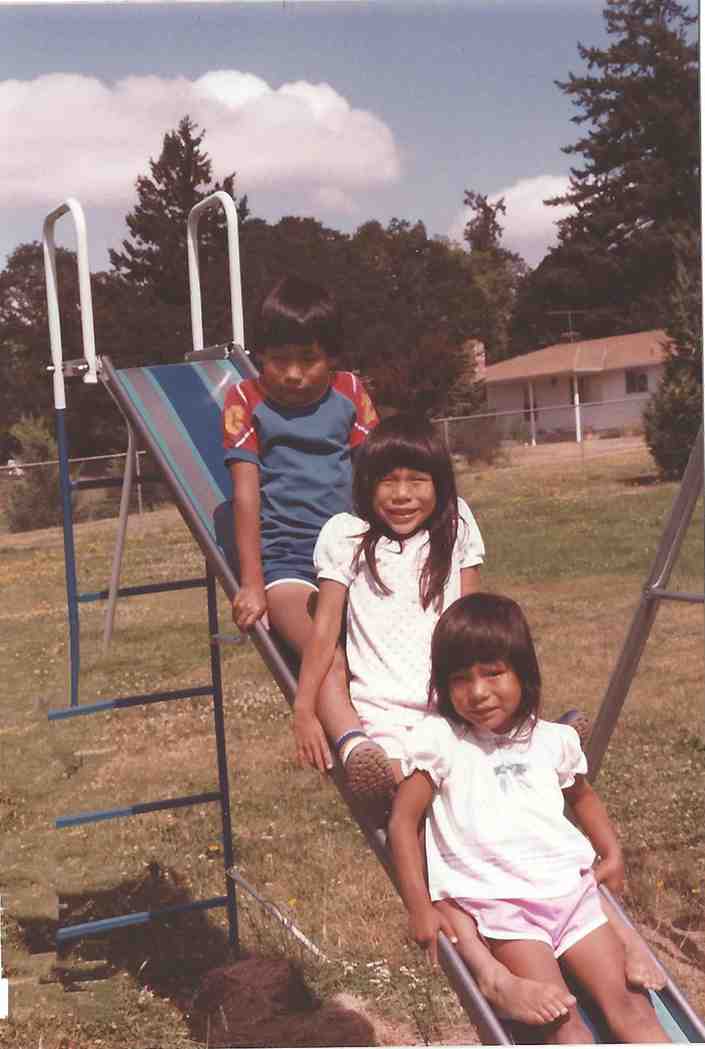
Joe, Gwen and Amanda were growing and settling in the family.
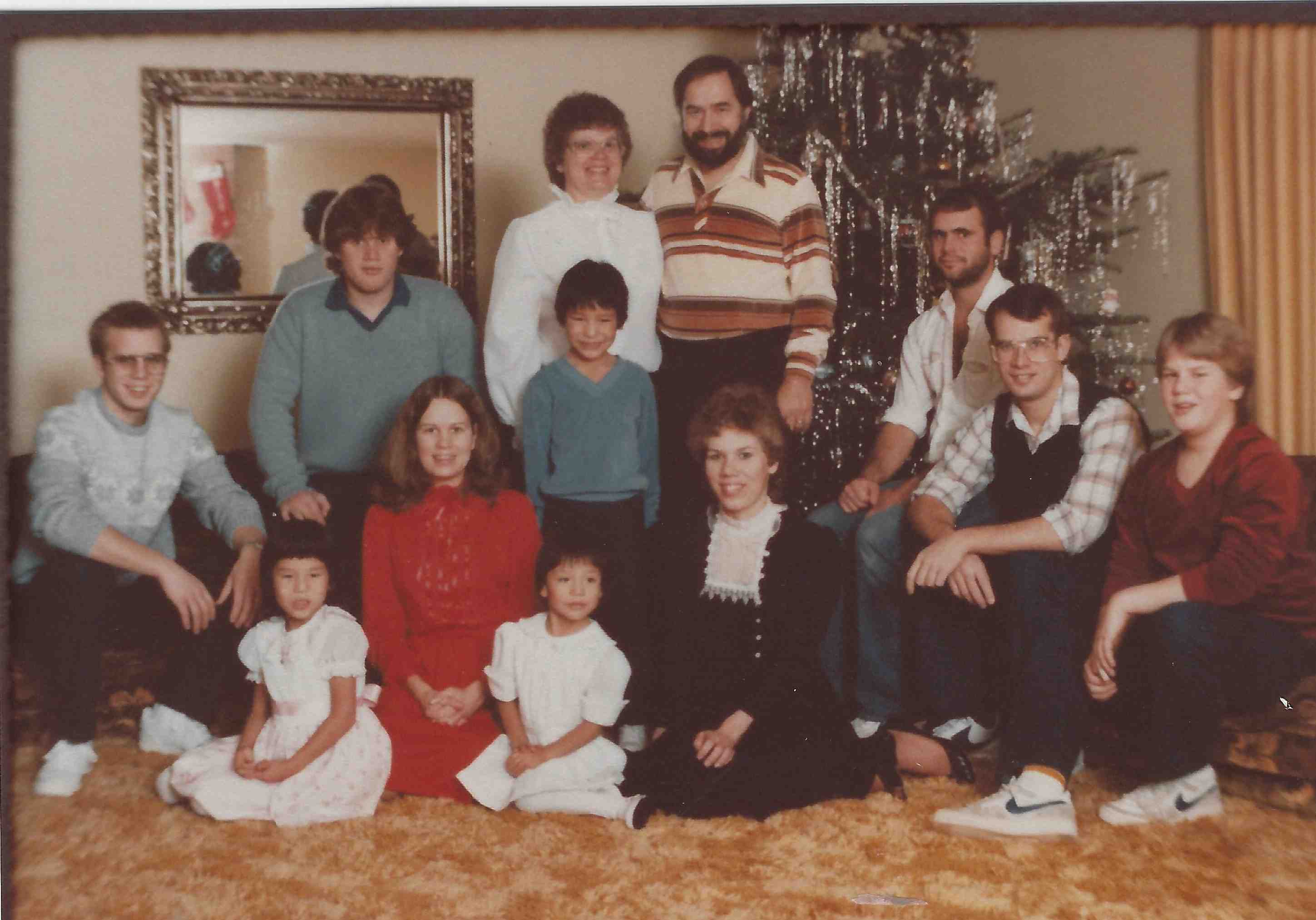
So, we will pick up from here in chapter 8.
LINK TO TABLE OF CONTENTS:
Let Us Learn Table of Contents